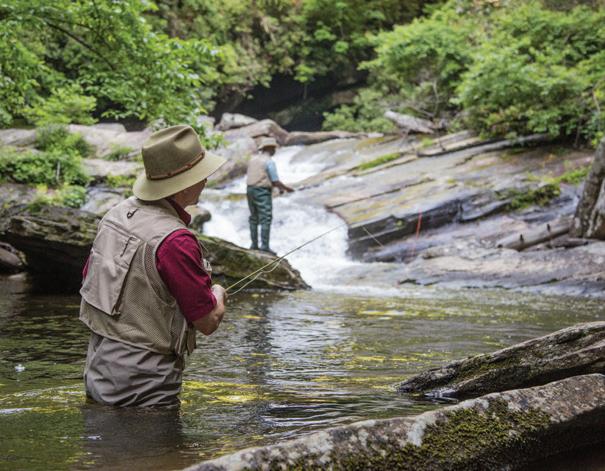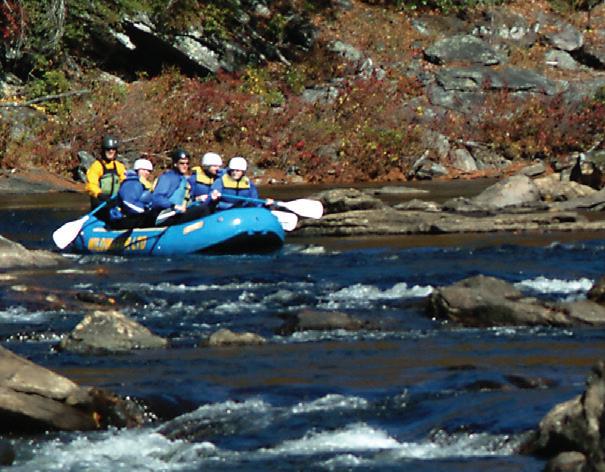



















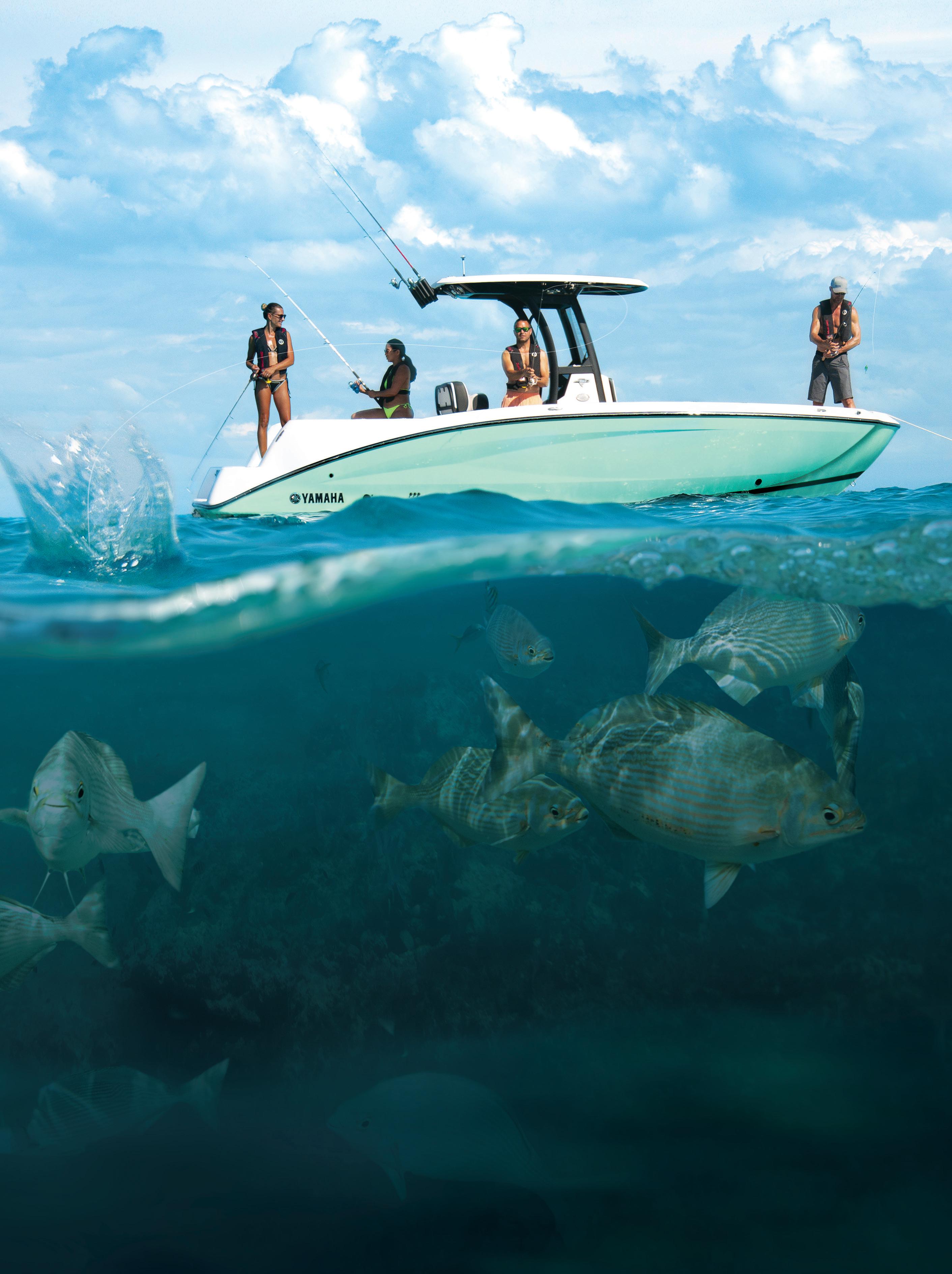








































200-foot-deep structure.

Capt. Rick Croson, of Living Water Guide Service, showed Barefoot this bite for the rst time, and on that trip, they caught African pompano until they were tired of reeling them in as well as amberjack, dolphin and black n tuna. e widely accepted best way to catch African pompano is with a utter jig. However, Barefoot is never content with a tool or technique until he tries to nd a better way to do it.
“ ey are extremely susceptible to utter jigs, but the problem with those is the teaser assist hooks. We kept hooking them on the outside of the face with those wired stinger hooks,” he said. “With their thin, delicate skin, it’s tough to get a hook set. We were losing a lot of sh.”
e technique Barefoot settled on is to use his own 4-ounce Squid Decoy Jigs.
For most anglers, African pompano are welcome bycatch on bottom- shing trips for other species. But restrictive seasons on standard structure-oriented o shore species like grouper and snapper have made African pomps a primary target. In terms of gameness and quality as table fare, some might argue they belonged near the top of the list the whole time.
“ ey shut down grouper shing in January, and I’m not going to stop going o shore, so they’re the next likely candidate,” said Coastal Angler’s own Capt. Tim Barefoot. “ ey pull hard, they bite and they taste great. I’d put them
up in the top ve of my favorite sh to eat.”
African pompano school up on nearshore and o shore structure in late winter and early spring on the Atlantic and Gulf coasts. A couple of years ago, Barefoot was introduced to a ridiculously good bite for 15- to 45-pounders out of Wrightsville Beach, N.C., and what he learned might help you dial in the bite where you sh.
Cold water consolidates African Pompano to their comfort zone this time of year, and out of Wrightsville Beach anglers nd the magic 65- to 67-degree temps 45 to 60 miles out on 120- to
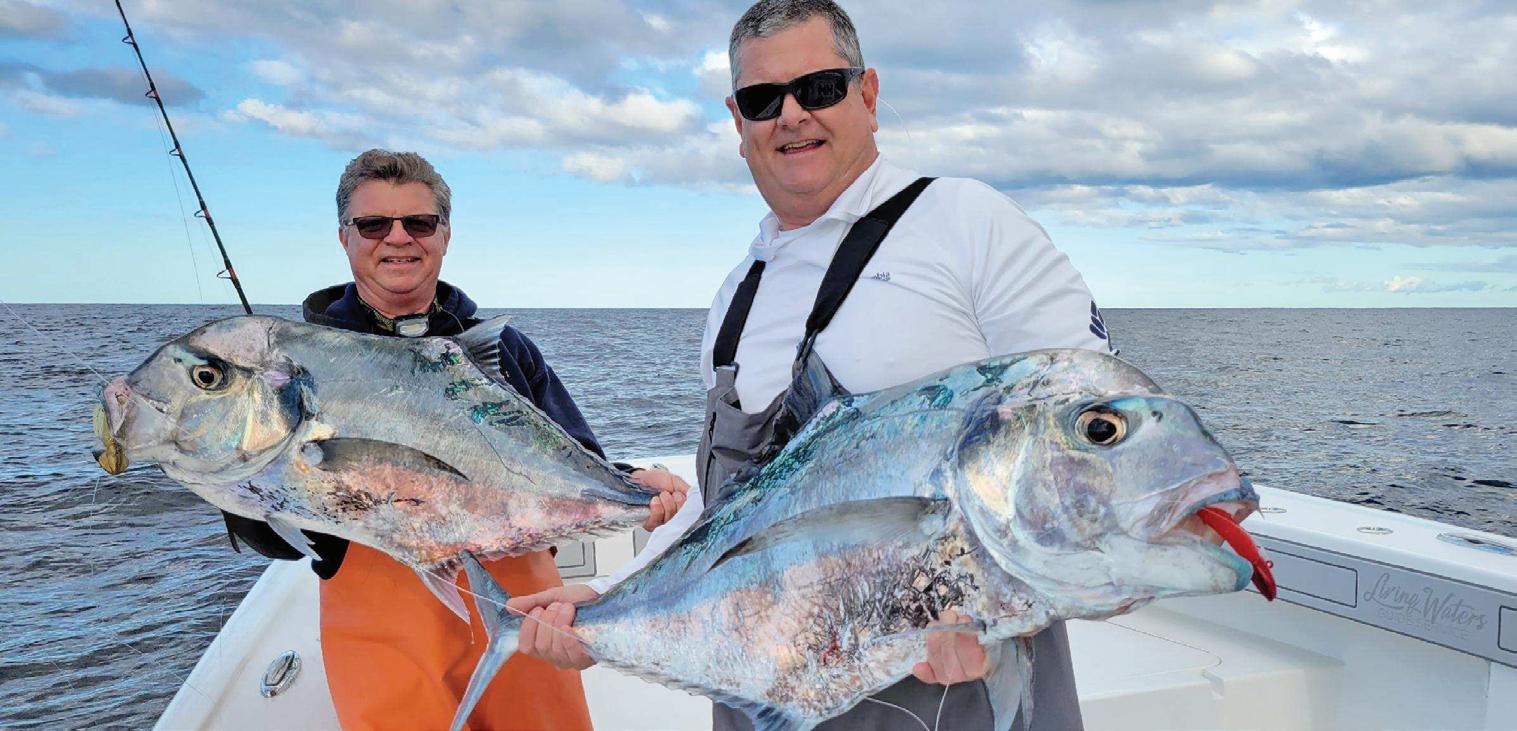
“African pompano are very close to the bottom,” he said. “We drop that squid down to the bottom and pull it up just a few feet. Sometimes you can just set it in the rod holder and wait for it to get slammed. Sometimes you might want to give some action, but don’t overdo it. Squid are their primary food source. When they see it, they’re not shopping… they’re buying.”
Barefoot uses 40-pound braid to an 80-pound uorocarbon leader. He ties on his jig with a loop knot. e thing about squid is sh always attack them from behind to disable their beak. Barefoot said sh take the squid jig deep, and the result is a solid hook set in the mouth.
Find Capt. Rick Croson at livingwatersoutdoor.com and check out the Squid Decoy Jig at barefootcatsandtackle.com.
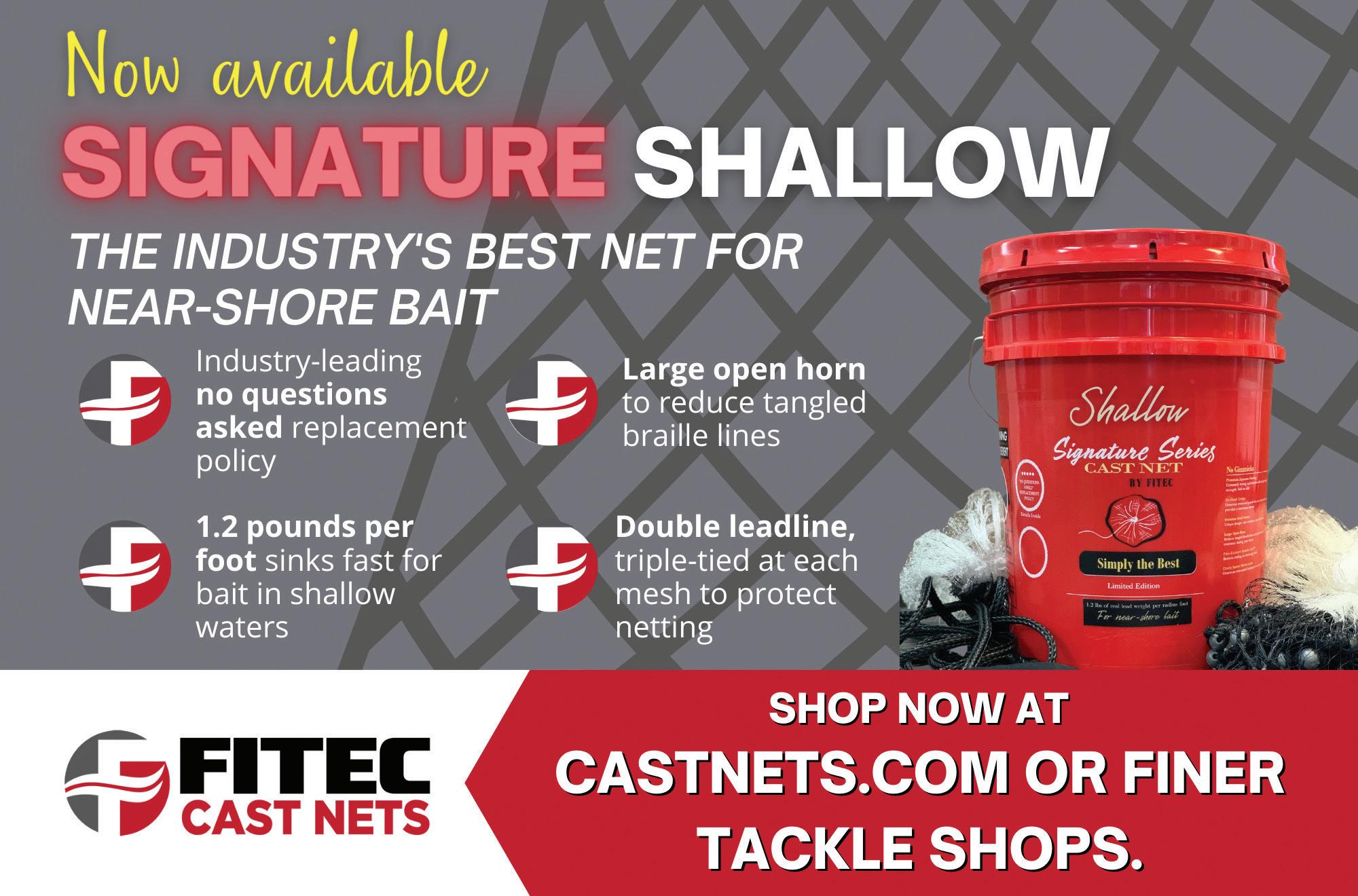
With big trout on my mind, I hooked up the boat and headed to deep south Texas. An approaching cold front was going to shorten my trip to a single day, but I felt con dent it would be worth the 5-hour drive. As the cold front swept across north Texas, my anticipation was high as I headed south to warmer temperatures and extra hours before the frigid air and high-powered north wind turned a nice winter’s day into artic conditions. e morning greeted me with calm winds and dense fog, which is not typical south Texas

weather 14 hours prior to the strongest cold front of the year. e norm is 25 knots from the south or southeast with a storm of this magnitude on the doorstep.
I headed to my pre-determined location at a safe speed considering the conditions. I was in no hurry, as the prime bite was not until 10 a.m. e forecast was sunny, calm and 70 degrees for the day, followed by north at 35 knots and a low of 28 the next morning. I was certain the approaching weather would have the bite red up, and it did not disappoint. e sh didn’t feed on everything
I tied on, but once I homed in on what they wanted it was nonstop!
I pulled up to a favorite cove, positioned the boat well outside the prime area and quietly slipped into air-clear, knee-deep water of the grass at. I had a 5-inch paddletail ready at the end of my rod. A er covering the prime area with only one follow by a small red, it was time to change. I downsized to a 3.25-inch paddletail with a light purple back and a pearl belly. As I looked up a er rigging my lure, I spotted a huge trout about 5 yards in front of me. She was there for several seconds and then slowly disappeared. I knew she was aware of my presence even though she didn’t spook, and I didn’t have high hopes of catching her, but I did try. I was excited knowing my plan had me in the area of the trophy-size trout I was targeting.
I noticed nervous mullet about 40 yards away and slowly made my way in that direction. It was nonstop action on reds in the 26-inch range, and I caught one 3-pound trout. ese sh were a little deeper in thigh-deep, crystal-clear water over grass and potholes.
roughout the day, I tossed three sizes of similar body-style paddletails, all with built-in tail rattles. e smallest, a 3.25-inch lure, was the only one that caught sh. I used three di erent colors, so it was only the size that mattered on this day under pre-front conditions. Although I did not land the big trout I was targeting, I am satis ed that I was in the right place and will go back soon.
Capt. Michael Okruhlik is the inventor of Knockin Tail Lures®, and the owner of www.MyCoastOutdoors.com.
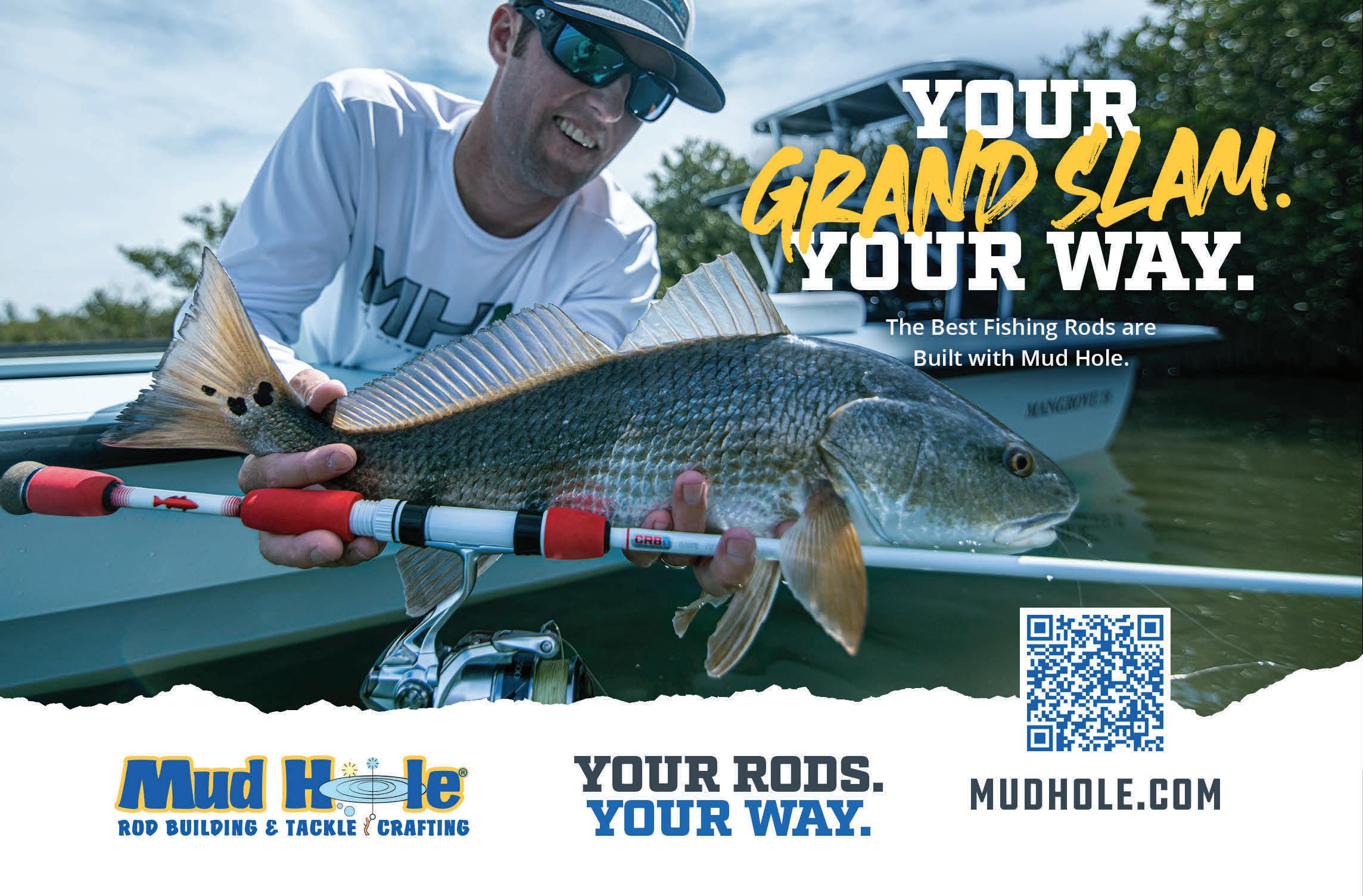
Some years ago, my girlfriend and I visited the Southwest town of Sedona. It’s a wonderful place. While jewelry stores, art galleries and upscale boutiques have crept into Sedona’s downtown, the air still maintains an electric charge. In one of these Sedona stores I acquired a Bowie knife that soon proved well worth the sticker price.
Disappearing into the stunning red rock formations that Sedona is known for, my girlfriend and I set out to hike Bell Rock, a butte just south of that famous desert town. We couldn’t have been happier.
Our happiness didn’t last long. Before we knew it, we stumbled upon a rather nasty diamondback rattlesnake. Acting quickly, I pulled my Bowie knife out of its holster and gave Mr. Snake a quick shave. We were lucky. Not only did my skill with a knife ensure our safety, but I had the makings for a new rattlesnake belt.

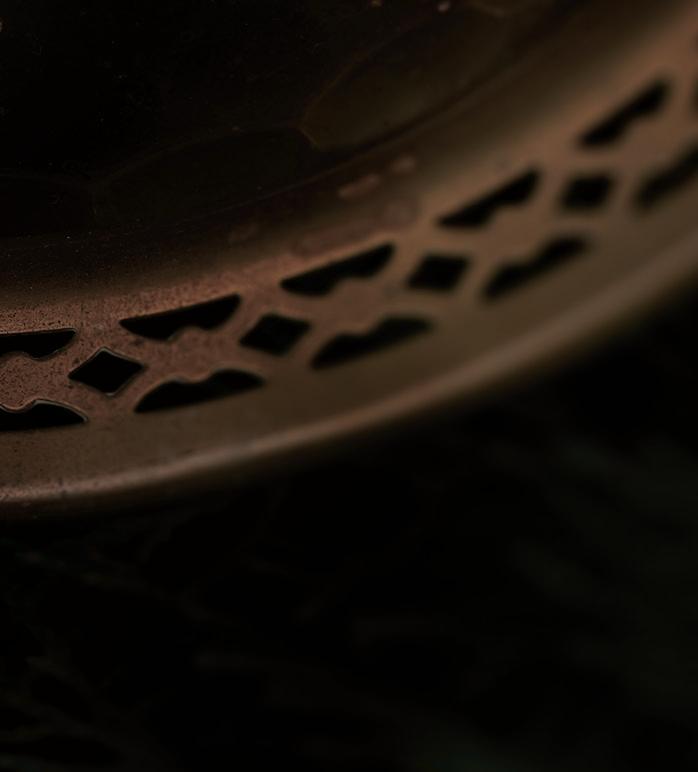

The next time something slithers too close, make sure you’re prepared with the Diamondback Bowie Knife. This 12" knife comes with a high quality 420 surgical grade stainless steel blade. The handle is made of genuine natural bone that’s been hand carved in the pattern of a diamondback. Completed with brass handguards, spacers and end cap and accessorized with a genuine leather tooled sheath, this is one blade a mamba won’t want to mambo with.





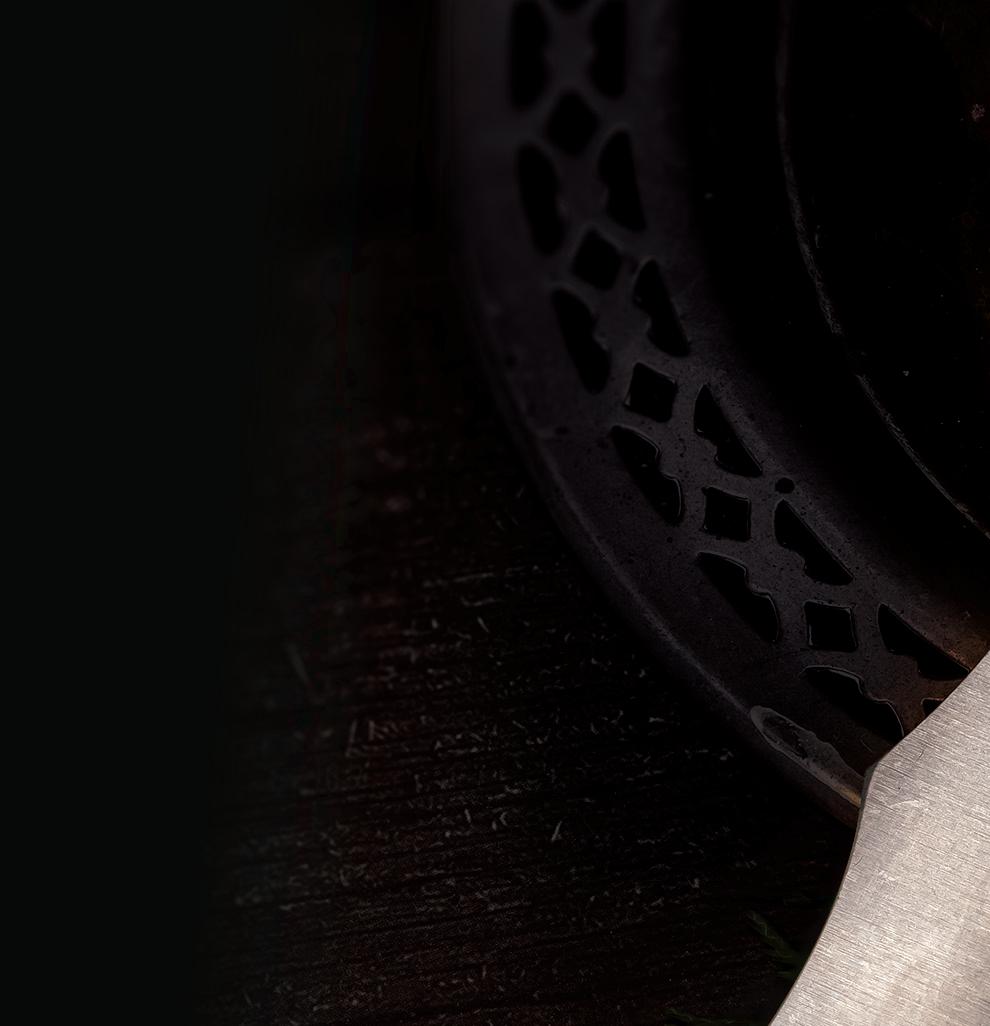


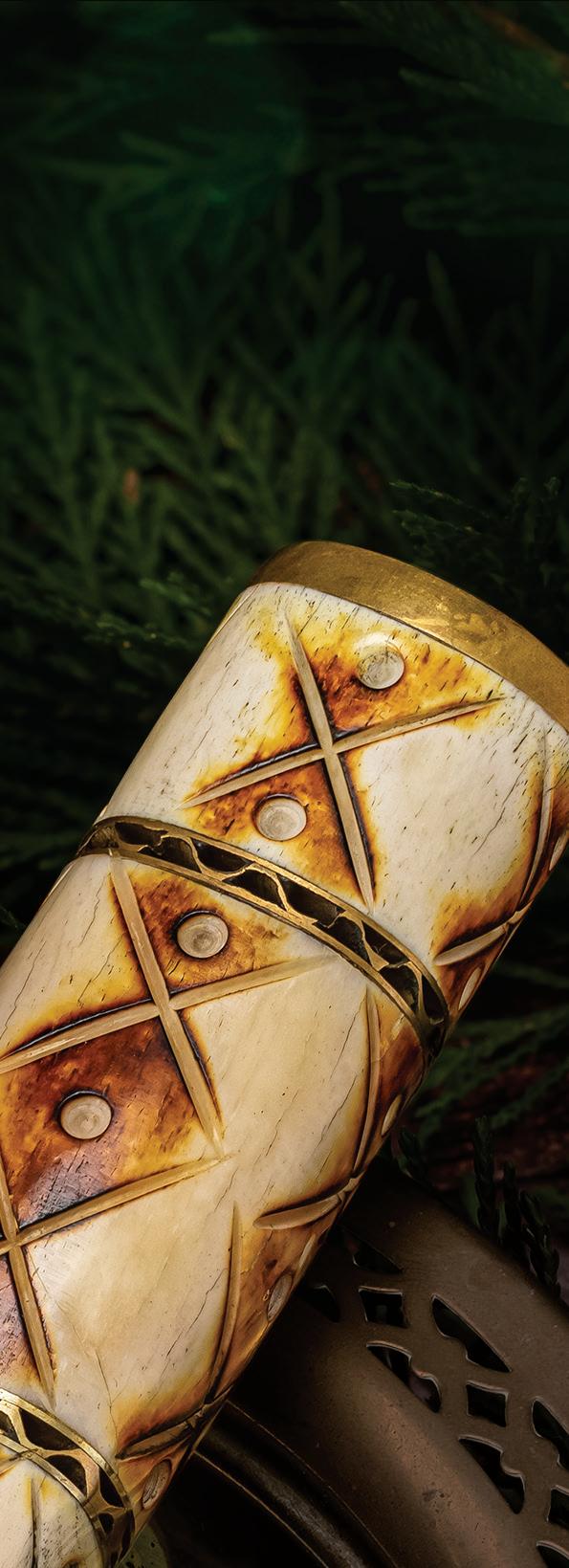
What’s more, while supplies last, we’ll include a pair of $99 8x21 power compact binoculars FREE when you purchase the Diamondback Bowie Knife. Simply put, this offer is an incredible bang for your buck. Act now: We only have 271 knives left for this ad! For your next adventure, don’t rely on some wimpy pocketknife to protect you from danger. Get the Diamondback Bowie Knife and come away with a story instead of becoming a snack.


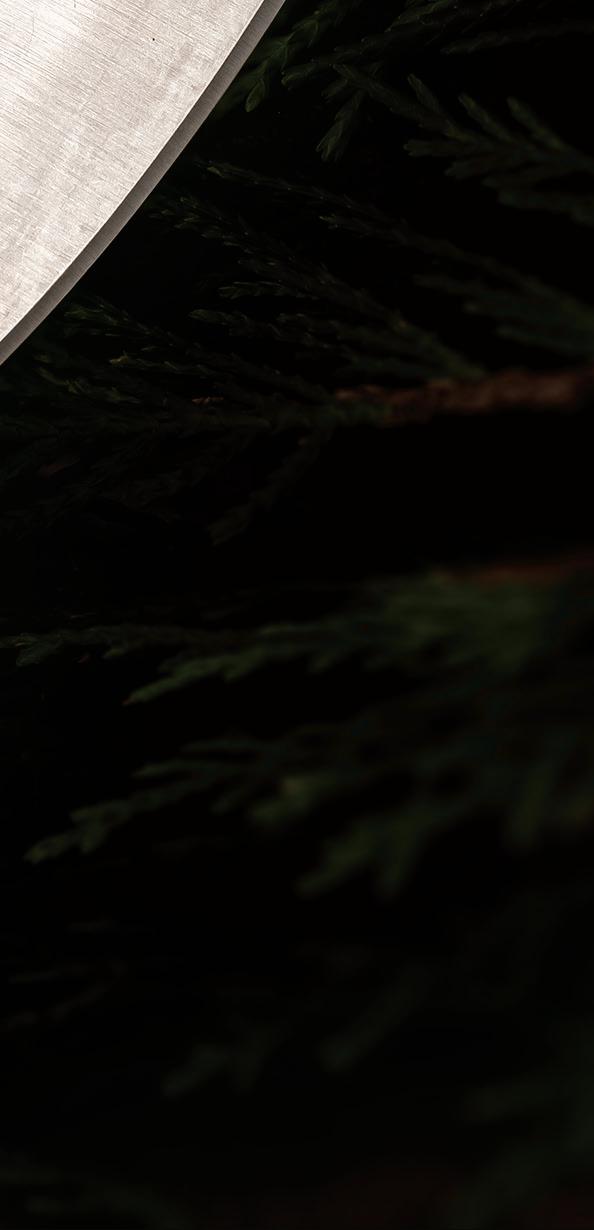

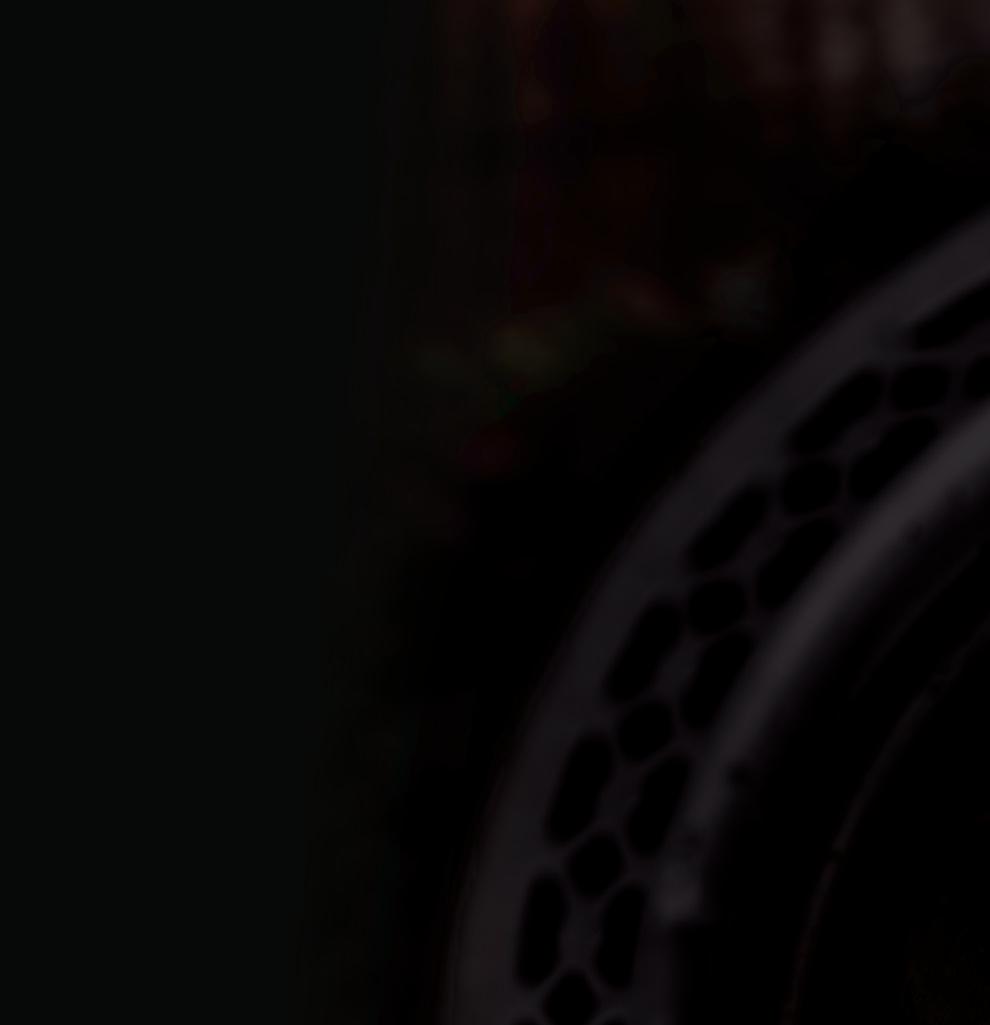

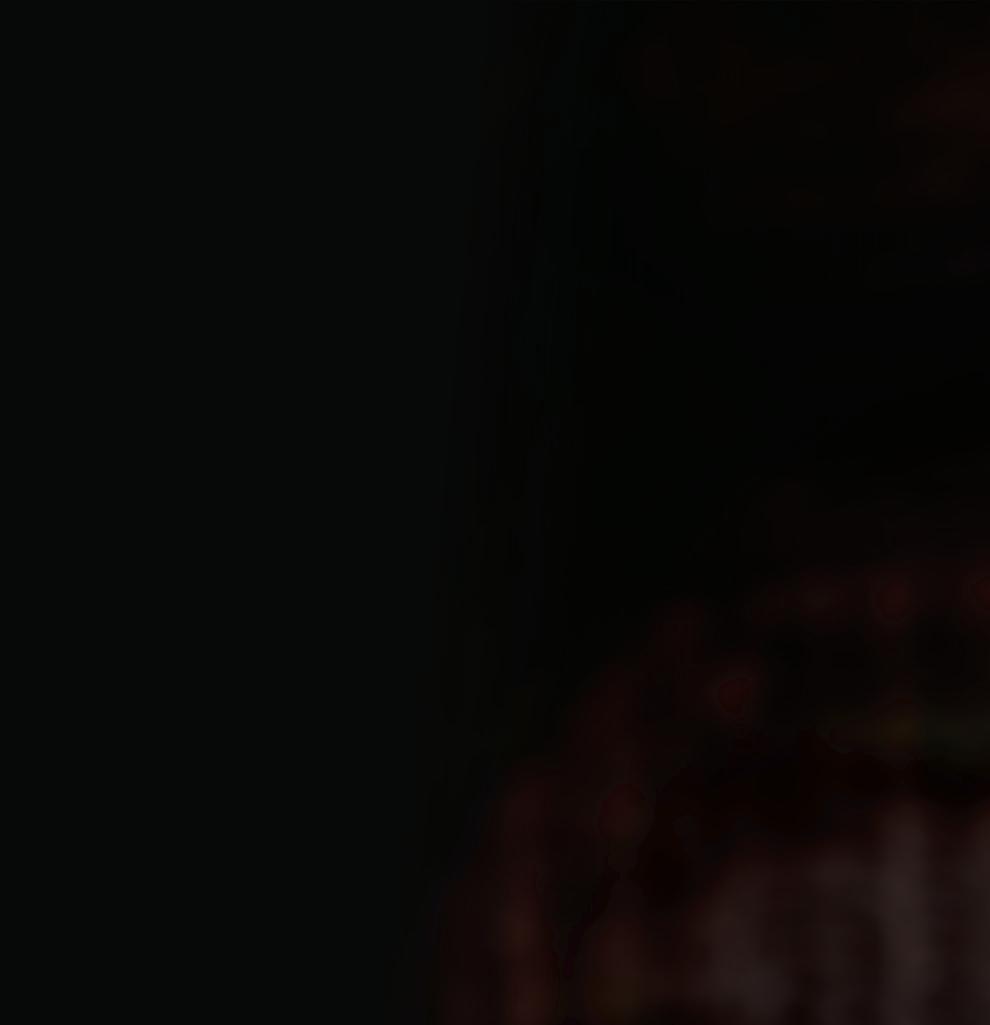
Asingle-handed y rod, which you might refer to as a “normal” y rod, is the tool of choice for most anglers seeking trout or other species on our inland rivers. But I’m here to tell you there’s a revolution building steam. Don’t be surprised when someone on your local river shows up wielding a two-handed spey rod. ese long rods are gaining popularity because they o er certain advantages.
For centuries, two-handed spey gear has been used only in pursuit of big anadromous sh such as salmon or steelhead on the huge coastal rivers of many continents. However, in the last decade or so, micro or trout spey rods have found their way into the hands of anglers. is smaller trout-sized spey gear opens the door for shing areas and for species that inhabit some of our beloved rivers and mediumsized streams.
If it lives in moving water, it can be caught with spey gear. Trout, of course, are the main quarry, but other sh such as smallmouth, spotted bass, largemouth, white bass and stripers are also fair game. Smaller-sized spey rods in 4-, 3-, or even 2-weight sizes are extremely e ective tools for reaching sh in big water with dicey wading areas.

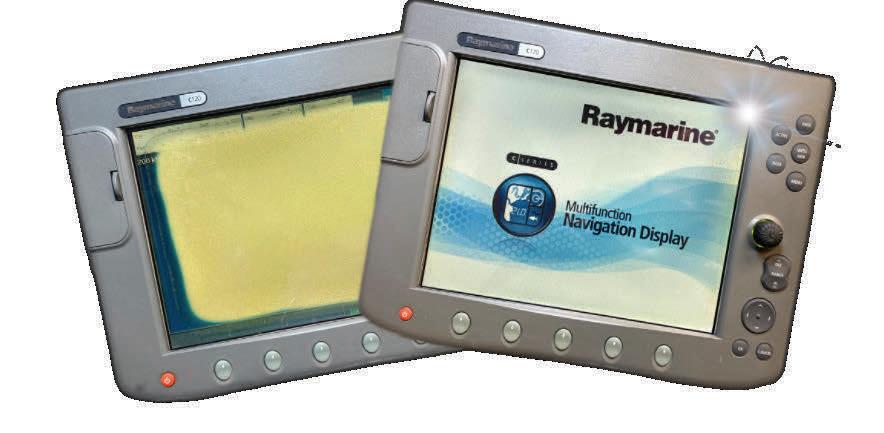
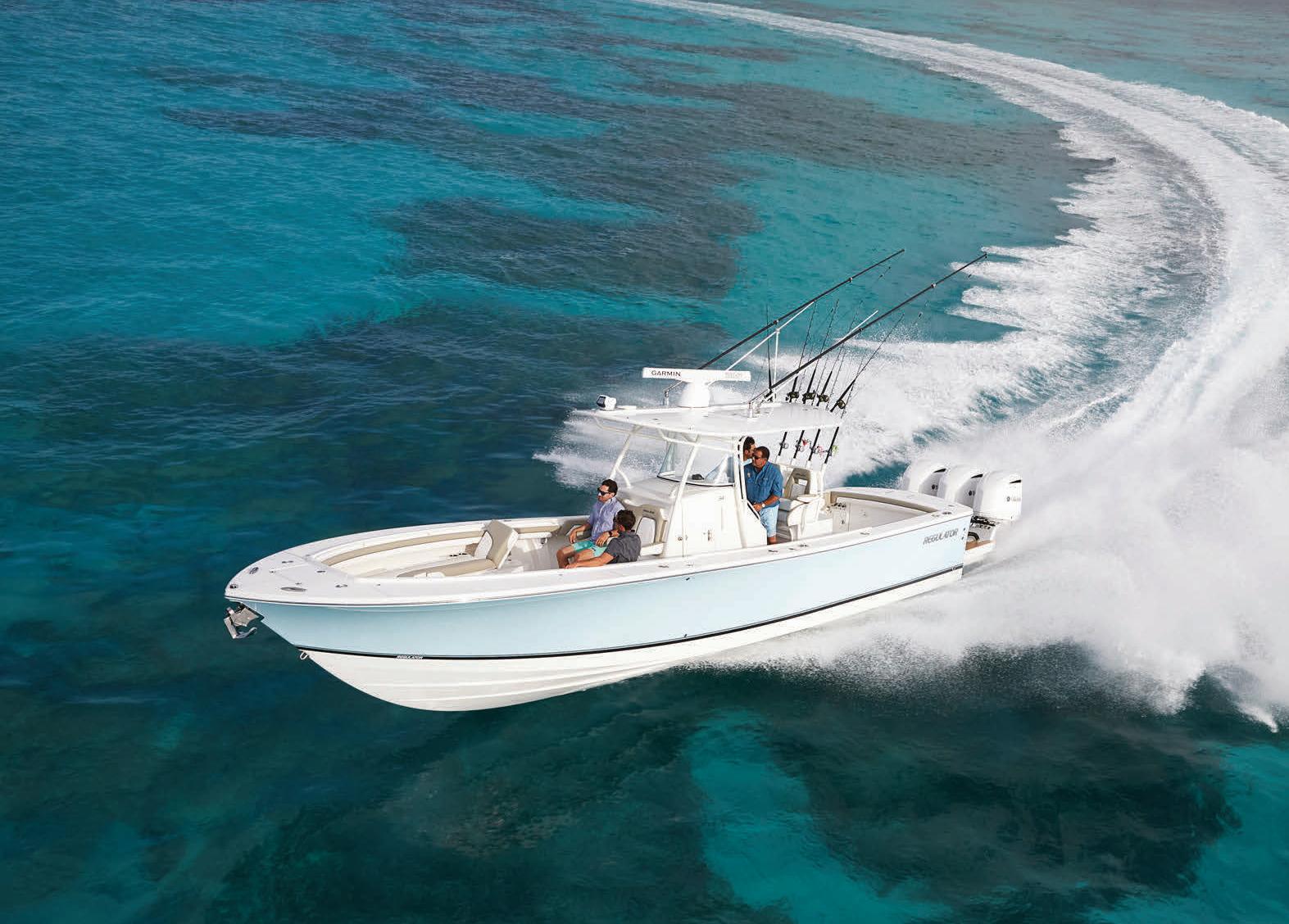
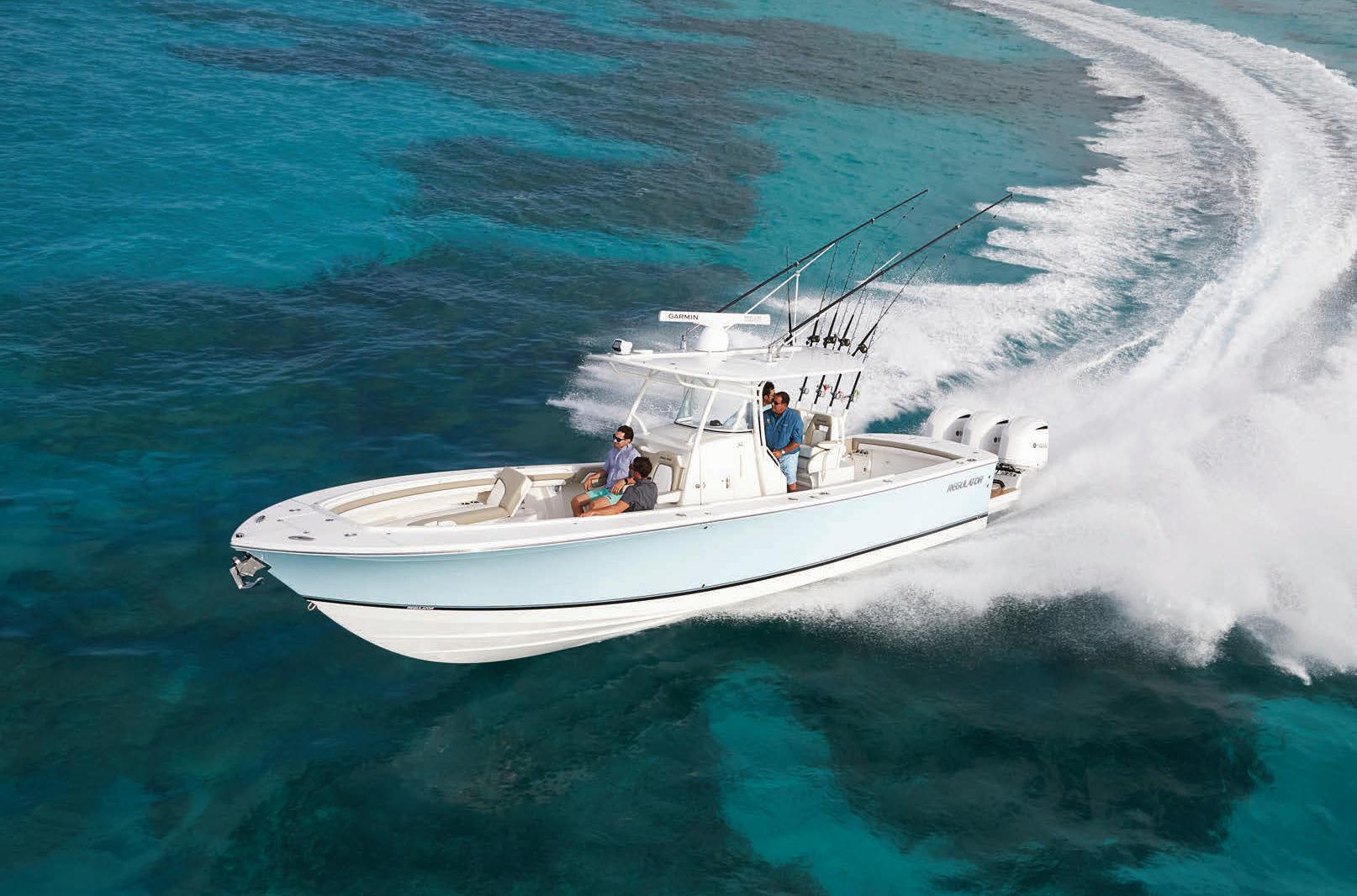

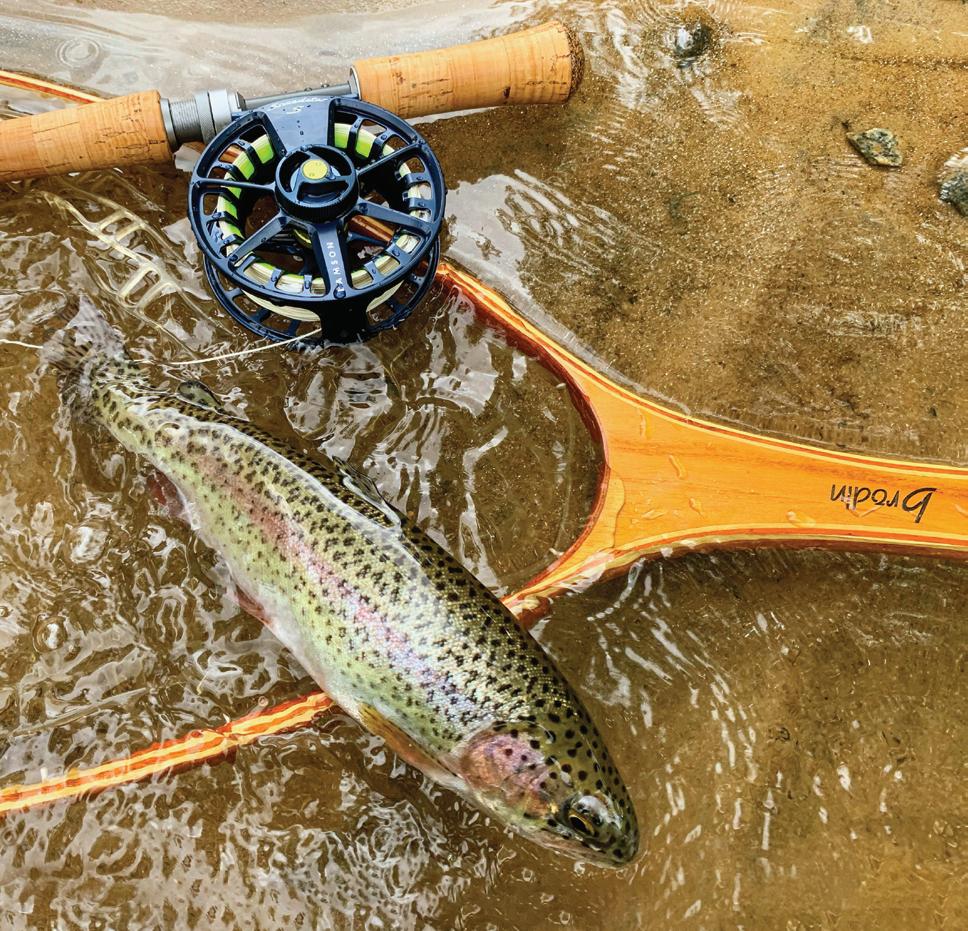
Besides being loads of fun to sh and cast, a spey rod is designed to launch ies into the next county with little or no back-cast room available. Most troutsized spey rods are less than 12 feet long, with longer rods up to 16 feet reserved for big steelhead or salmon. A 2-weight spey rod is similar to casting a 4- or 5-weight single-hand y rod. A 3-weight spey rod can handle ies in sizes that a 5- or 6-weight single-hand can cast, and so on.
Here’s the main advantage of two-handed gear: Easy casts of 70 or more
















feet can be launched from positions that are impossible with a single-hand y rod. Right now, the wheels in your head should be turning about places on your home river you have always wanted to run a y through but couldn’t reach.
Fishing is done down and across current to carefully swing ies through likely runs or holes, and the angler waits for the electric jolt of a trout or bass. Flies imitating bait sh, emerging insects, and even brightly colored Atlantic salmon or steelhead ies in smaller sizes are readily taken by sh. A well-tied y sweeping in front of a predator can draw a hunger reaction or a re ex strike in almost any condition.
Casting and shing micro spey gear is extremely fun and e ective. I hope you will join the trout spey revolution!




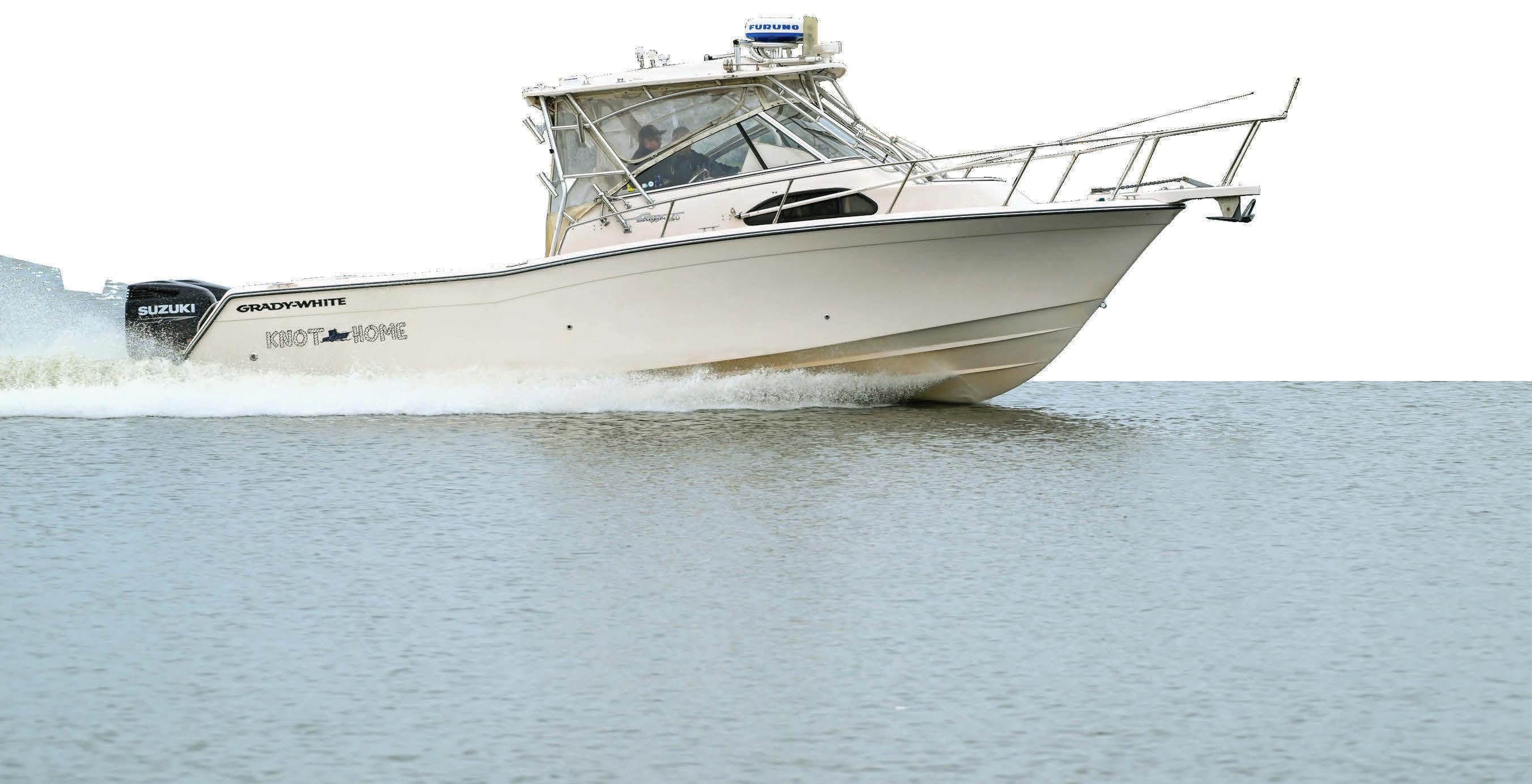




















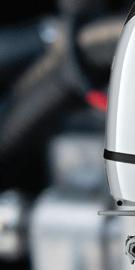

 By CAM Sta
By CAM Sta

The Bassmaster Elite Series opens its 2023 season Feb. 16-19 with a stop at Lake Okeechobee. It’s the rst time since 2017 that B.A.S.S.’s top pros have competed at the “Big O,” and depending on the weather, most pundits are predicting heavy sacks from some of the world’s best bass anglers.
Last time Elite Series anglers descended on Florida’s largest lake in 2017, they also shed in late February. A monster 9-pounder turned heads as the big sh of the tournament. Alabama pro Tim Horton topped the eld with a four-day total of 83 pounds, 5 ounces. at’s a better-than 20-pounds-per-day average, which is strong for any shery, but it’s not as good as it gets for this historic big-bass factory.
Back in December, locals Jerod Boltz and Jon Bowman secured the 2022 Roland Martin Marine Center Series Championship with an awesome, nearly 30-pound nal day on Dec. 11. eir big sh of the day was an 8.15-pound Okeechobee giant. ey caught most of their sh on chatterbaits, an Okeechobee favorite, and spent some time shing speed worms and ipping cattails.
With two months separating the Roland Martin event from the Elite Series event, there’s no doubt some things will change, but Florida’s mild winters mean some things will likely remain the same. Okeechobee is typically primed for big sh in the month of February, and there might be some bed shing going on. “Big O” bass will likely be up shallow in all stages of the spawn.
As with any shery, weather patterns have a way of ruining the best laid plans. February fronts from the north are notorious for shutting down hot Florida bass bites in a hurry. Last February, Coastal Angler contributor Capt. Angie Douthit reported consistent action with spinnerbaits, worms and chatterbaits, and said they were also catching sh ipping and pitching.
For more information, go to www.bassmaster.com.


Technical schools charge tens-of-thousands in tuition. With the Mastry Suzuki RePower TTP (Technician Training Program), you will work with and learn from factory certified technicians and participating in the Suzuki on-line training course all while earning an hourly wage. After completing the Suzuki on-line training course and earning your Suzuki Certification you will be eligible for the Mastry Suzuki RePower Tenured Technicians Bonus Program.



Suzuki RePower Tenured Technicians $1-Grand-A-Month

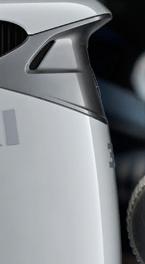






After joining a Mastry Suzuki RePower Center as a certified technician, every month you will accrue $1,000 in bonus opportunity. After one full year of service you will be tenured and eligible to receive all 12 months of accrued bonuses, or $12,000. As a Mastry Suzuki RePower Tenured Technician along with your regular pay, each month you will be eligible for a $1,000 additional bonus.




At every Mastry Suzuki RePower Center, Certified Technicians are held in the highest regard. Join a passionate team of professionals with the common goal of excellence through constant improvement. With 12 locations across Florida there is a Mastry Suzuki RePower Center near you that wants to appreciate you and your abilities.

Mastry Engine Center
Clearwater, Florida 800-545-4574
Twin Screws Marine Fort Myers, Florida 239-330-3387

Innovation Marine Corp. Sarasota, Florida 941-355-7852
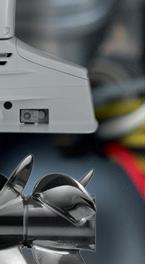



Marina One Deerfield Beach, Florida 954-421-2500
Bayfront Yacht Works Sarasota, Florida 941-349-9449
On Site Marine Ruskin, Florida 813-727-5403
Boat Services Group Key West, Florida 305-320-0555
McKenzie Marine St. Augustine, FL 32084 904-770-2488

Lou’s Marine, Inc. Gulf Breeze, Florida 850-932-0701
Atlantic Marine Store Hialeah, Florida 305-826-2202
Custom Marine Service Panama City, FL 850-872-9191


Oyster City Suzuki Apalachicola, Florida 850-653-8030

over to the other side of their head and they spend the rest of their lives looking up with one side of their body at on the bottom. ere are several species of ounder with overlapping ranges. Summer ounder are what northern anglers call ukes, their range in the Atlantic stretches from Nova Scotia down to Florida. Southern ounder inhabit the Atlantic coast as well as the Gulf of Mexico, while Gulf ounder can be found in the Gulf of Mexico from Florida to Texas. Southern ounder can be identi ed by their white underbelly and an absence of the ocellated spots the other two species have. ese spots resemble eyes, which are thought to trick predators. For southern ounder, males don’t grow much longer than 12 inches, while females can reach about 25 inches.
Southern ounder range from North Carolina to Texas, however, they do not migrate besides going o shore for mating and then returning inshore. While inshore, they prefer shallow muddy and grassy ats, where they hide on the bottom and ambush prey.
When the mating season rolls around in late fall and early winter, ounder migrate out of the passes. At the end of winter into early spring, all of the females and some males head back inshore.
Flounder can be caught with arti cial and live bait. Arti cial lures such as jigs, small swimbaits and spoons worked near the bottom can all produce sh. Small live bait works the best, with nger mullet being my personal favorite. Small pilchards, mojarra and mud minnows will also do the trick.
Light tackle is all that is needed to catch them. A small weight, 1-ounce, or so, with a short 12- to 16-inch sh- nder rig works best. A live shrimp on a jig head, such as a Troll Rite, jigged along the bottom can also work great and is a good way to cover more area with a live bait.
Some of the best places to nd ounder are on inlet rock piles and bridge or pier pilings. Cast upstream and work lures downstream, or let your bait dri downstream.

With the cold fading away, so will the ounder, but they return with spring. Many anglers believe the second cold snap is prime time, when southern ounder begin moving through the inlets. e timing varies greatly, but it can be gangbusters in the inlets if you catch it right. Even if you don’t, there will likely be some stragglers moving through.
Flounder are interesting sh. As hatchlings, they swim upright with eyes on both sides of their heads, just like most sh. As they mature, one eye moves
e IGFA all-tackle record for Southern Flounder is 20 pounds, 9 ounces. It was caught out of Nassau Sound, Fla.
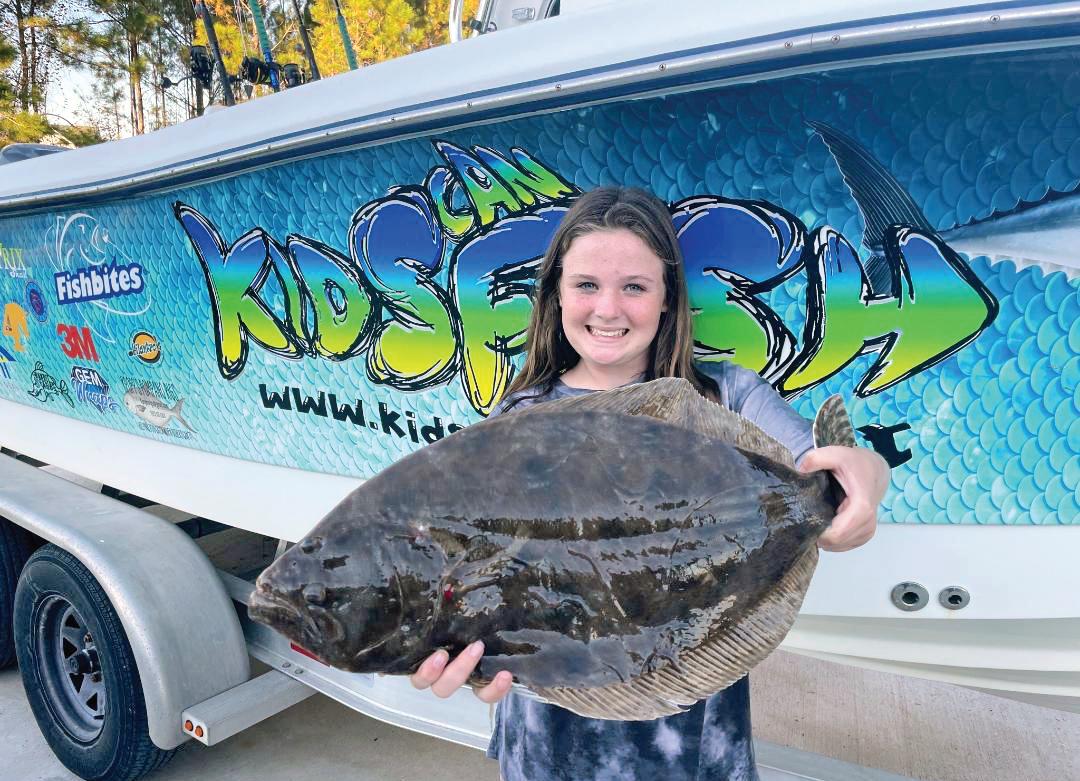
Emily Rose Hanzlik holds 56 IGFA world records in various categories. She hails from West Palm Beach, where she has a part time Bow n Guide Service as well as shing classes for Jr. Anglers. Find her on Social Media @emilyhanzlikoutdoors.
It’s 8:17 p.m. Been out on the lake for hours.
But there are more fsh in the water.
And my LBP batteries are still going strong. Maybe One More Cast . . . the offcial battery of “One More Cast...”



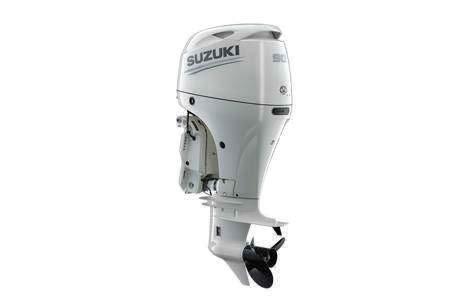
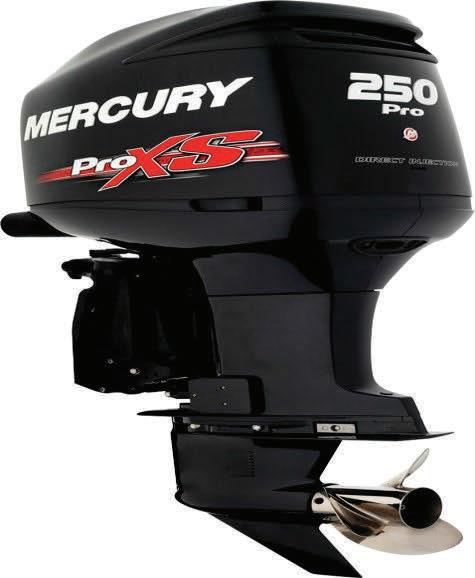
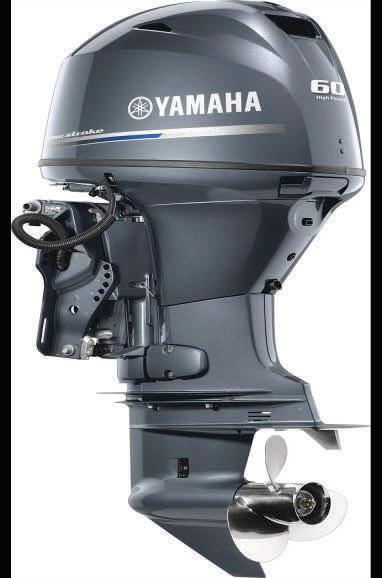

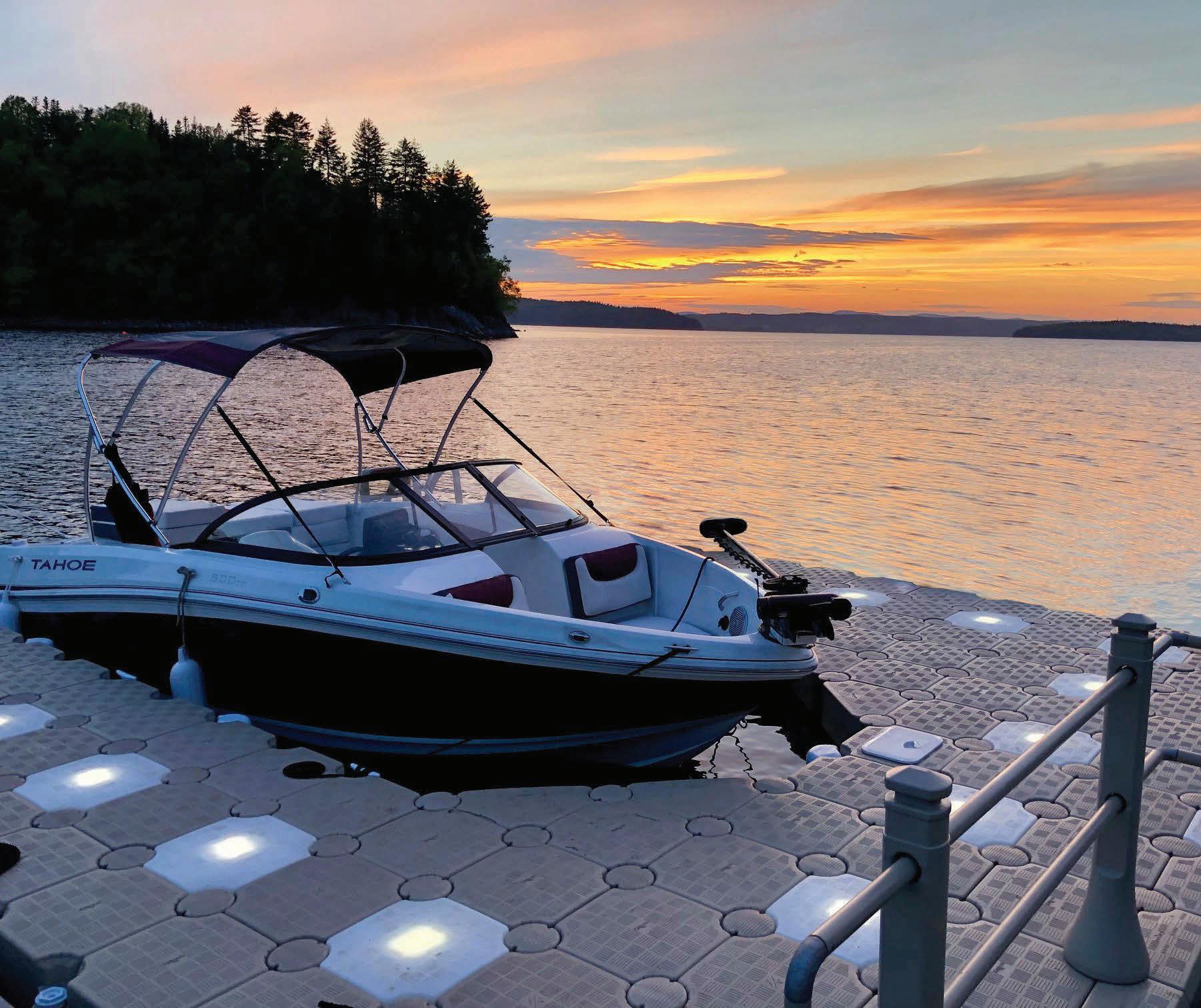

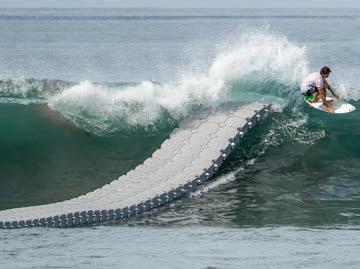

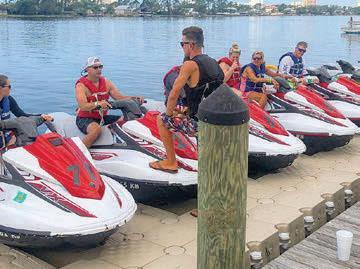
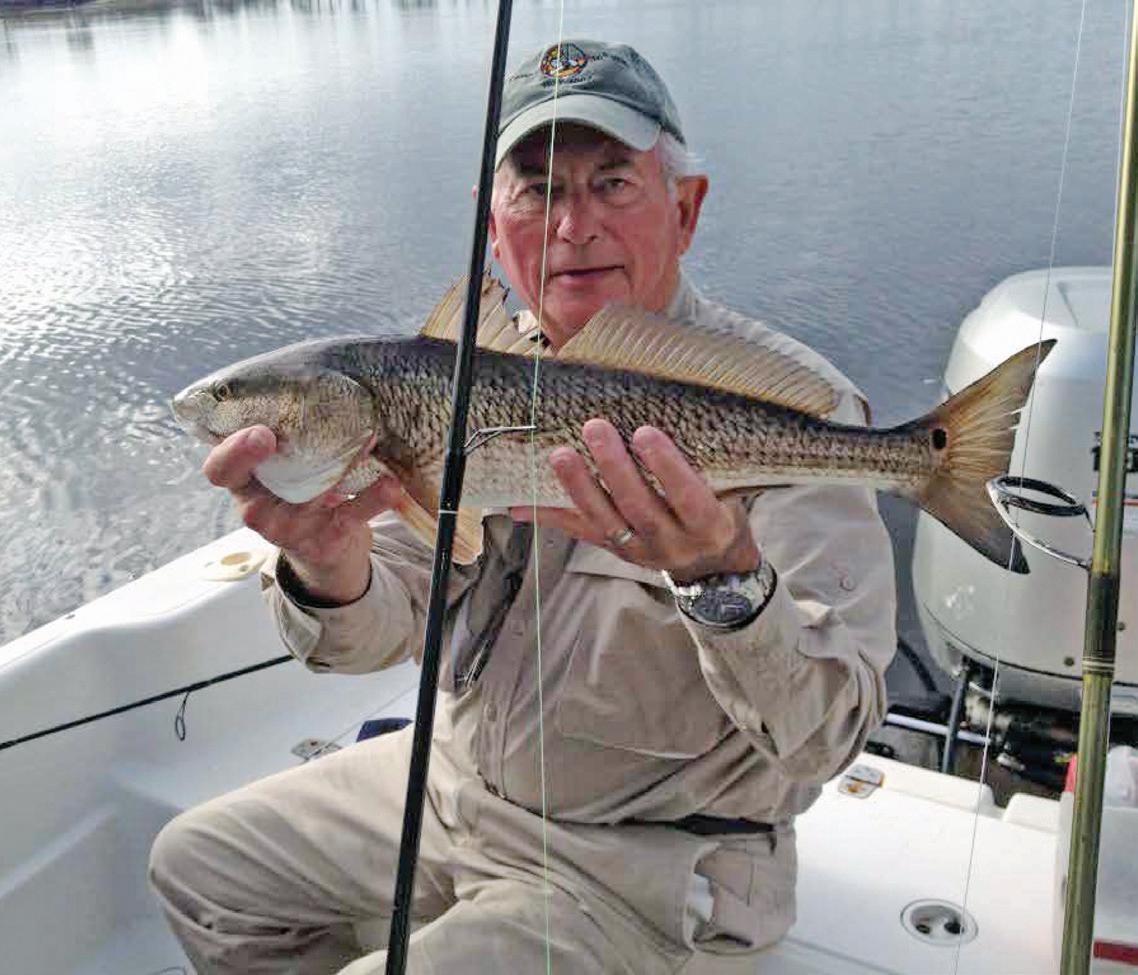
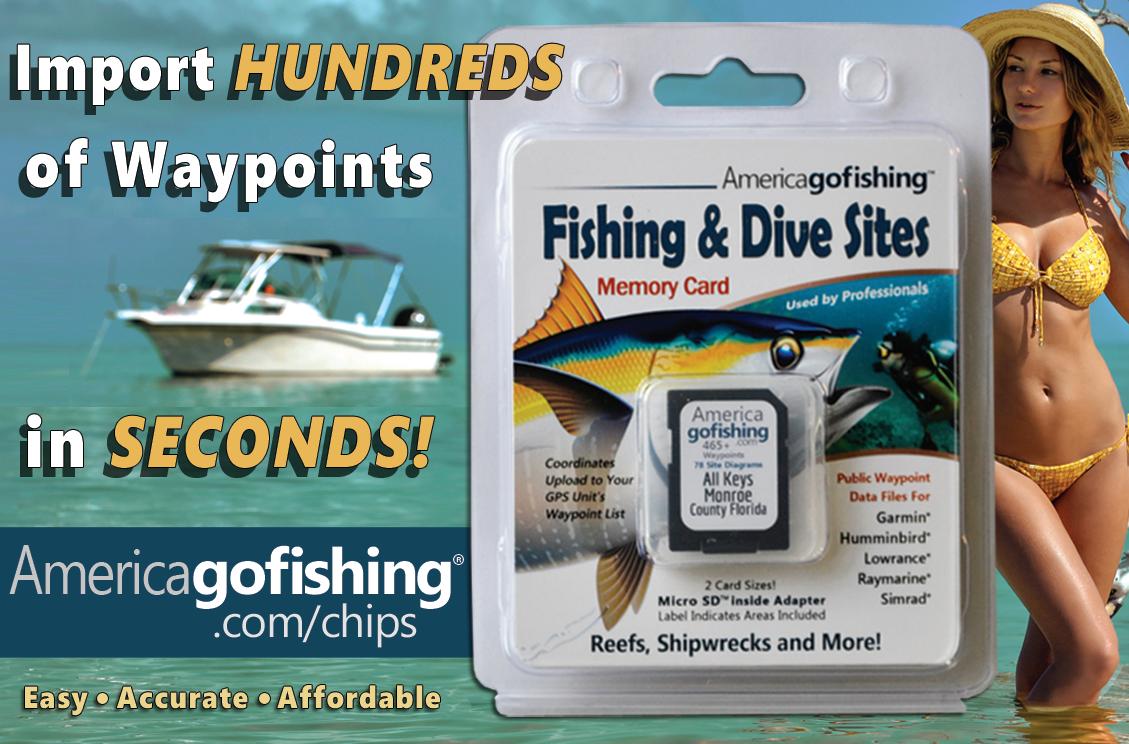
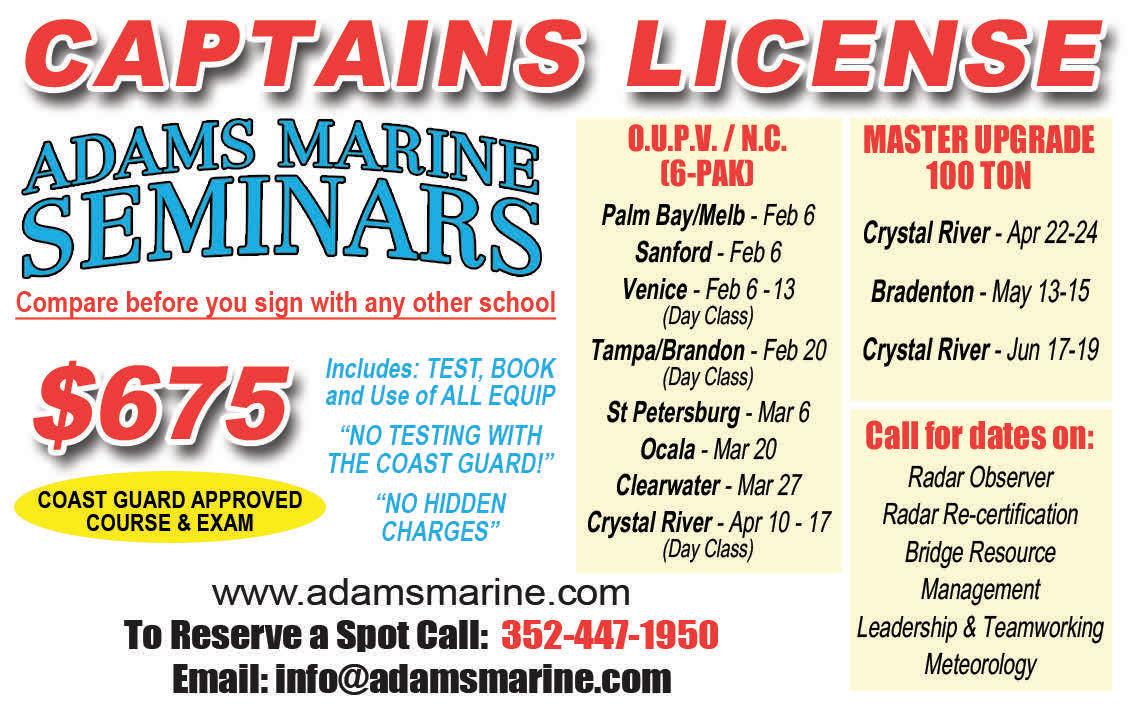
The Miami International Boat Show and the Miami Yacht Show have joined forces to create the Discover Boating Miami International Boat Show, the largest boat and yacht show in the world. Discover everything from kayaks to superyachts to the latest aquatic innovations. e on-land portion of the event will take place at the newly reimagined Miami Beach Convention Center and Pride Park.
e in-water components of the show will take place at Venetian Marina, Herald Plaza, Museum Park Marina, and Yacht Haven Grande Miami.
Historically, the Miami International Boat Show and Miami Yacht Show have attracted hundreds of thousands of attendees to South Florida and generated an estimated combined annual economic impact of $1.34 billion.

e on-land portion of the show will take place at the Miami Beach Convention Center and Pride Park. e inwater components of the show will take place at Herald Plaza, Venetian Marina, Museum Park Marina, and Yacht Haven Grande Miami.
Miami Beach Convention Center Powered by West Marine: Find boats up to 49 feet, engine manufacturers, marine accessories, electronics, and retail pavilions.
e Progressive Boat Show Experience at Pride Park: Discover a collection of experiential boating lifestyle activations, entertainment, innovative cuisine, educational seminars, and a marine accessory pavilion.
Herald Plaza: Explore powerboats, motor yachts 30’ to 125’, yacht tenders, engines, marine accessories, and retail pavilions.
Venetian Marina: Test drive over 150 sea trial vessels and nd additional new and brokerage boats and engine manufacturers.
Museum Park Marina: Check out the latest sailboats, catamarans, and sailing accessories.
SuperYacht Miami at Yacht Haven Grande Miami: Experience an enclave for superyachts. is exclusive marina will feature the world’s largest and most spectacular yachts. *Access only available with Windward VIP or SuperYacht Miami tickets.
Wednesday (2/15) 10AM - 6PM
ursday (2/16) 10AM - 6PM

Friday (2/17) 10AM - 7PM Saturday (2/18) 10AM - 7PM Sunday (2/19) 10AM - 5PM
www.miamiboatshow.com

February in Miami is great. Historically mild temperatures and calm winds make for a pleasurable shing experience. All three of the main sh that we target are biting well, including peacock bass, snook, and tarpon. ere are many more local exotic sh that are ready to make your reel scream and your heart rate jump up at the same time.
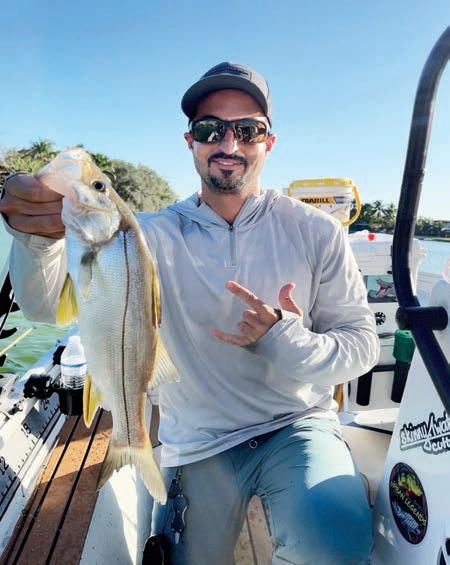
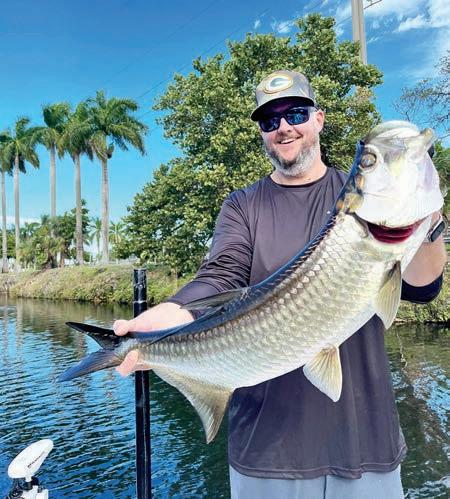
Snook and tarpon are generally targeted in deeper water with live baits such as shad, pin sh or shiners. I like to freeline them. e trick is to leave your bait alone so that it looks as natural as possible. Both snook and tarpon are very smart sh with huge eyes and may get nicky with a live bait that doesn’t swim right or looks o in anyway. Put your bait out and allow it to swim on its own for ve minutes, then retrieve, check your bait for liveliness and put it back out changing locations as necessary. is is our rule of thumb for more strikes when targeting both trophy sh.
When using lures, the plan changes a bit. We use arti cial baits that match the common bait sh seen in the area. I prefer lures that sink slowly or suspend upon each pause between every 4-5 cranks. Drop o s and bridge pilings tend to work best when seeking tarpon. I like moving water around bends and rock piles for snook.
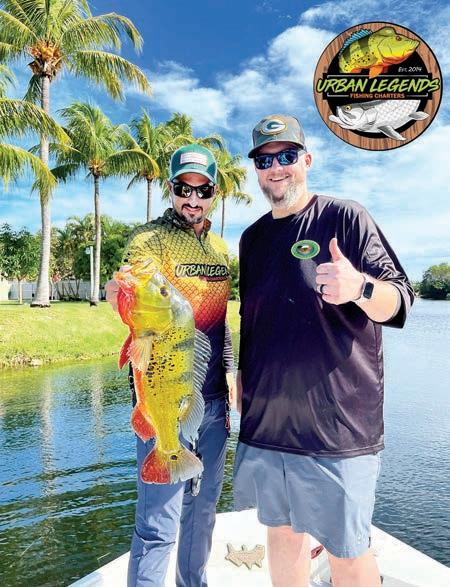
Peacock bass tend to hang out mostly near shore in depths of 5-10 feet of water. ey like structure and other ambush spots where they can hunt without being exposed. ese sh bulk up this time of year in preparation for the upcoming spawn which happens at the end of the month and again in April. We target them with live shiners, poppers and ies that match the colors of juvenile peacocks.
Peacock Bass are not actually a bass at all. ey are the largest member of the Cichlid sh family. It is thought that the “bass” designation was a xed to the common name, peacock to attract sherman to target them in the United States when they were rst introduced in the early 80’s.
Whatever the name, they are highly aggressive and especially violent towards sh of their own species. ey are extremely territorial. ey also protect their fry for the rst few months of life until they are old enough to survive on their own.
With cooler waters upon us, try shing on sunny days when the water temps are ranging between 72-82 degrees. Cooler water temperatures send these sh deep and slows down the bite considerably. Water temperatures below 60 degrees for more than 3 days may cause the swim bladder to shrink and usually kills them if they cannot nd sanctuary in deeper warmer water to wait out a passing cold front.
Urban Legends Fishing Charters
Call/Text 305-998-3375
Facebook / Instagram @Urbanlegends shing or check out our website ULFish.com






















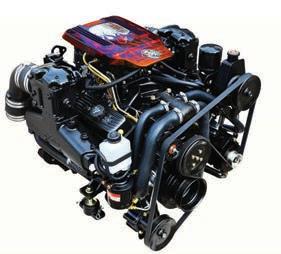
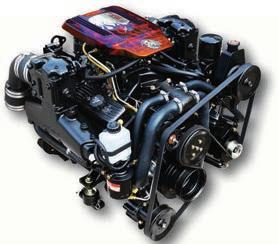








Well, here goes nothing. To me February can be the most challenging month of the year. You really have to modify your game to have success. For the record, I closed out 2022 with some encouraging signs for our winter shing around Miami. In December Abie Raymond and Leo Lombera turned me on to some great bay shing. We had great action from tarpon, snook, trout and saw plenty of black drum. A er 70 years of shing Biscayne Bay, Captain Abie Raymond introduced me to the rst red sh I have ever seen caught in Miami.
So far as a February forecast is concerned, if you catch a calm day then you should go catch a sword sh, day or night. I would bait with rigged squid on either trip. If the sword sh intimidates you, then your next best bet would be to try bottom shing in 580 to 720 feet of water for tile sh. I like a three-way swivel connected to appropriate weight on one leg and a 10-foot 100-pound leader on the other leg. Finish your rig with a 9/0 VMC circle hook baited with a king sh or bonito belly strip, butter ied ballyhoo or goggle eye or a good-sized squid. If you’re up to it, those tile sh are frequently caught slow pitch jigging.
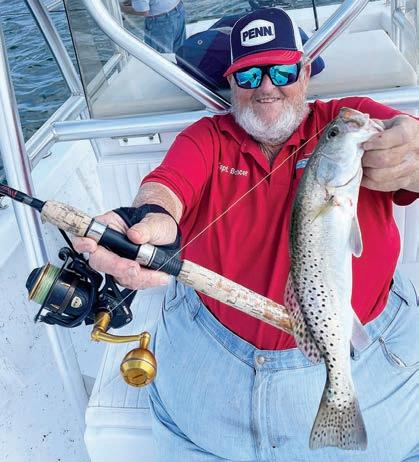
If you catch a day with 10-25 knot winds, out of the north, Northwest or Northeast are ne, then give sail sh your best shot. Try to nd some North bound current and re up the kites. Almost any live bait will produce, but goggle eyes and herring are hard to beat. In February you might be shocked to nd good action even on sail sh using pin sh for bait.
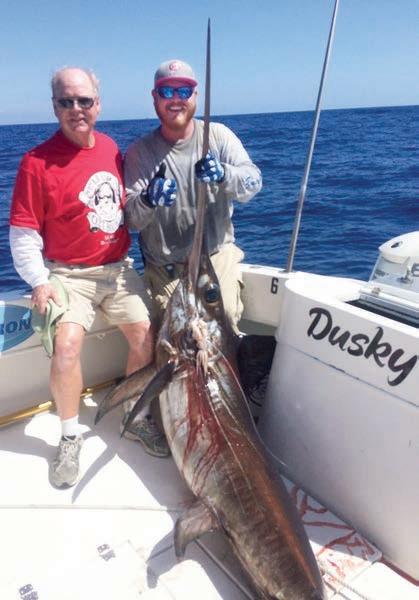
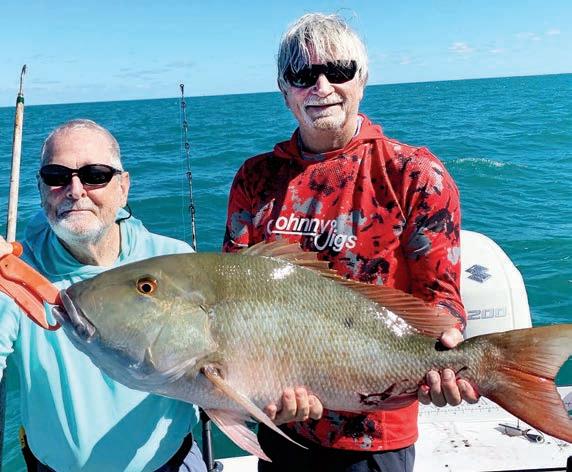
To me your best bet in February is near shore shing. Shrimp should be on the move every night. is migration plus cool waters inspires lots of action from the inlets to 40-60 feet of water. Fishing with live shrimp or small to medium size pilchards can be amazing. Anchor in your chosen area and hang a chum bag full of frozen chum behind the boat. You can be amazed by the variety you catch. Mackerel, gray snapper, yellowtails and yellow jacks, blue sh and the list just keeps going. If ballyhoo show up in your chum, catch a few and free line one out behind the boat. Giant mutton snappers and king sh roam these winter shallows and they both enjoy a good ballyhoo snack.
Speaking of that shrimp migration, one night or more pack up the family, a bright lantern and some long handled nets and chase migrating shrimp around inlets from shore or boat. While you are catching shrimp you can pitch out a few on free lines or light weights and catch a variety of dinner or game sh. Some of the years best tarpon catches take place during shrimp runs. Be sure you bring some warm clothes and watch for fast moving fronts coming from the northwest. But sh shallow and nd great light tackle shing.

Capt Bouncer Smith 305-439-2475
captbouncer@bellsouth.net

February is one of the craziest months of the year for me. I split my time between shing in Flamingo and tarpon shing out of Miami with my clients. I’d also say February is perhaps the coldest month of the year here in South Florida. is time of the year my Flamingo technique is pretty straight forward. When shing canals and creeks, a simple 1/4oz, 3/8oz or 1/2oz jig head with a live shrimp or gulp shrimp will do the trick. e size of the jig head you use all depends on depth and the speed of the current.
I also like to work the boundary markers around the park using the same method. During this time, most species are looking for points were the current breaks that’ll hold warmer water temperatures. Working your shrimp on the bottom or bumping it slowly o the bottom should get you hooked up pretty quickly.
For a er dark action my focus shi s from the West coast over to Miami. It’s time to go target the most powerful inshore sh on earth, the “Megalops Atlanticus” A.K.A. tarpon! Now is the time when these sh make their annual migration South to the keys to spawn. Along the way you can nd tarpon gorging and fattening up as they continue their migration South to the keys. is time of the year Miami is, in my opinion, home to the best tarpon shing in the world.
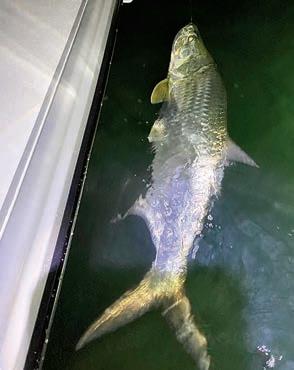


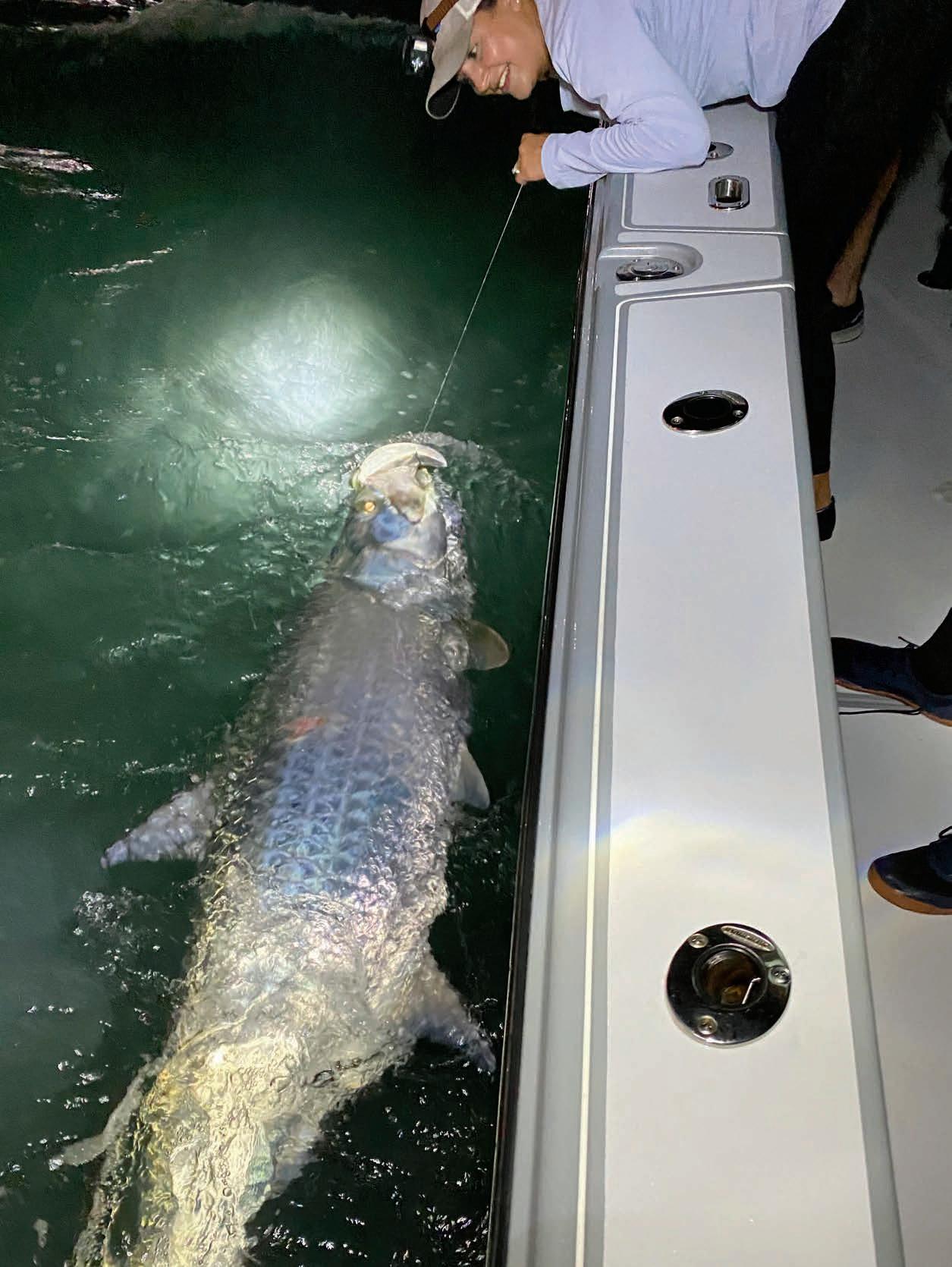
How do we catch them you ask? First thing, shing an outgoing tide is key. I’m not saying you can’t catch them on an incoming, but your sh activity will de nitely be greater during an outgoing tide. Fishing inlets, bridges and sea walls with a live shrimp rigged on a 6/0 or 7/0 circle hook and simply letting dri with the current is the preferred method.
A useful method to locating these sh is using side scan imaging. Using the side scan on my Humminbird Apex allows me to locate these sh with ease to then position myself in the right place and be successful. My Minn Kota trolling motor is also very useful when shing for tarpon. It lets me sneak up into target areas quietly, and then keeps us in perfect position using spot lock “anchor mode”. Having the proper gear is also important. My go to out t is a Daiwa Saltist MQ 10000 or 14000 on a 20-30lb Biscayne Rod.
You want to be able to bring these sh in as quickly as possible, revive them, and then set them free.



If you have a passion for conservation as I do, and you want to see Florida’s natural resources protected as I do, consider supporting e Fish & Wildlife Foundation of Florida (FWFF). is group is a nonpro t 501(c)(3) organization that seeks to protect our outstanding animals and plants and the lands and waters they need to survive. e organization works closely with the Florida Fish and Wildlife Conservation Commission (FWC) and many other public and private partners. Since their founding in 1994, they have raised and donated more than $60 million for conservation and outdoor recreation, including youth outdoor education. One of the cool ways that you can show your support is to purchase one of the Fish & Wildlife Foundation of Florida’s license plates at https://wildlife orida.org/ buy-a-plate/ or at your local tax collector’s o ce. For every plate sold, $25 is donated to a cause of your choice. It’s not a small thing. ey receive more than $1 million each year from these donations, funds that they and their partners use via grants to conserve Florida black bears, wading birds, and many other species. ey also use these monies to protect and manage new wildlife lands and waters and provide kids with formative outdoor experiences. To learn more about e sh & Wildlife Foundation of Florida and their mission visit them on the web at wildlife oridaorg.


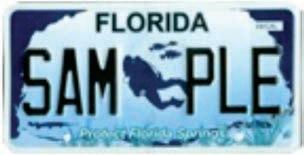
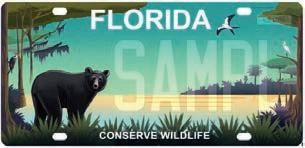
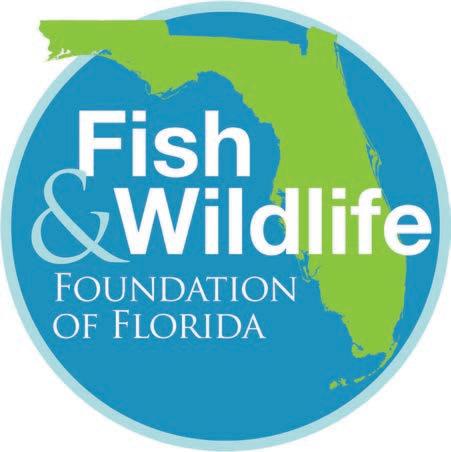
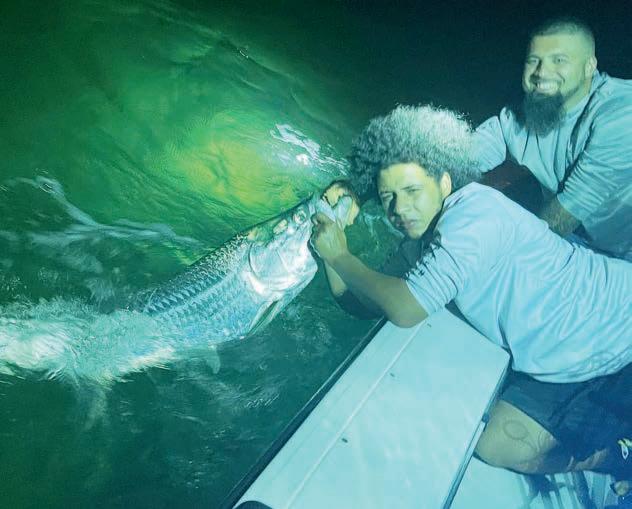

e next 2 hours were tu , slow bite. We hit a few new spots in the downtown area where we have caught sh recently, but we were only able to hook and land small sh, under the minimum 4 foot length requirement. With 1 hour remaining we motored to another spot that’s super di cult to sh because of wind and tide. On way, we saw that FWC had stopped for inspection one of our other boats in the tournament. TEAM Flaco including, @ justincredible, @captainjax aco and @ogguz08 were all sitting there listening as the o cer reviewed their safety gear. Although they would have no violations, there was little time le .
by Raymond Muniz, Capt. JaxFebruary is a great month for tarpon shing in all of South Florida, especially Miami. However, this month’s dissertation is a story about my new semi-annual tarpon tournament which happened on December 21st and will happen again in May. It is known locally as the BBC-JAX Tarpon Tournament Invitational… All of the techniques applied in this article are still relevant and will work now. For you dirty minded readers, BBC-JAX stands for Baits by Captain JAX… Not the British Broadcasting Channel… or anything else for that matter… @305jmac enthusiasts know what I’m talking about… is tournament has simple rules, catch the most tarpon over four feet in length, within a designated 5 hour period… Each team of 3 to 4 anglers gets a premeasured foam pool noodle, cut to an exact 4-foot length, for measuring sh. When a sh is landed, the team must video record the landing as proof of each catch and release. Some of the best shermen that I know were competing in this tournament. I’ll give you the Instagram handles of some of them, guys like: @hutchtouch shing, @Captchriscamacho, @19snakehead77, @Pedrogos shing , @mrdarna, @305shore shin ,@305jmac, @305bike shing, @justhookit, @icbluecharters, @justincredible, @captainjax aco, @ogguz08, @ pirobaitandtackle, and @mudlife.
e seems pretty simple when you read about it but just imagine the pressure when you ght a 6 sh for 40 minutes and then he breaks you o . Now you have 4 hours and 20 minutes, not counting travel time. e 5 hours feel like 40 min.
My team started the tournament in my secret spot… It’s pitch black and the green water boils with the thick current lit by the industry sodium lights on poles high above. is is night shing in the city among the urban sprawl of Miami. At this time of year this place always holds sh, though they aren’t always the biggest. I felt like we could pull a 4-footer out of here anyway. @305shore shing tosses a live crab. Boom, in 30 seconds he is hooked up with our rst sh. the Tarpon is plenty big and he comes out of the water shaking his massive head. A er the second jump the hook pulled! It kinda’ made us all sick. Our team frowns, sucks it up, and re-rigs… It was a good size sh. I noticed he was using a j hook and asked everyone to switch to circle hooks. Minutes later in the same spot @305bike shing hooks up on a live shrimp. He fought the sh like a beast, using a Penn erce 8000 lled with 50 lb beyond braid. A er -15 min we had the sh by the boat. We got a good measurement on him and release him with no problems.
As we got into position on our last spot, the wind picked up a touch. Most of these tarpons are super smart and when hooked they will run under the bridge or between the pilings. With our baits in the water for less than 2 minutes, @305JMac hooks a very nice size tarpon. We followed it under the bridge, and the sh wrapped around the pilings. I got the boat as close as I could and then circled around to clear the line. We were able to land our second sh. With 30 minutes remaining we headed to the dock. We were back with a thin 7 minutes to spare before the cut o and disquali cation. not all the boats are back, and word is we are in rst place with our two sh landed… Where is the last boat? TEAM Flaco, who we had seen earlier, comes rolling in hot, with two minutes remaining on the clock. @captainJax aco, @justincredible and @ ogguz08 look disappointed and defeated…. Everyone asks, “How many did you catch? How Many?” “Only three” said Flaco, looking pitiful. You should have seen the look on their faces when we told them that their three sh landed had won the tournament. Congrats to TEAM Flaco for the big W with the odds stacked against them.
Capt. Jax Captain Jax Bait and Tackle 490c E 4th Ave, Hialeah, FL 33010 @captainjaxmiami 786.300.5362


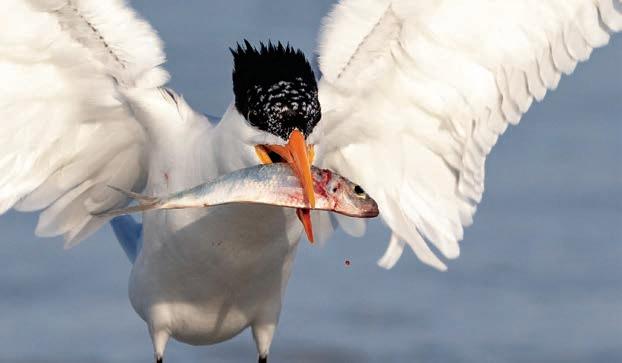

February is a fantastic month for Spanish mackerel. February also usually brings some of the best shrimp runs and there is typically a quantity of pilchards near shore as well. Mackerel will be feeding on the pilchard schools during the day. ey will be eating the shrimp at night. Now that we know what they are eating, we can “match the hatch” and nd the bait schools rst. Look for the birds. You will want to sh under the low, wheeling Royal Terns. ey are the birds that look like seagulls except for their beak is long and yellow and sharp. Fish two 10-12 lb spinning out ts. Troll a 3 inch silver spoon. Make sure the spoon is tied to an 18 inch #3 wire leader with an 80 lb spro swivel. Tie your main line to the spro Swivel. Fish two of these spoons. Let your spoons out two separate distances. Fish one short (40 back) and one long (80 back). Have the anglers hold the rods pointed low and out the sides of the boat to keep the angle of the line low enough so the spoon stays swimming subsurface. Troll about 4 knots OR as fast as you can go without your spoon exiting the water and skipping. You can cast the spoons at the bait schools and let them sink to the bottom, then retrieve them as fast as humanly possible for exciting strikes but much more work. Channels close to the ocean should all hold them in February as long as you sh near the bait schools. Remember to follow your local regulations.
Good luck and GO HARD.
Captain Abie Raymond 305.775.5197
@abie_raymond www.gohard shing.com
 by Capt. Abie Raymond
by Capt. Abie Raymond

Brought to you by Seminole Hard Rock Hotel & Casino in Hollywood, Fla., the 12th Annual Jimmy Johnson’s “Quest for the Ring” Championship Fishing Week will take over South Florida March 7-11, 2023, additionally hosted by Visit Lauderdale, with tournament headquarters based at Seminole Hard Rock in Broward.
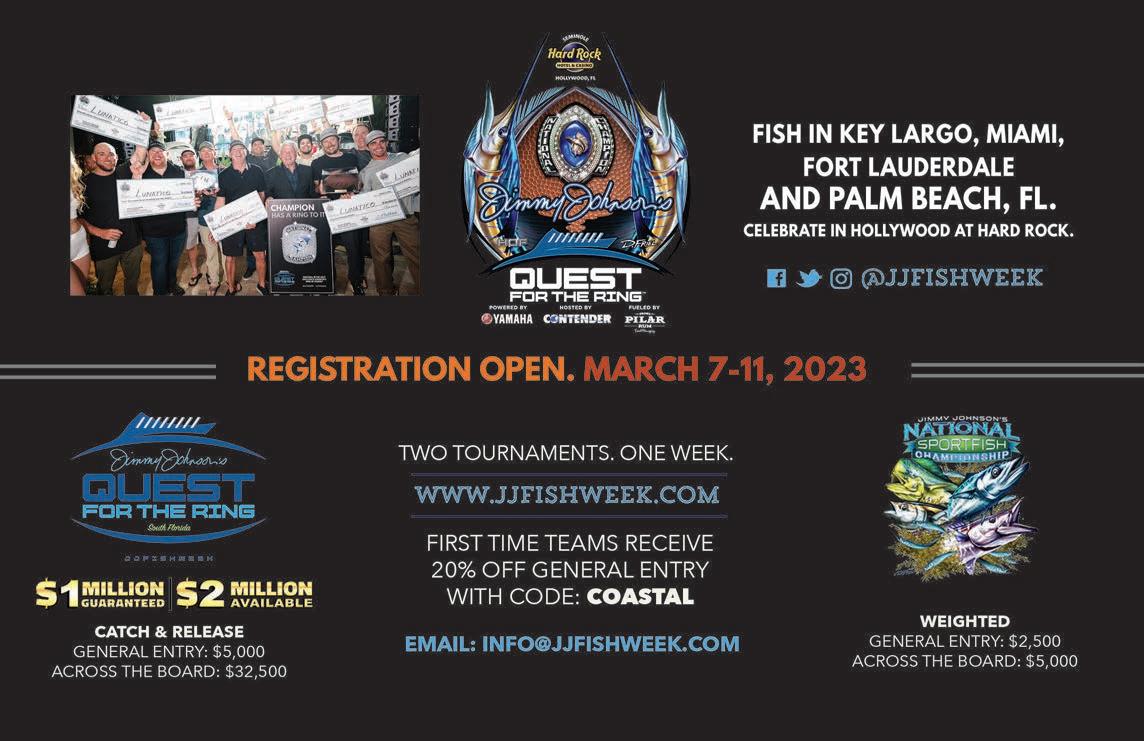
e annual four-day tournament includes the 2-day Quest for the Ring Catch & Release Championship and the National Sport sh Championship Weighted Tournament, which takes place as a separate tournament during the event week. Hosted by Contender Boats, powered by Yamaha and fueled by Papa’s Pilar Rum, the 2-Day Catch & Release Championship features the World’s RICHEST guaranteed purse of $1 million, in partnership with Seminole Hard Rock Hotel & Casino in Hollywood, Fla, making it the longest-running guaranteed purse in history.
Jimmy Johnson’s “Quest for the Ring” Championship Fishing Week is “all about the ring!” according to Coach Johnson. Each year teams vie for their champion rings and entrance into the highly coveted Ring of Honor, an elite group of champions who have taken home the top prize at this exciting competition in the Catch & Release Championship. Each year, overall champions receive Jimmy’s famed National Championship Ring. Renowned for the best parties, which are
back at Hard Rock, the highest guaranteed purse and the ultimate week of shing, tournament highlights include celebrity charity days and highly competitive tournament showdowns. Registration will end with the captain’s meeting on Tuesday, March 7, if spots are still available.
“ e best wasn’t the Super Bowl, the best was not University of Miami, the best is right now!” said Coach Johnson. “ ese teams are part of THE BEST. We continue to grow each year, and I am thrilled to have our partners at Seminole Hard Rock Hotel & Casino Hollywood join us as we
showcase the thrilling challenge of sport shing and to move our hosting of our event to such a beautiful destination in Broward County. We look forward to seeing everyone in March!”
Contender Boats is the o cial center console boat sponsor and a presenting sponsor of the tournament along with the o cial outboard sponsor, Yamaha, and o cial spirits partner, Papa’s Pilar. Additional Hosting sponsors include Oakley Prizm, Michelob Ultra, GED Lawyers, Visit Lauderdale, Garmin, Celebrity Cruises, Hines Securities, Titos Vodka, Atlantic Radio Telephone, and Cadillac. Miami Retail Partner is Crook and Crook and Broward Retail Partner is Big Dog Tackle. e o cial tournament artist and apparel provider is Connected by Water. Additional event sponsors can be found on the event website. e tournament is produced by Fish Hard Events.

Boat Entry information and the full schedule of events can be found at www.jj shweek.com. Registration starts at $5,000 for the Quest for the Ring Bill sh Tournament and $2,500 for the Sport sh Weighted Championship. Register on the tournament website or by contact the tournament o ce at info@jj shweek.com or (305) 255-3500 for more information.
Follow @JJFishWeek on Facebook, Instagram, and Twitter for up to date tournament information.
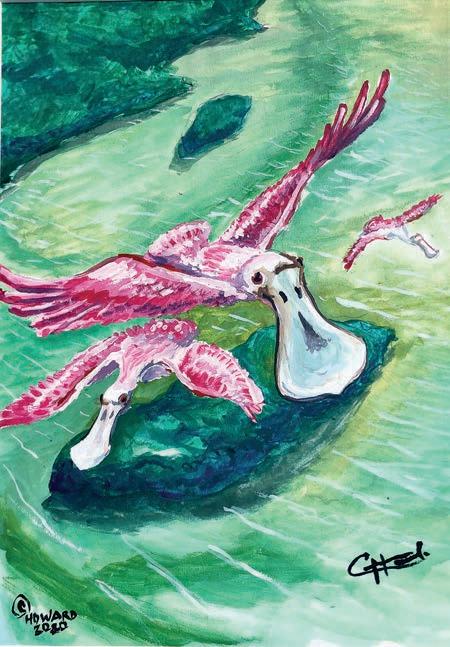

Growing up on Key Biscayne o ered Chris Howard an exceptional opportunity to be surrounded by the natural beauty of Crandon, and Bill Baggs, and Biscayne National Park. “My family encouraged me to explore and to respect the environment.” “I was always an artist, drawing ddler crabs, sh, and seabirds as a kid.” “In high school my outdoorsy friends were sherman.” It rubbed o on him. “Fishing became a way to enjoy the outdoors even more.” Chris became a serious y sherman, chasing bone sh and permit in Miami. Eventually he and his friends began venturing into Everglades National Park. “Flamingo was my escape from reality” he says. “My favorite, is snook on y in the shallow ats.” “My dad’s side of the family live in Arkansas and also love the outdoors. So, I have also spent some time chasing rainbow trout and learning about nature in that part of the country.” Chris’ love of wildlife quickly became a focus of his art.
“In my early twenties I was working in a gas station while attending FIU. e owner allowed me to place some of my pieces in the little shop and I was shocked when people started buying them.” When he was twenty-two, Chris sold his rst ne artwork, a full-size painting to a man who owned a tackle shop and who would later become his mentor. “ at was the start of it,” he says.
Chris, who now works in watercolor, acrylic, oil pastel, charcoal, pencil, pen and ink, and even woodburning, creates ne art pieces which celebrate South Florida’s game sh, and marine ecosystems. In addition to being a professional artist, Chris also teaches art at a Charter School in Downtown Miami. “It’s extremely rewarding,” he says, “I love to see students faces light up when they discover a love of art as I did when I was a child.”

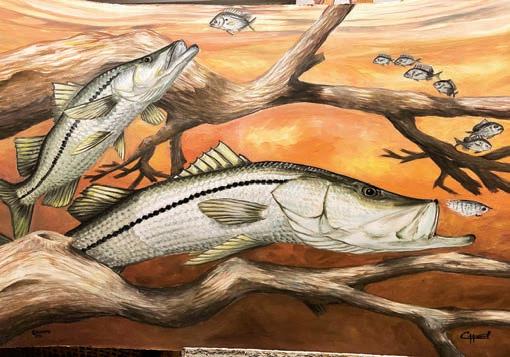
For more information on Chris Howard or to see his work visit nsart.com.
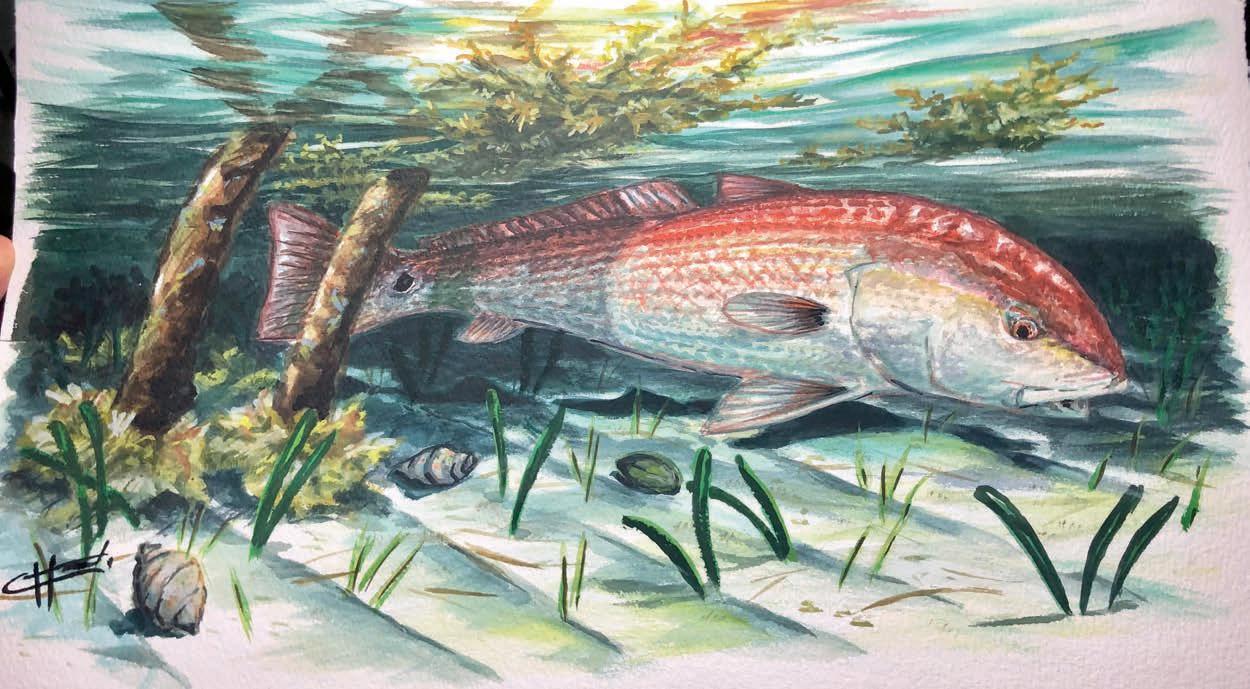
PONTE VEDRA BEACH
814 A1A N., Suite 103
Ponte Vedra Beach, FL 32082 904-285-0014

JACKSONVILLE
1201 Riverplace Blvd. DoubleTree by Hilton Hotel, Jacksonville, FL 32207 904-396-6200
ORLANDO
7501 W. Sand Lake Rd. Orlando, FL 32819 407-226-3900
WINTER PARK
480 N. Orlando Ave. Suite 100B Winter Park, FL 32789 407-622-2444
LAKE MARY
80 Colonial Center Pkwy. Lake Mary, FL 32746 407-804-8220
TAMPA

1700 N. Westshore Blvd. Tampa, FL 33607 813-282-1118








ST. PETERSBURG
131 2nd Ave. N. St. Petersburg, FL 33701 727-821-4139
SARASOTA

6700 S. Tamiami Trail Sarasota, FL 34231 941-924-9442
WEST PALM BEACH
651 Okeechobee Blvd. West Palm Beach, FL 33401 561-514-3544
BOCA RATON
225 NE Mizner Blvd., Suite 100 Boca Raton, FL 33432 561-392-6746


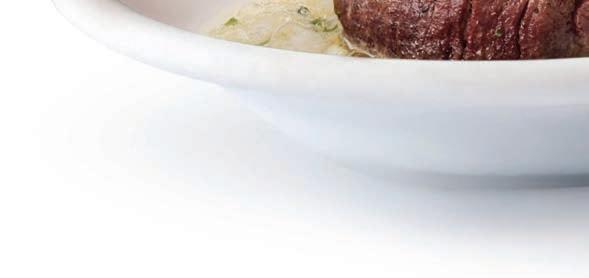

BONITA SPRINGS
23151 Village Shops Way Suite 101, Coconut Point Mall Bonita Springs, FL 33928 239-948-8888
FORT LAUDERDALE
2525 N. Federal Hwy Fort Lauderdale, FL 33305 954-565-2338
AVENTURA 2980 NE 207th St. Aventura, FL 33180 305-912-1266
CORAL GABLES 2320 Salzedo St. Coral Gables, FL 33134 305-461-8360


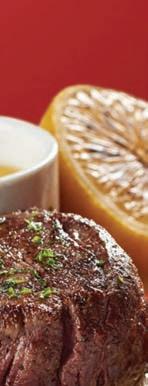







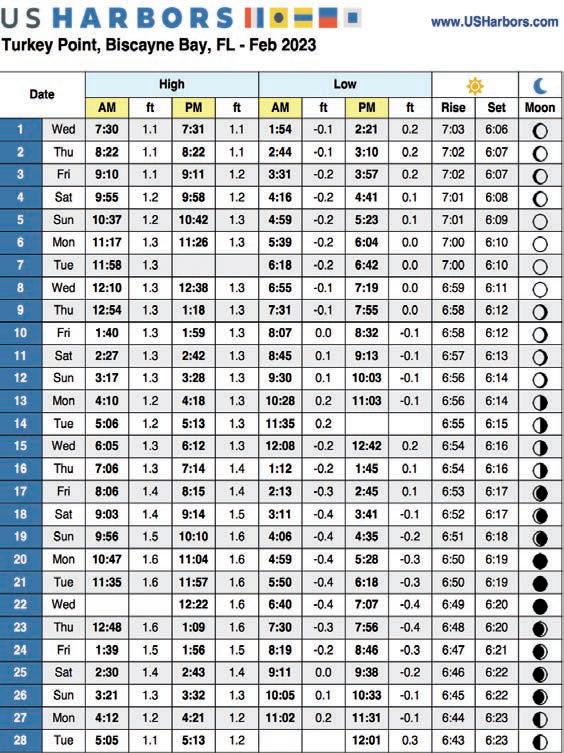

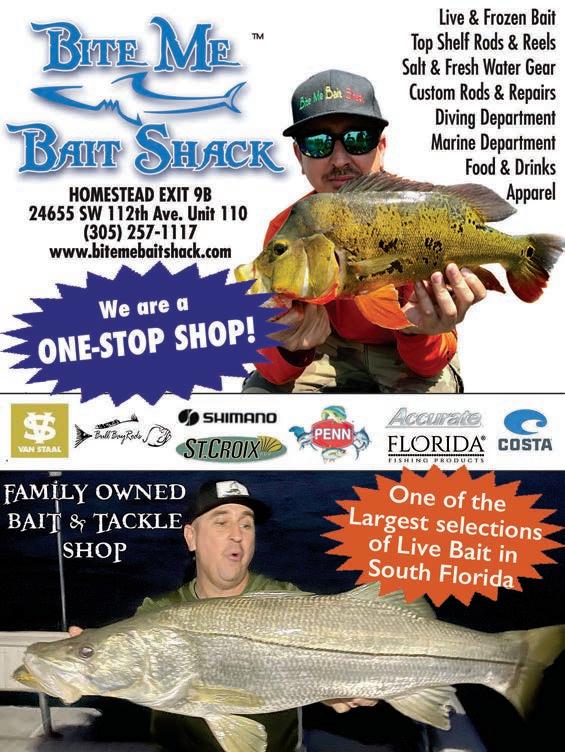
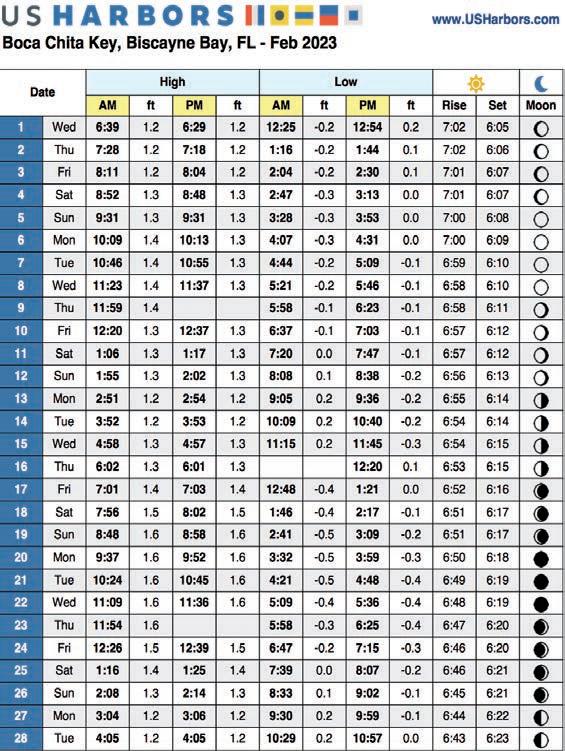
20 lb. prospect high vis line, Carnage 3 rod, Penn Fathom II 40NLD highspeed

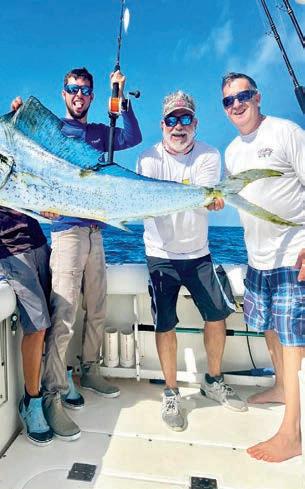
Captain Christian J. Sanchez caught Dec. 31, 2022 from his charter boat, Miami Sailfish Charters, in 200’, 2 miles south of Fowey Rocks.






Febrero es un mes fantástico para la caballa española. Las aguas en este mes suelen traer algunas de las mejores tiradas de gambas y también suele haber una gran cantidad de sardinas cerca de la costa, por lo que la caballa se alimentará de estas durante el día y dejará las gambas para la noche. Ahora que sabemos lo que comen, podemos “emparejar” al cazador con su presa.
Lo primero es encontrar los bancos de cebo, así que busque las aves. Lo ideal es pescar debajo de los charranes reales, que vuelan a baja altura; estas son aves parecidas a las gaviotas, excepto por su pico, que es largo, amarillo y a lado. Pesque con dos equipos de spinning de 10-12 lb y utilice una cucharilla plateada de 3 pulgadas; asegúrese de que la cucharilla está atada a un bajo de línea de alambre del nº 3 de 18 pulgadas, con un giratorio spro de 80 libras. Una vez con ello listo, ate la línea principal al giratorio spro y pesque con dos de estas cucharillas a dos distancias distintas: una corta (40 pies atrás) y una larga (80 pies atrás). Haga que los pescadores sujeten sus cañas apuntando bajo y fuera de los lados del barco, esto es para mantener el ángulo de la línea lo su cientemente bajo como para que la cucharilla permanezca nadando bajo la super cie. Navegue a unos 4 nudos o lo más rápido que pueda sin que la cucharilla salga del agua y salte. Si desea picadas más emocionantes, aunque con algo más de trabajo, puede lanzar las cucharillas a los bancos de cebo y dejar que se hundan hasta el fondo para luego recogerlas lo más rápido posible. Los peces deberían estar en los canales cercanos al océano en febrero y no debería ser difícil encontrarlos siempre que pesque cerca de los bancos de cebo, así que buena suerte y recuerde siempre cumplir la normativa local.


Capitán Abie Raymond 305.775.5197 @abie_raymond www.gohard shing.com





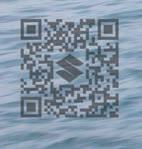


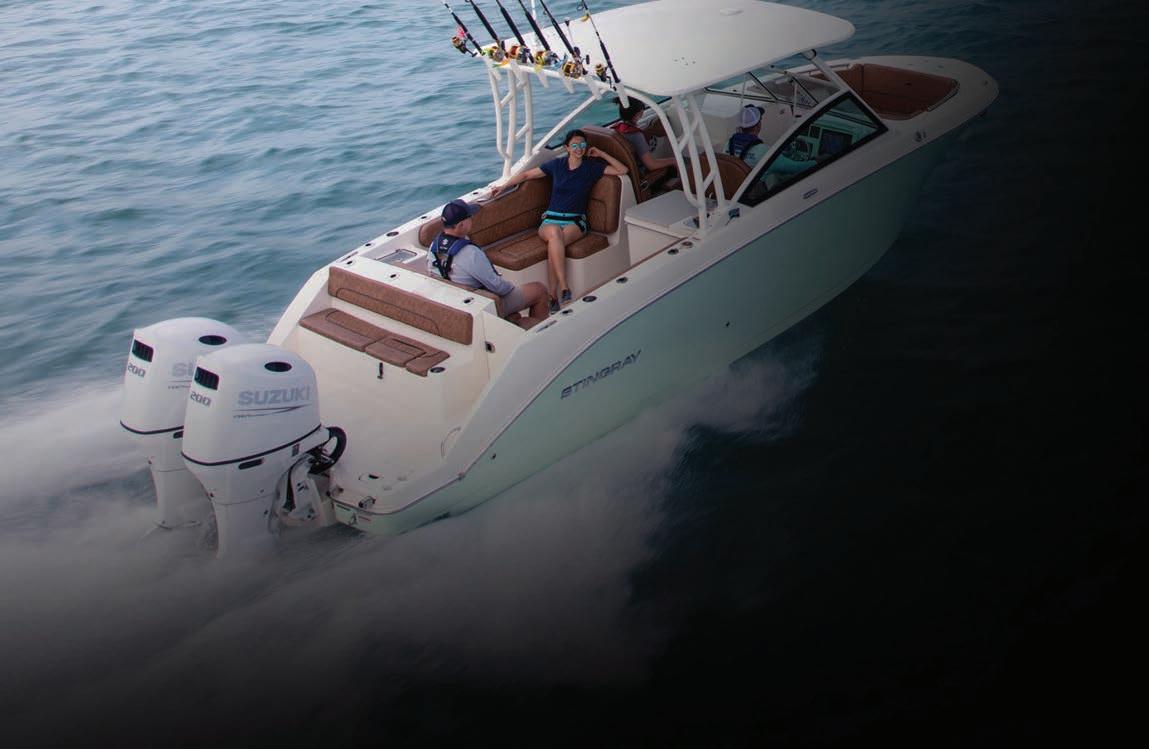 by Capt. Abie Raymond
by Capt. Abie Raymond


Febrero es uno de los meses más locos del año para mí, pues divido mi tiempo entre la pesca en Flamingo y la pesca de sábalo con mis clientes en Miami. También diría que febrero es quizás el mes más frío del año aquí en el sur de Florida.


En esta época del año mi técnica en Flamingo es bastante sencilla. Cuando se pesca en canales y arroyos, un simple jig head de 1/4oz, 3/8oz o 1/2oz con un camarón vivo o camarón gulp hará el truco. El tamaño del jig dependerá de la profundidad y de la velocidad de la corriente. También me gusta pescar con el mismo método en los marcadores de límite que rodean el parque, pues durante esta época, la mayoría de las especies buscan puntos en los que la corriente rompa y que mantengan temperaturas de agua más cálidas. Aquí trabajo con las gambas en el fondo y sacándolas lentamente del mismo ¡las presas se enganchan rápido!
Para la acción después del anochecer, mi atención se desplaza de la costa oeste a Miami. Es hora de ir a por el pez de bajura más poderoso del planeta, el “Megalops Atlanticus”, también conocido como sábalo real. Ahora es el momento en que estos peces hacen su migración anual al sur de los cayos para desovar, por lo que a lo largo del camino se pueden encontrar a los sábalos atiborrándose y engordando hasta llegar a su destino. Esta época del año Miami es, en mi opinión, el hogar de la mejor pesca de sábalo en el mundo.

¿Cómo los pescamos? En primer lugar, la pesca con marea baja es clave. No estoy diciendo que no se puede coger en un entrante, pero la actividad de los peces será de nitivamente mayor durante una marea saliente. El método preferido es pescar en sumideros, puentes y diques con una gamba viva, montada en un anzuelo circular del 6/0 o 7/0 y simplemente dejándola derivar con la corriente.
Una táctica útil para localizar a estos peces es el uso de imágenes de barrido lateral. Utilizando el escáner lateral de mi Humminbird Apex puedo localizar estos peces con facilidad, para situarme en el lugar adecuado y tener éxito. Mi motor de curricán Minn Kota también es muy útil en la pesca del sábalo, dado que me permite acercarme sigilosamente a las zonas objetivo y luego nos mantiene en la posición perfecta mediante el “modo ancla” de bloqueo de puntos. Siempre es importante contar con el equipo adecuado y mi favorito es un Daiwa Saltist MQ 10000 o 14000 con una caña Biscayne de 20-30 libras.
Hay que ser capaz de traer estos peces lo más rápido posible, revivirlos y luego dejarlos libres.
Nestor Alvisa HookedOnFlamingo.com
@hooked_on_ amingo_charters 786.387.2443































Febrero es un gran mes para la pesca de sábalo en todo el sur de Florida, especialmente en Miami; no obstante, el artículo de este mes se centra en una historia sobre mi nuevo torneo semestral de sábalo, el cual ocurrió el 21 de diciembre y volverá a celebrarse en mayo. Es conocido localmente como el BBC-JAX Tarpon Tournament y, para los lectores de mente sucia, BBC-JAX signi ca cebos por el capitán JAX ... No es el British Broadcasting Channel o cualquier otra cosa para el caso, entusiastas como @305jmac saben de lo que estoy hablando.
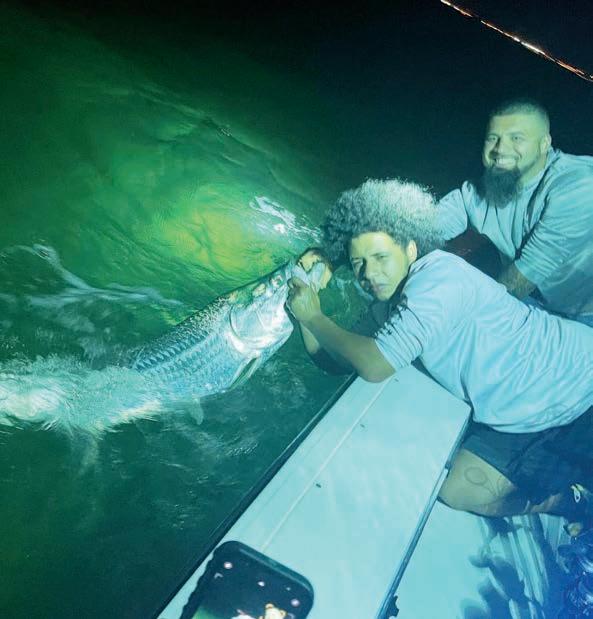
Este torneo tiene reglas simples, el objetivo es capturar el mayor número de sábalos de más de cuatro pies de longitud (alrededor de 121 centímetros), en un período designado de 5 horas. Cada equipo recibe una espuma para piscina pre medida para la medición y debe grabar en vídeo la prueba de cada pez. Algunos de los mejores pescadores que conozco estaban compitiendo como @hutchtouch shing, @ Captchriscamacho, @19snakehead77, @Pedrogos shing, @mrdarna, @305shore shin, @305jmac, @305bike shing, @justhookit, @ icbluecharters, @justincredible, @captainjax aco, @ogguz08, @ pirobaitandtackle, y @mudlife.
En principio parece bastante simple pero luego imagina la presión de estar luchando contra un pescado de 6 pies por 40 minutos y que, al nal, logre escapar. Eso te deja con 4 horas y 20 minutos, sin contar el tiempo de viaje. La realidad es que las 5 horas parecen 40 minutos. Todas las técnicas aplicadas en este artículo siguen siendo relevantes y funcionarán para la siguiente edición.
Mi equipo empezó el torneo en mi lugar secreto, un ambiente negro como el carbón, donde el agua verde hierve con la espesa corriente iluminada por las luces en los altos postes: esto se traduce en pesca nocturna en la ciudad, entre la expansión urbana de Miami. En esta época del año, ese lugar siempre tiene peces, aunque no siempre son los más grandes; de todos modos, sentí que podíamos sacar un pez de unos 1,2 metros de allí. La acción comenzó cuando @305shore shing lanzó un cangrejo vivo y ¡boom! en 30 segundos está enganchado con nuestro primer pez. El sábalo era bastante grande y salió del agua sacudiendo su enorme cabeza. ¡Después del segundo salto el anzuelo se soltó! Nos molestó un poco a todos, pero nuestro equipo frunce el ceño, se lo traga y vuelve a pescar.
Era un pez de buen tamaño. Me di cuenta de que estaba usando un anzuelo J y pedí a todos que cambiaran a anzuelos circulares. Minutos más tarde, en el mismo lugar, @305bike shing engancha un camarón vivo y pelea contra el pez como una bestia, usando una Penn erce 8000 cargada con 50 lb más allá del trenzado. 15 minutos más tarde teníamos al pez en el bote, donde le tomamos una buena medida y lo soltamos sin problemas.
Las siguientes 2 horas fueron de una dura picada lenta. Pasamos por algunos lugares nuevos en el centro de la ciudad donde habíamos pescado recientemente, pero sólo pudimos pescar peces pequeños, de menos de 4 pies de longitud. Con 1 hora restante nos dirigimos a otro lugar donde resulta muy difícil pescar debido al viento y la marea, pero el camino vimos que la FWC (Comisión de Conservación de Vida Silvestre y Pesca de Florida) había detenido para inspección a uno de nuestros otros barcos en el torneo: El equipo Flaco, que incluía a @justincredible, @captainjax aco y @ogguz08, estaban todos sentados escuchando como el o cial revisaba su equipo de seguridad y ,aunque no tendrían infracciones, quedaba poco tiempo.

Mientras nos colocábamos en posición en nuestro último punto, el viento se levantó un poco. La mayoría de estos sábalos son muy listos y cuando se les engancha corren bajo el puente o entre los pilotes. En menos de 2 minutos con nuestros cebos en el agua, @305JMac engancha un sábalo de muy buen tamaño, lo seguimos por debajo del puente y el pez rodeó los pilotes; llevé el bote tan cerca como pude y luego di la vuelta para despejar la línea. Fuimos capaces de desembarcar nuestro segundo pez y con 30 minutos restantes nos dirigimos al muelle. No todos los barcos han vuelto y se dice que estamos en primer lugar con nuestros dos peces desembarcados pero ¿Dónde está el último barco? El equipo Flaco, que habíamos visto antes, viene rodando en caliente, con dos minutos restantes en el reloj. El @captainJax aco, @justincredible y @ogguz08 se ven decepcionados y derrotados.... Todos preguntan: “¿Cuántos atrapaste?” “Sólo tres” dijo Flaco, con cara de pena, deberían haber visto la expresión de sus caras cuando les dijimos que sus tres peces desembarcados habían ganado el torneo. ¡Enhorabuena al equipo Flaco por su gran victoria, a pesar de tener todo en contra!
Captain Jax Bait and Tackle 490c E 4th Ave, Hialeah, FL 33010 • 786.300.5362
@captainjaxmiami
Llamada / Texto: 305-998-3375
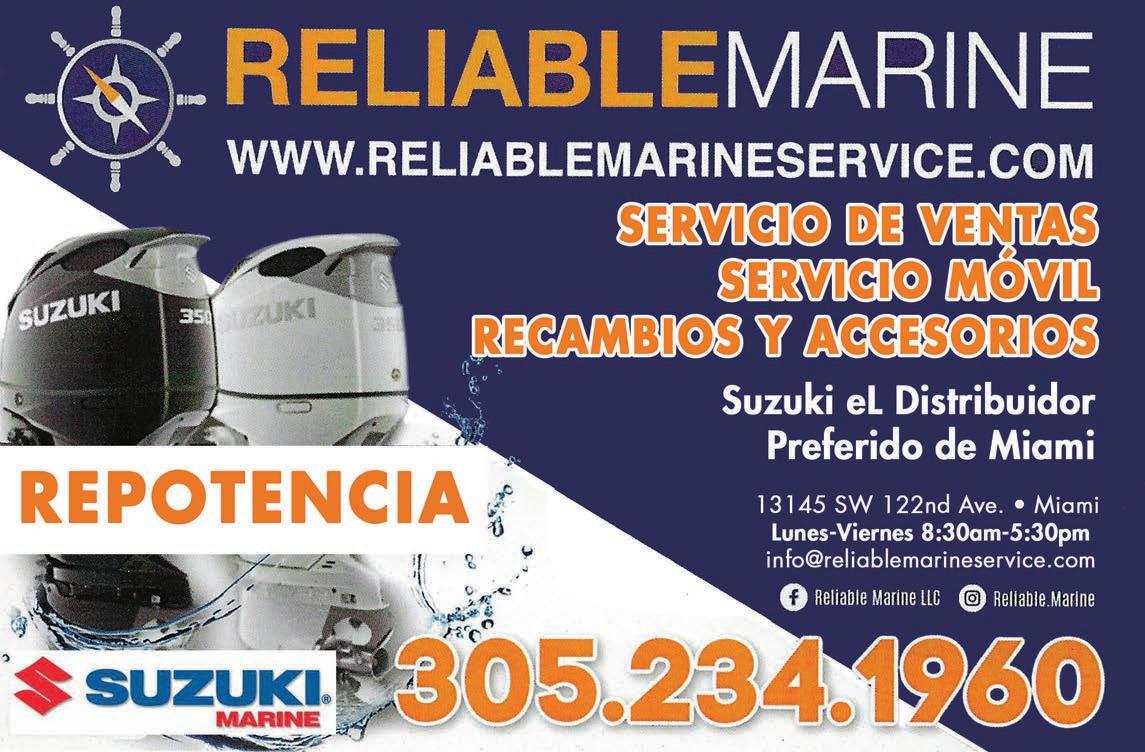
Síguenos en Urban Legends Fishing Charter Facebook / Instagram @Urbanlegends shing www.ULFish.com
El mes de febrero es estupendo en las aguas de Miami, pues las temperaturas históricamente suaves y vientos en calma hacen que la experiencia de pesca sea agradable. El pavón, el róbalo y el sábalo están mordiendo bien en esta época y hay muchos más peces exóticos locales que están listos para hacer que su carrete grite y su ritmo cardíaco salte al mismo tiempo.
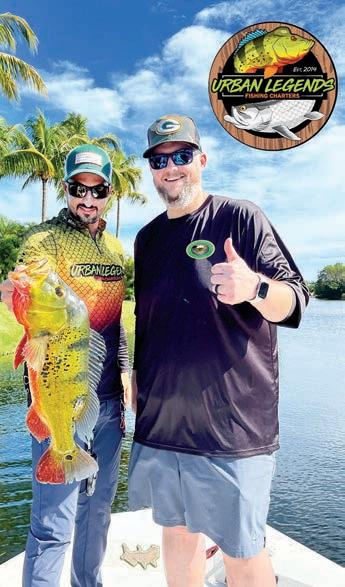
El róbalo y el sábalo se pescan generalmente en aguas más profundas con cebos vivos como sábalos americanos, sargos o pececillos. A mí me gusta pescarlos con línea libre y el truco es dejar el cebo solo, para que parezca lo más natural posible. Tanto el róbalo como el sábalo son peces muy inteligentes con ojos enormes y pueden volverse quisquillosos con un cebo vivo que no nada bien o se ve mal de alguna manera, por ello, ponga su cebo y deje que nade por su propia cuenta durante 5 minutos; a continuación, recupérelo, compruebe si sigue vivo y vuelva a sacarlo cambiando de lugar según sea necesario. Esta es nuestra regla para conseguir más picadas con estos dos peces trofeo.
Cuando usamos señuelos, el plan cambia un poco. Usamos cebos arti ciales que coinciden con los peces de cebo comunes que se ven en la zona. Pre ero los señuelos que se hunden lentamente o se suspenden en cada pausa, entre cada 4 a 5 manivelas. Las bajadas y los pilares de los puentes suelen ser los mejores lugares para pescar sábalos, en cambio, me gusta el agua en movimiento alrededor de curvas y pilas de rocas para el róbalo.
Las lubinas suelen estar cerca de la orilla, a profundidades de entre 1,5 y 1,10 metros. Les gustan las estructuras y otros lugares de emboscada donde pueden cazar sin exponerse. Estos peces suelen juntarse y engordar en esta época del año en preparación para el próximo desove, que ocurre a nales de mes y de nuevo en abril. Los pescamos con pececillos vivos, poppers y moscas con los colores de los pavos reales juveniles.
El pavón no es en realidad una lubina, por el contrario, es el miembro más grande de la familia de los cíclidos. Se cree que la denominación “lubina” se añadió al nombre común, pavo real, para atraer a los pescadores a pescarlos en Estados Unidos cuando se introdujeron por primera vez a principios de los años ochenta. Sea cual sea su nombre, son muy agresivos y especialmente violentos con los peces de su misma especie, dado que son extremadamente territoriales. También protegen a sus alevines durante los primeros meses de vida, hasta que tienen edad su ciente para sobrevivir por sí solos.
Con la llegada de las aguas más frías, intente pescar en días soleados cuando la temperatura del agua oscile entre los 72 °F y los 82 °F (22 a 27 °C) . Las temperaturas más frías del agua envían a estos peces a las profundidades y ralentizan considerablemente la picada. Si la temperatura del agua está por debajo de 60°F durante más de 3 días puede causar que la vejiga natatoria se encoja y, por lo general, esto termina por matarlos si no pueden encontrar refugio en aguas más cálidas para esperar a que pase el frente frío.
The 34” snook was caught on a nolivebaitneeded 3” paddletail in Miami
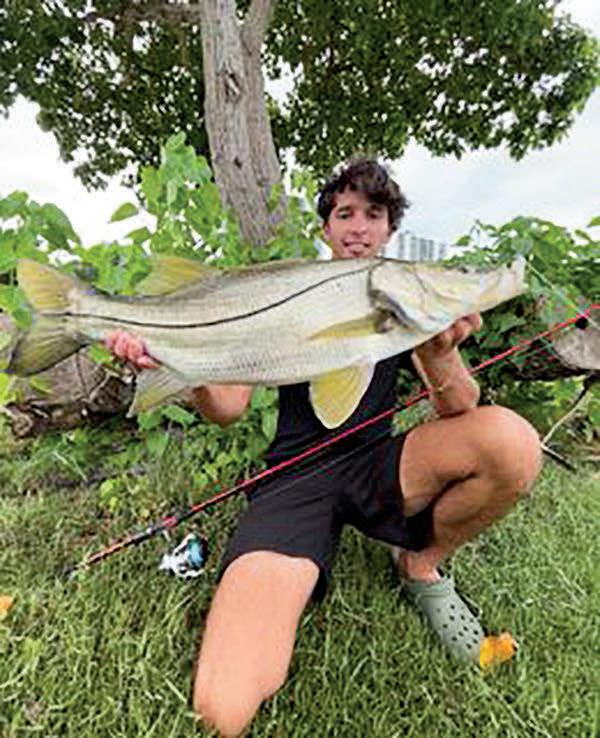
The tarpon was approximately 110 lbs, caught on a nolivebaitneeded 5” paddletail in Miami



The 30” cubera snapper, 15 lbs, was also caught on a 5” nobaitneeded paddletail in Miami.
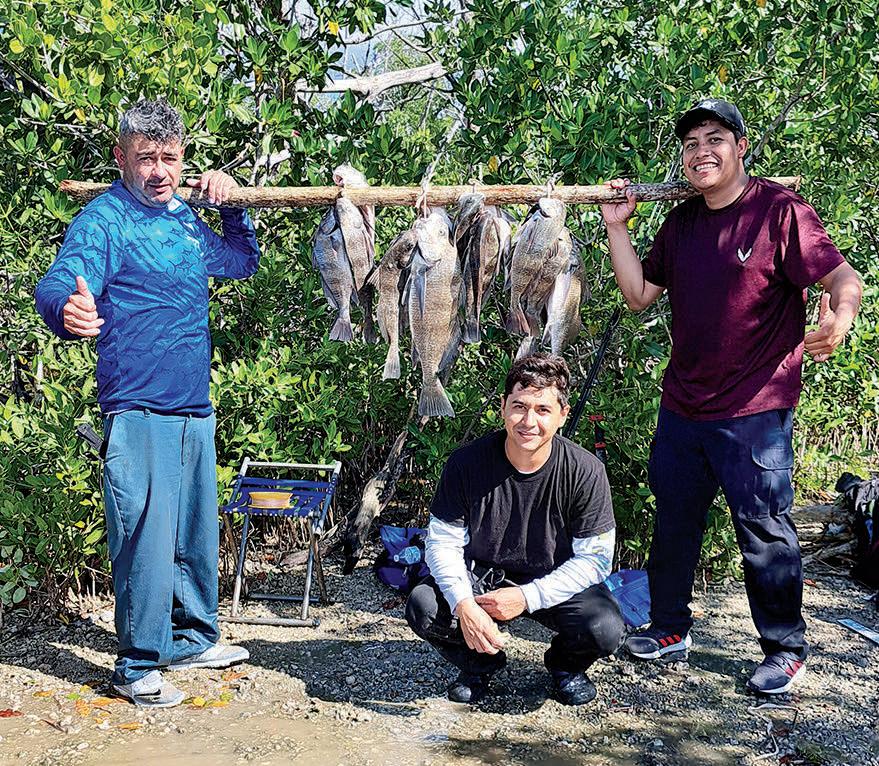

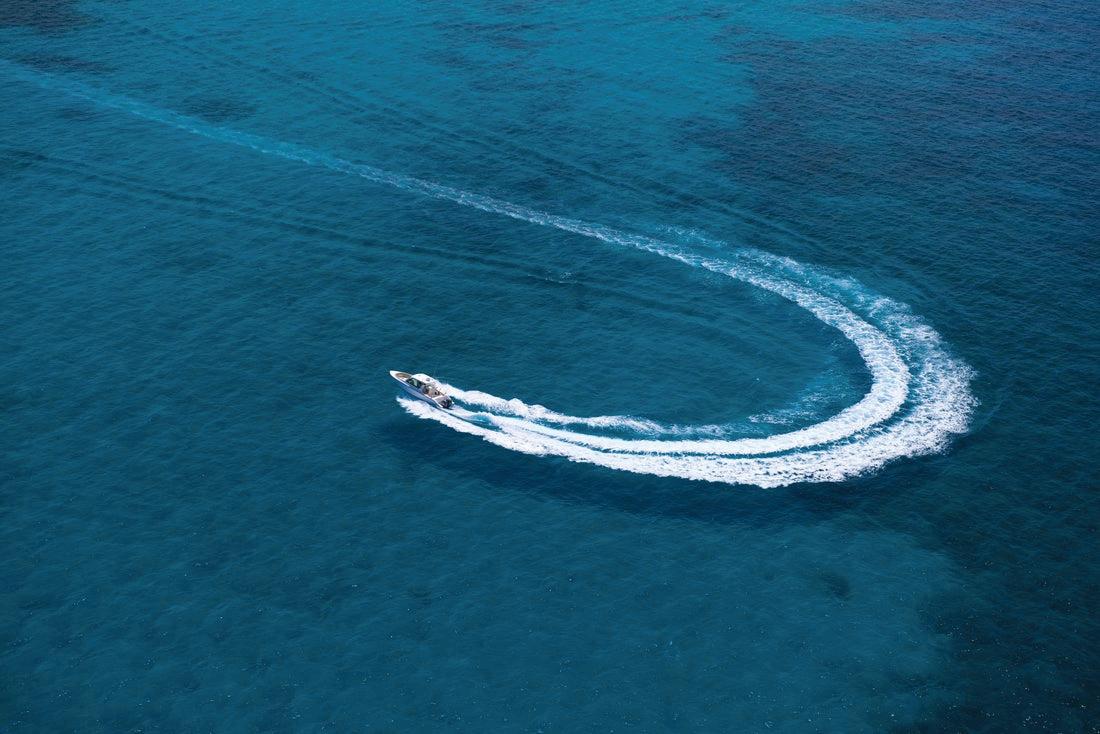


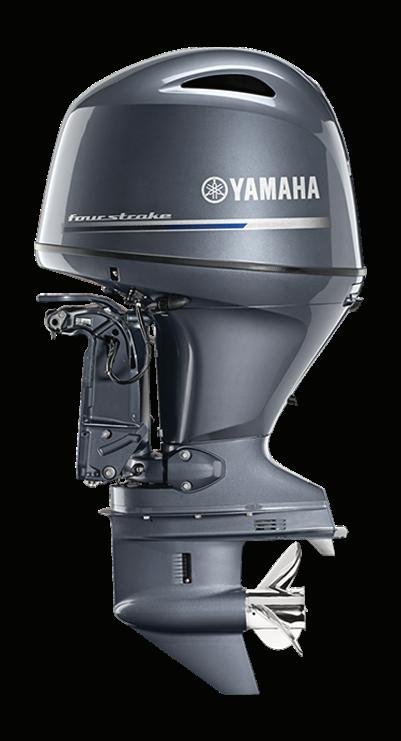
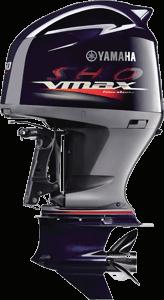


Over the next few months, waves of sh will ood the shallows to spawn. is presents the opportunity to catch some monster bass, and a plastic worm is always a main player for me when it comes to the spawn.
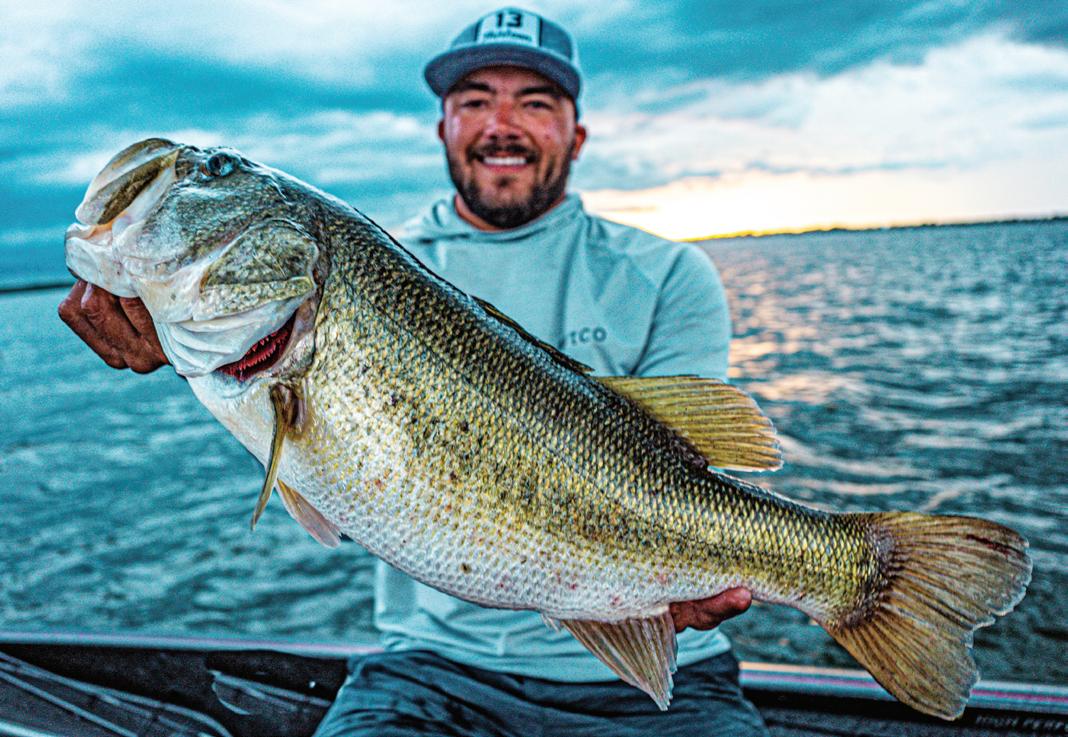

A Texas-rigged stickbait is a very common technique, but many people use it ine ciently by casting to a lot of dead water. I try to maximize productivity by casting to high-percentage targets. I focus on isolated cover. In the South, this could be small patches of grass and groups of pads, where spawning females are hidden from the naked eye. In other parts of the country, the structure might be wood or rock. Make multiple casts and work these areas slowly. I use a bigger-style stick bait, normally in the 6” version. Darker colors like a black and blue tip are my go-to. I use lighter 1/16- or 1/8-ounce weights to keep the bait looking natural. Use heavier line to cast around thick cover for large sh, but avoid braid which might be visible to sh in shallow water. I like 17- to 20-pound uorocarbon.
When I want to cover more water and locate sh, slowly reeling a big speed worm-style bait works great. e vibration the tail gives o drives sh crazy. It’s an awesome way to nd sh before slowing down to pick the area apart. I like darker colors like a junebug when the water has some stain and gravitate to more natural green pumpkin with some ake when the water is cleaner. I use ¼- to 1/8-ounce of weight and 15- to 17-pound uorocarbon.
A wacky rig is also e ective when sh are shallow. I sh it just like the Texas-rig in isolated cover, but I sh it weightless. is is great for heavily pressured sh. I use lighter line in the 10- to 15-pound range and a spinning rod for a wacky rig.

Flipping a worm is the last technique I will cover. is allows you to put a bait in places other styles don’t allow and e ciently pick apart heavy cover. I use a large Senko-style so plastic, and braided line is a must. I like 3/8 to ¾-ounce of weight, depending on the thickness of the cover. Remember, the only way to set yourself apart is to slow down and put your bait in places nobody else has.
Except for the wacky worm, rod and reel choices for each technique are similar. I like a longer 7’6” medium-heavy to heavy action rod for most worm shing. e 13 Fishing Omen Series has a few rods that are perfect for the job. I use a faster-speed reel like the Concept A 7:5:1.
For the wacky worm, I like a 7’ 3” spinning rod in medium-heavy. A reel with good drag is important, and I’d recommend the Axum from 13 Fishing.
Tyler Woolcott is a professional tournament angler and guide. Check out his website at www.tylerwoolcott shing.com.


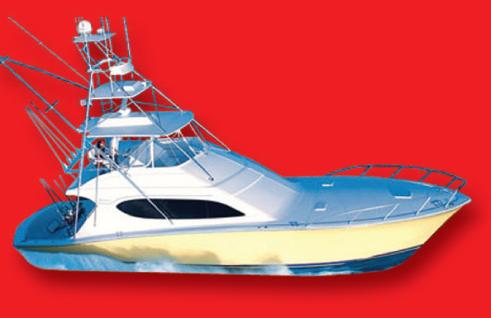
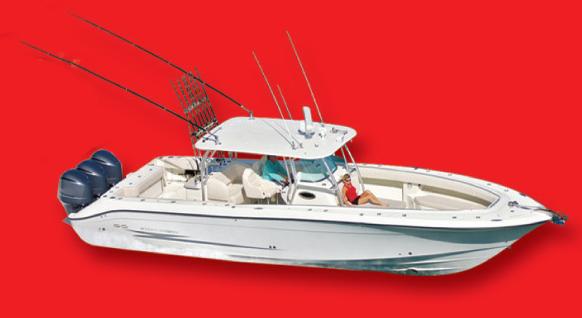
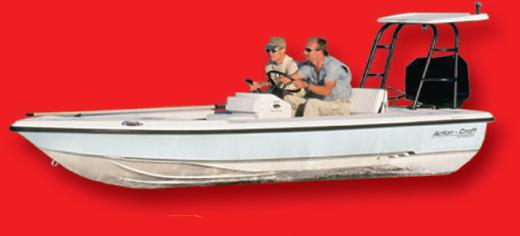



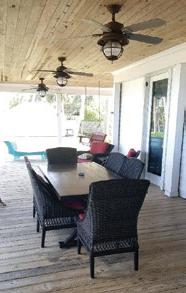
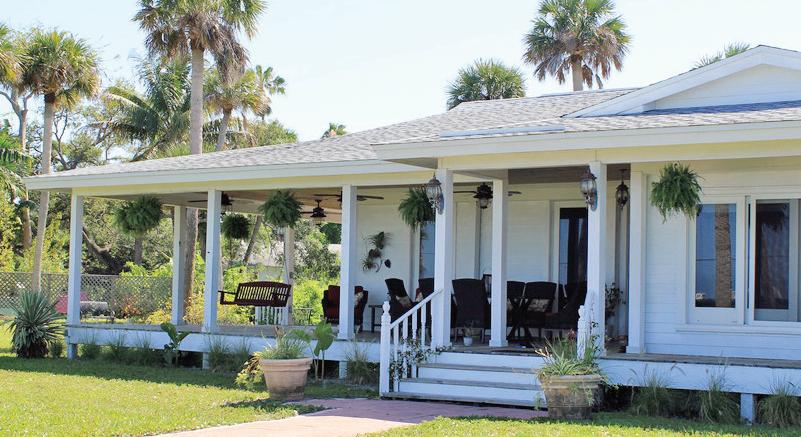
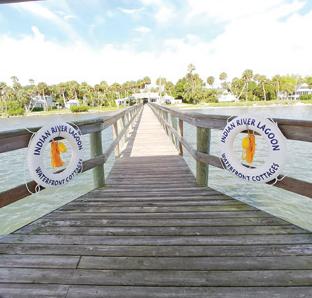
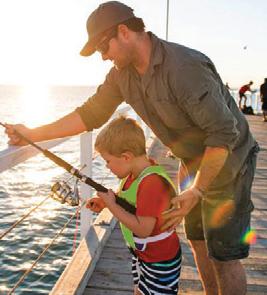







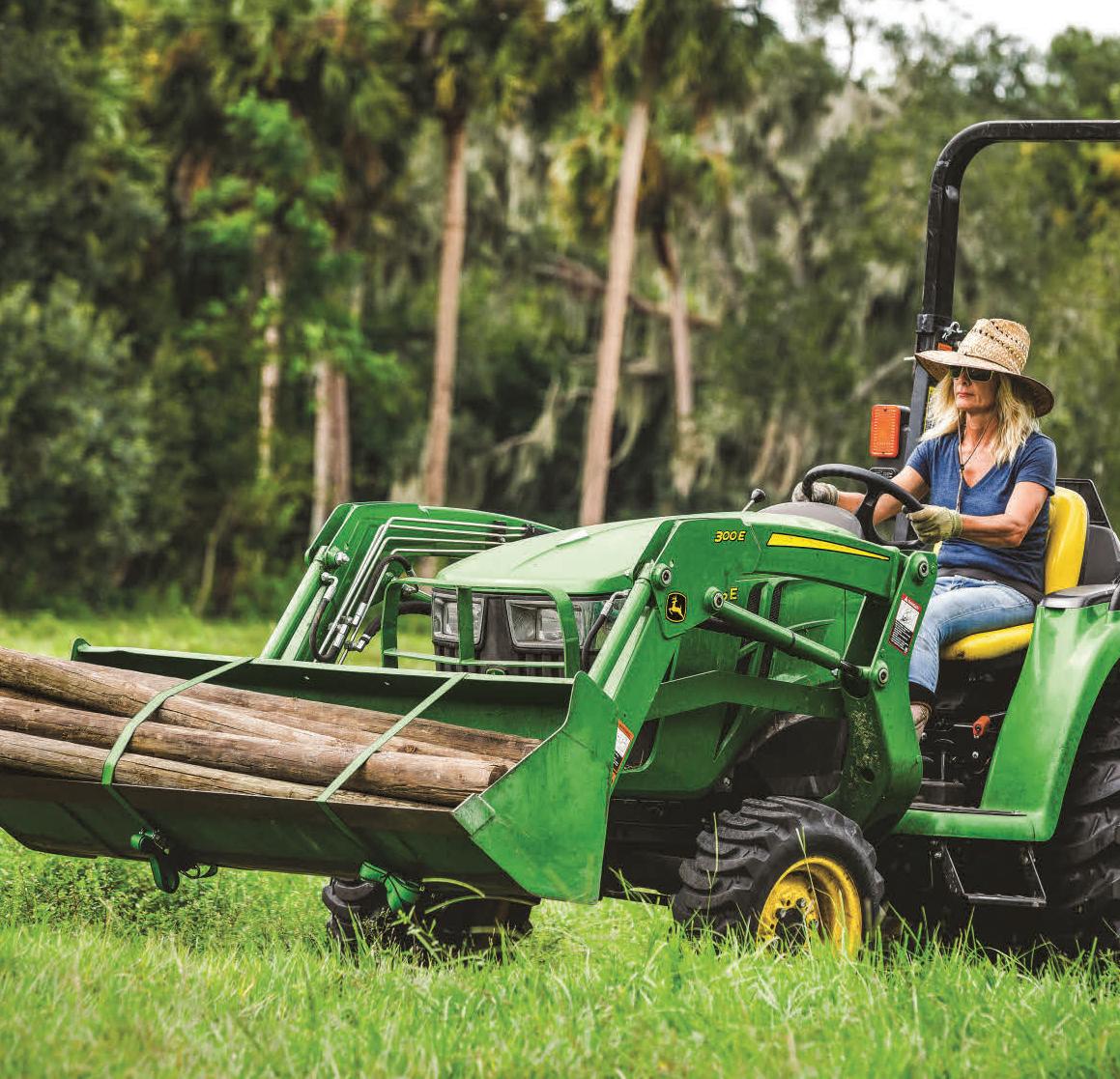





Since 1990, CraigCat has offered big performance in a compact, easy-to-use package! Their (DSTS) Dynamic Sport Tuned Suspension system, and (CHD) Calibrated Hull Design give you the smoothest ride and high-performance fun that no one else can duplicate, even in less than favorable conditions. Their (ASC) Automatic Stability Control gives the driver and passenger confdence in almost any conditions.





Whether it is fresh or saltwater, fshing or sightseeing, CraigCat has the right model for you! They have taken the CraigCat to a whole new level with the exclusive package. Loaded with amenities, the CraigCat E2 Elite features a premium JBL highdefnition sound system with USB and Bluetooth connectivity, custom deluxe bucket seats, full-width composite storage compartment, convertible Bimini top, ion docking, NAV, position, and LED courtesy deck light. They offer a wide range of accessories like the very popular GPS navigation system with down imaging sonar, wing storage racks for additional storage, polished stainlesssteel propeller, and the list goes on.

Portability is a big thing when it comes to boats. Not only is a CraigCat very portable with a total weight of 550 pounds, practically any car can tow a CraigCat with the combined weight of 800 pounds, boat and trailer. High quality and great value are what you get with a CraigCat.

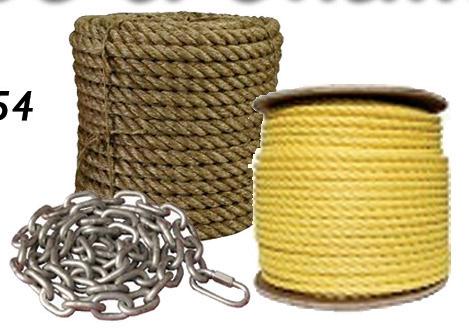
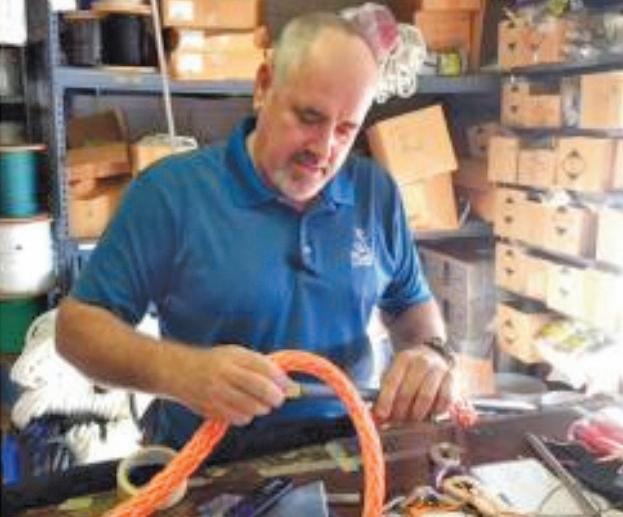





With costs sky rocketing out of sight in the marine business, the CraigCat is very affordable. The E2 Elite 25hp model complete is only $13,485!
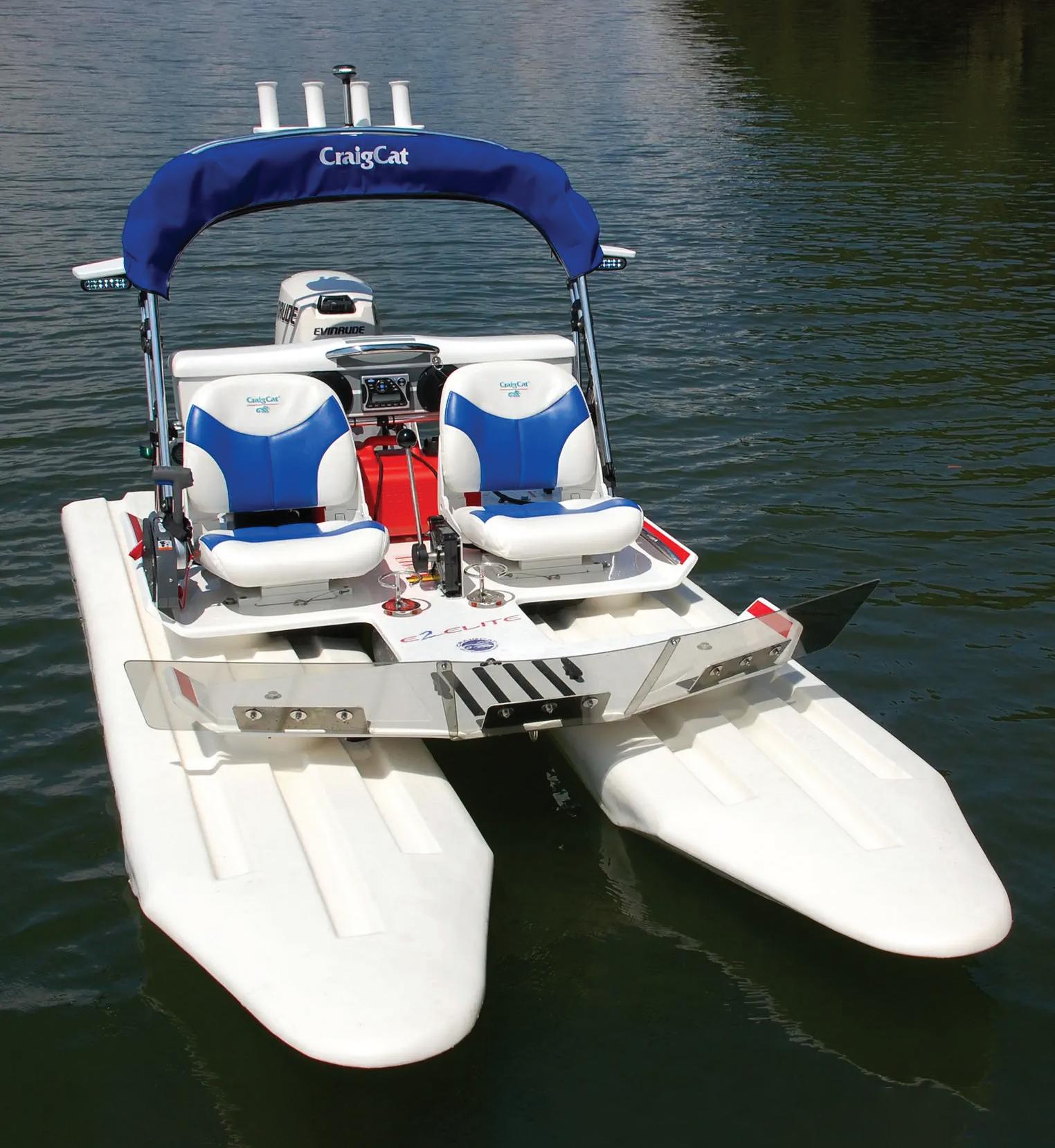



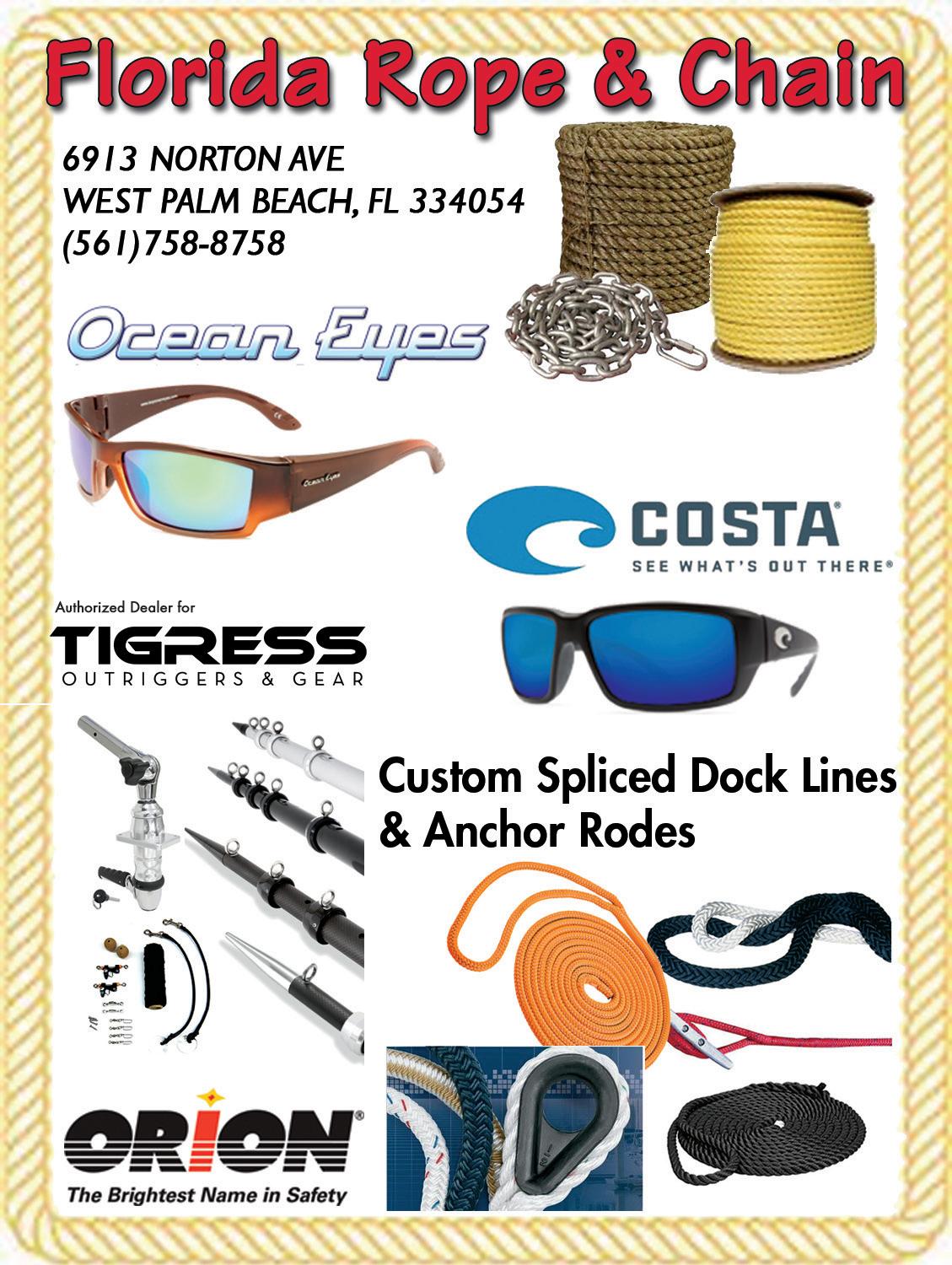



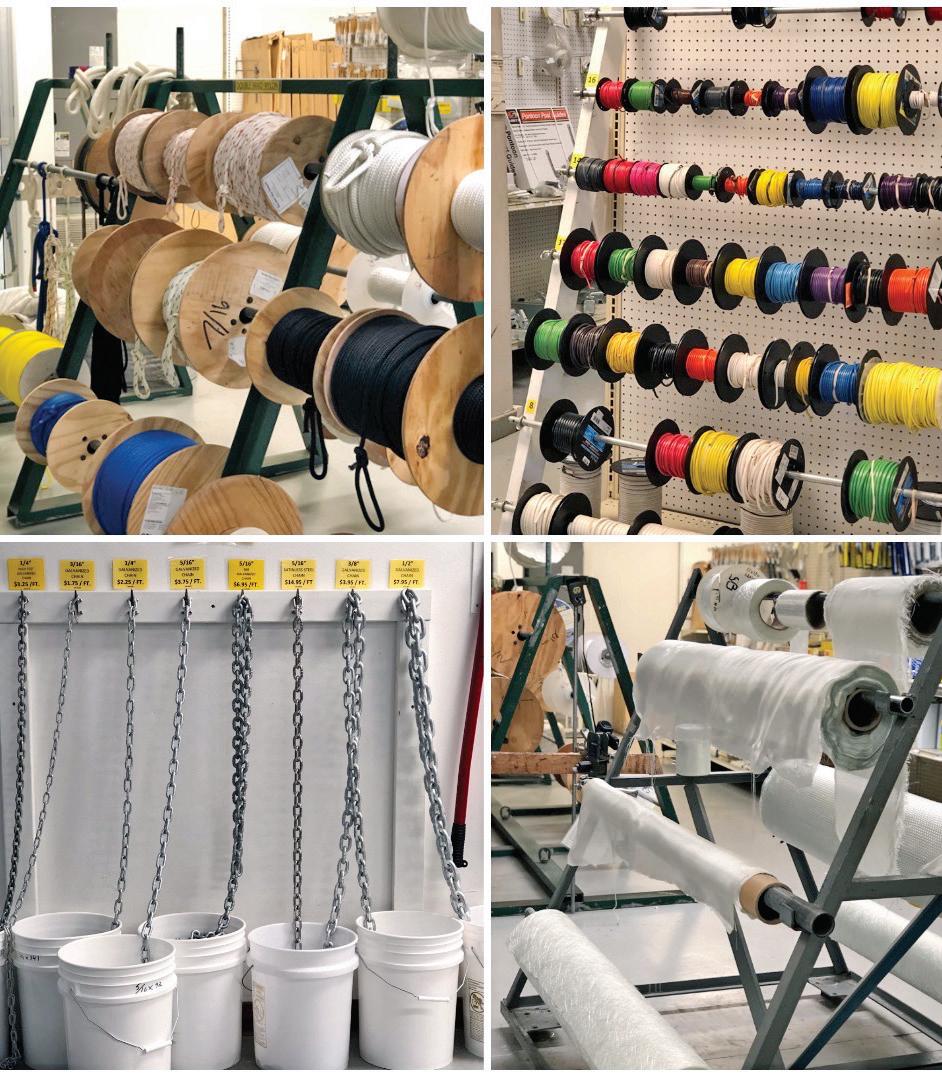
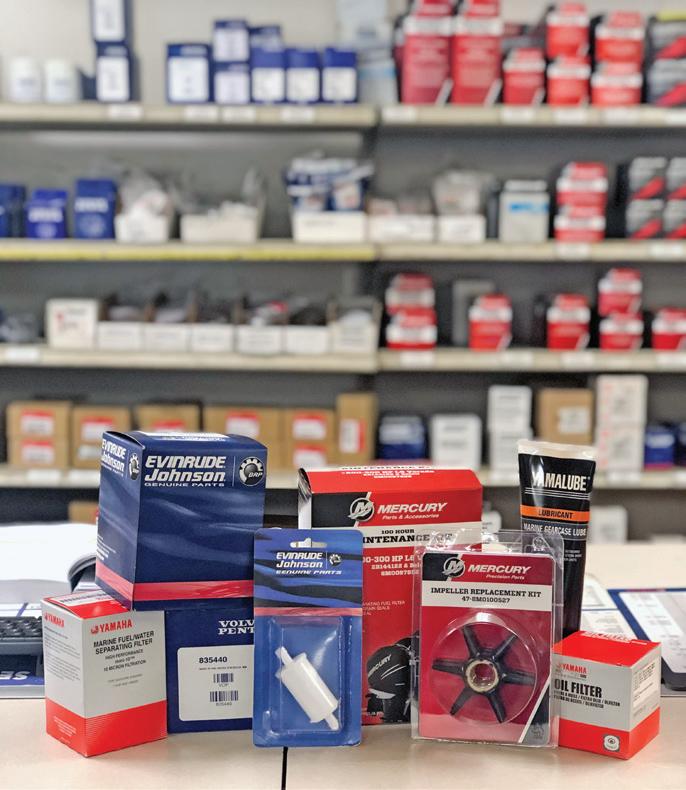
















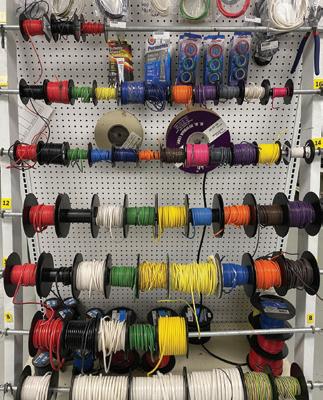
Here’s a memorable beach moment: You’re basking in the warm sun, toes in the sand, letting the gentle turn of the foam-capped waves lull you into a state of complete relaxation. As your eyes scan the endless horizon of blue on blue, you’re rewarded with a school of dolphins making their way across the sea. There’s no denying their signature shape as they leap from the water. If you don’t see anything else extraordinary the rest of the day, you can take solace knowing you’ve witnessed one of nature’s most playful and intelligent creatures in their natural habitat.
Why not re-create that special toes-in-the-sand moment with our Blue Topaz Dolphin Pendant? The beloved sea mammal has been captured mid-jump in sterling silver. And, tucked into its fins is a full two carats of shimmering blue topaz. Nothing captures the shimmering color of the ocean in the midday sun like blue topaz. With its sparkling clear blue color and high refractive index, blue topaz is one of the top-selling blue gemstones. And with our special price, you have quite the catch. Satisfaction guaranteed or your money back. Enjoy the Blue Topaz Dolphin Pendant for 30 days. If it doesn’t pass the test swimmingly, send it back for a full refund of the item price.

Limited Reserves. A full two carats of genuine blue topaz set in sterling silver for this price is as rare as a dolphin sighting. We cannot guarantee availability for long. Call today!

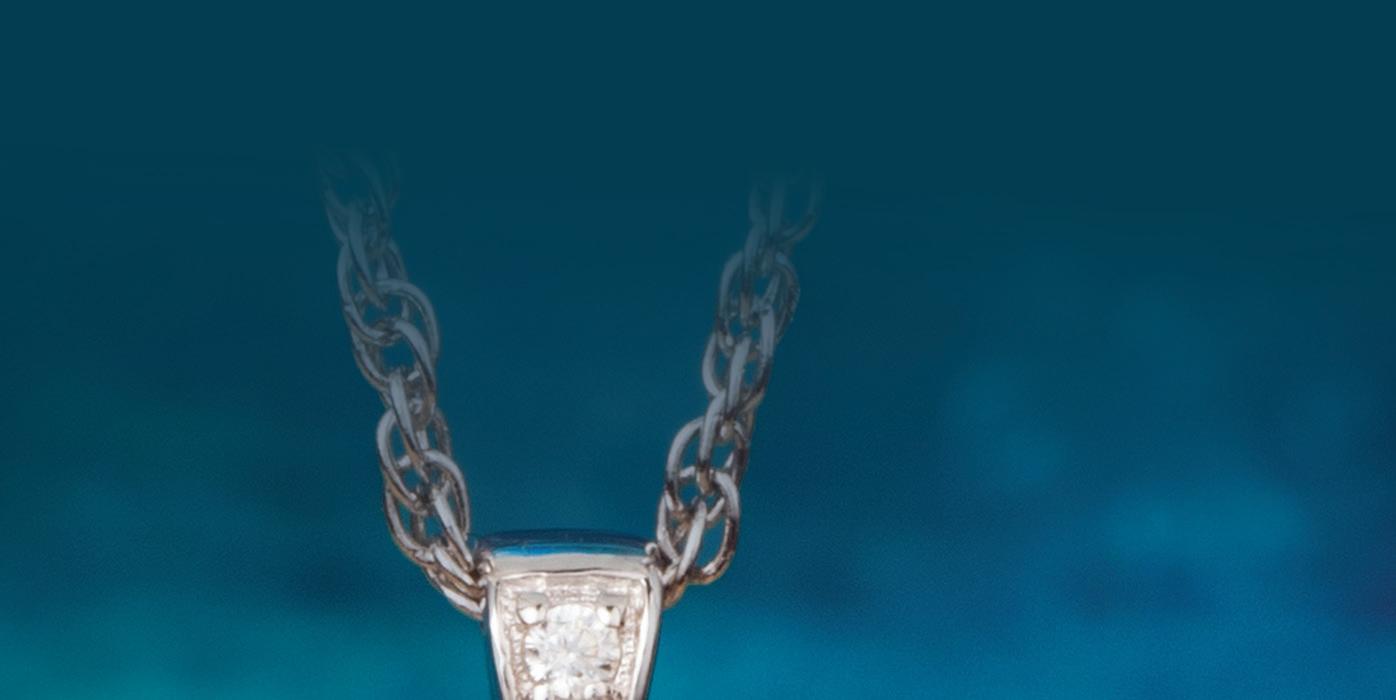
Stauer… Afford the Extraordinary ®



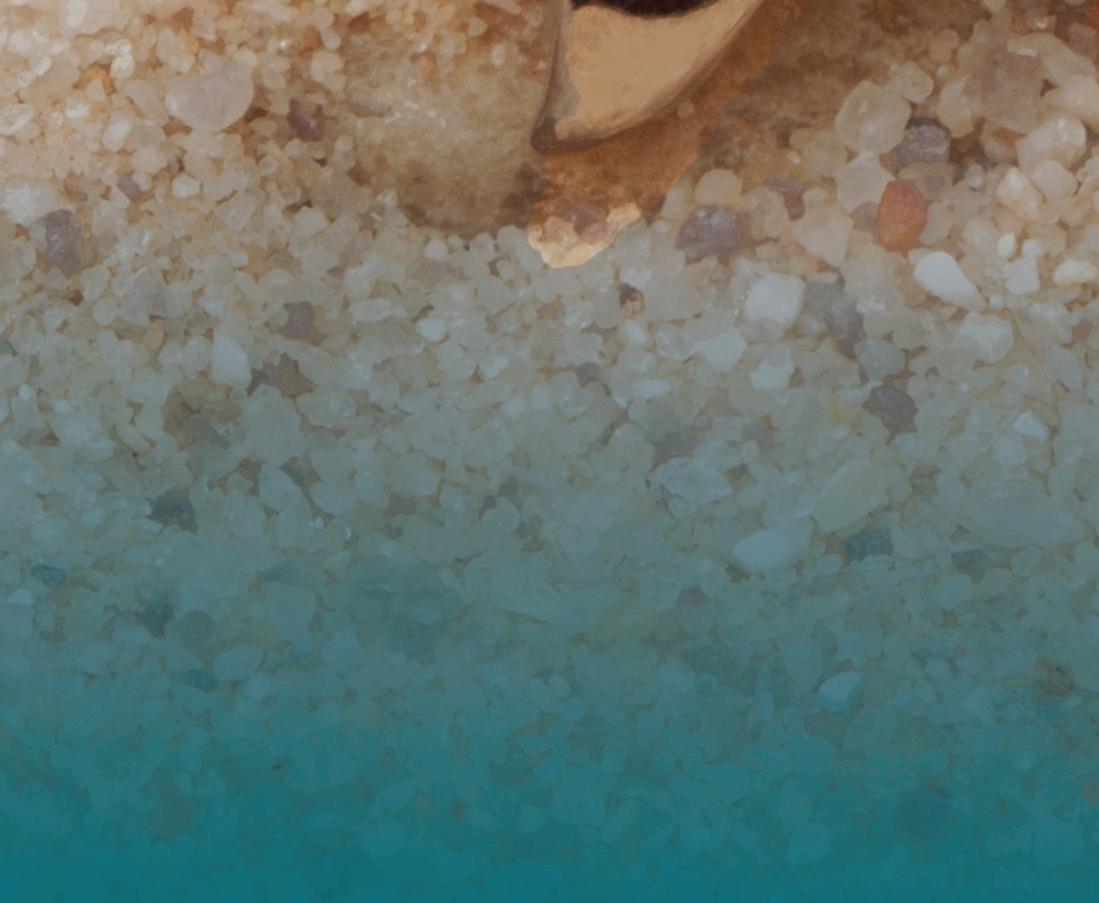


The 2023 Academy Sports + Outdoors Bassmaster Classic—widely known as the “Super Bowl of Bass Fishing”—will be held March 24-26 in downtown Knoxville, Tennessee and on the University of Tennessee Campus.
e Bassmaster Classic is one of the world’s most prestigious championship tournaments and pits 55 of the world’s best bass anglers against one another for the title of Bassmaster Classic Champion. e Classic is a catch-and-release event, with bass being returned to the shery under the supervision of the TWRA.


Daily takeo s will be from Volunteer Landing on the Tennessee River in downtown Knoxville each competition day, and weigh-ins will take place in the ompson-Boling Arena on the University of Tennessee campus. e fan favorite Bassmaster Classic Outdoors Expo will be held Friday through Sunday, March 24-26 in the Knoxville Convention Center and the adjacent World’s Fair Exhibition Hall.
All activities and venues are free and open to the public.
For more information, visit Bassmaster.com.
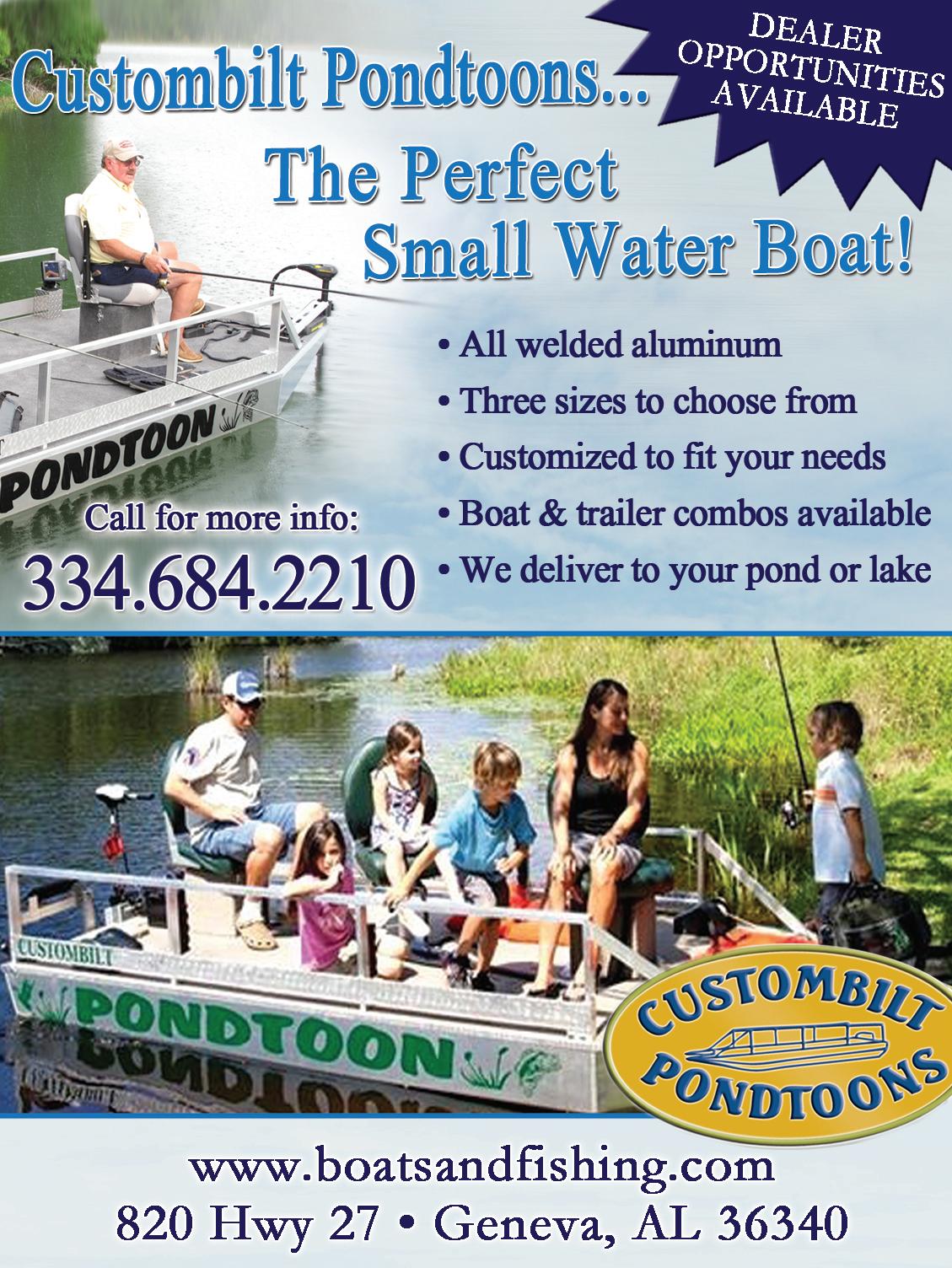


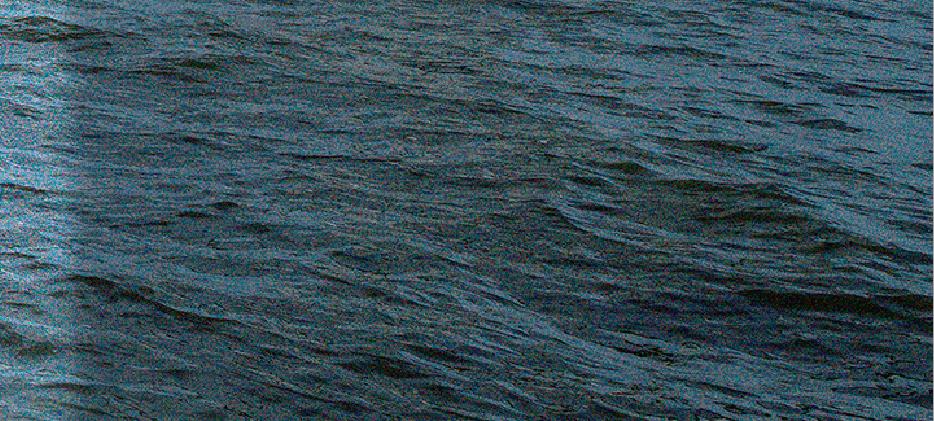

C-Hawk Boats has made a name for itself among boaters who want no-nonsense, custom-purpose vessels that are designed to perform and built to last. Owner Brad Grubbs said their C-Hawk 25 Center Console is an endlessly customizable boat that has gained a lot of fans among charter captains who fsh them hard every day. “We have 10-plus guides using them on the west coast of Florida,” he said. “In Georgia and South Carolina, they’re using it as a small passenger ferry. In Chesapeake Bay, it’s a crab boat.”


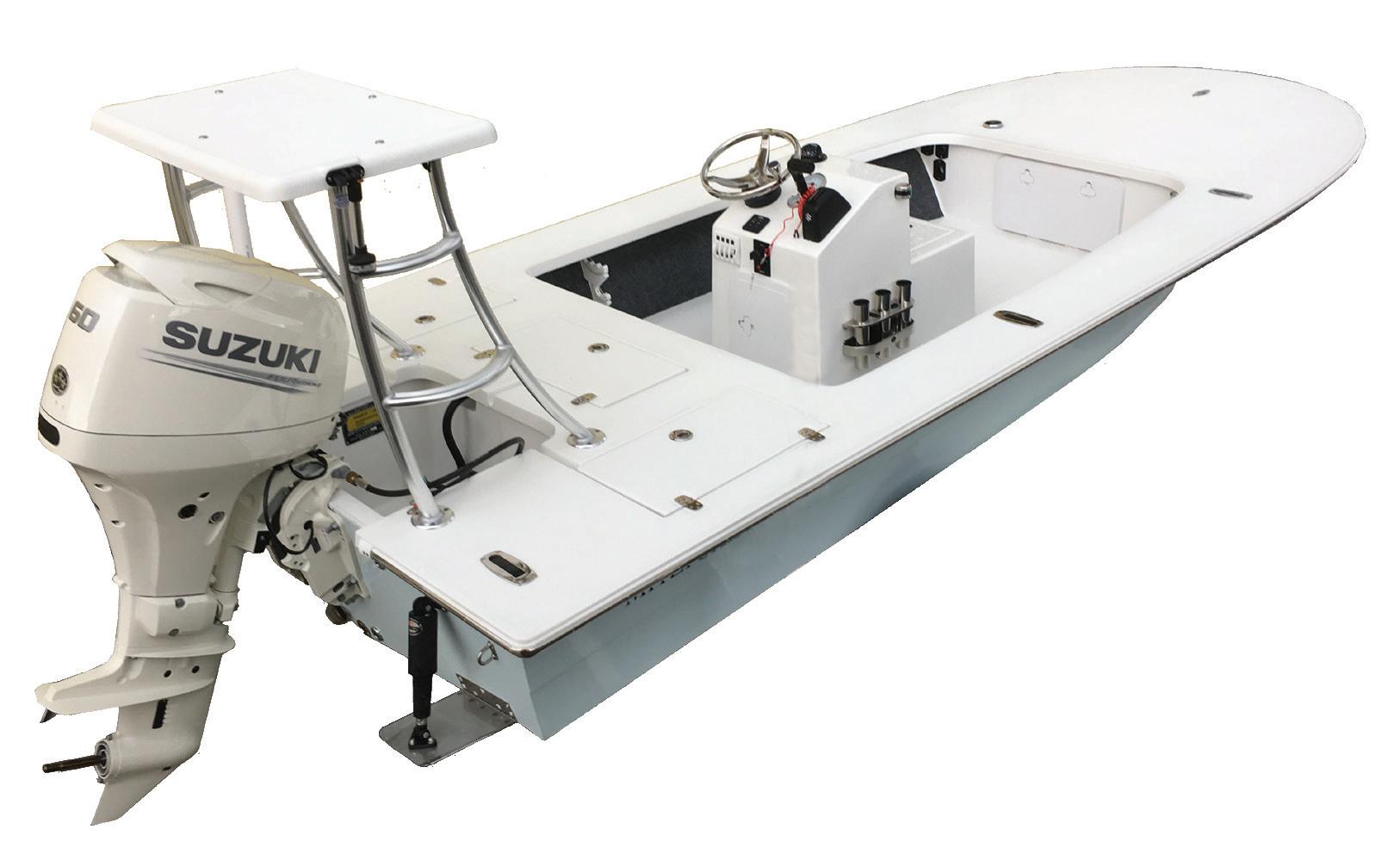

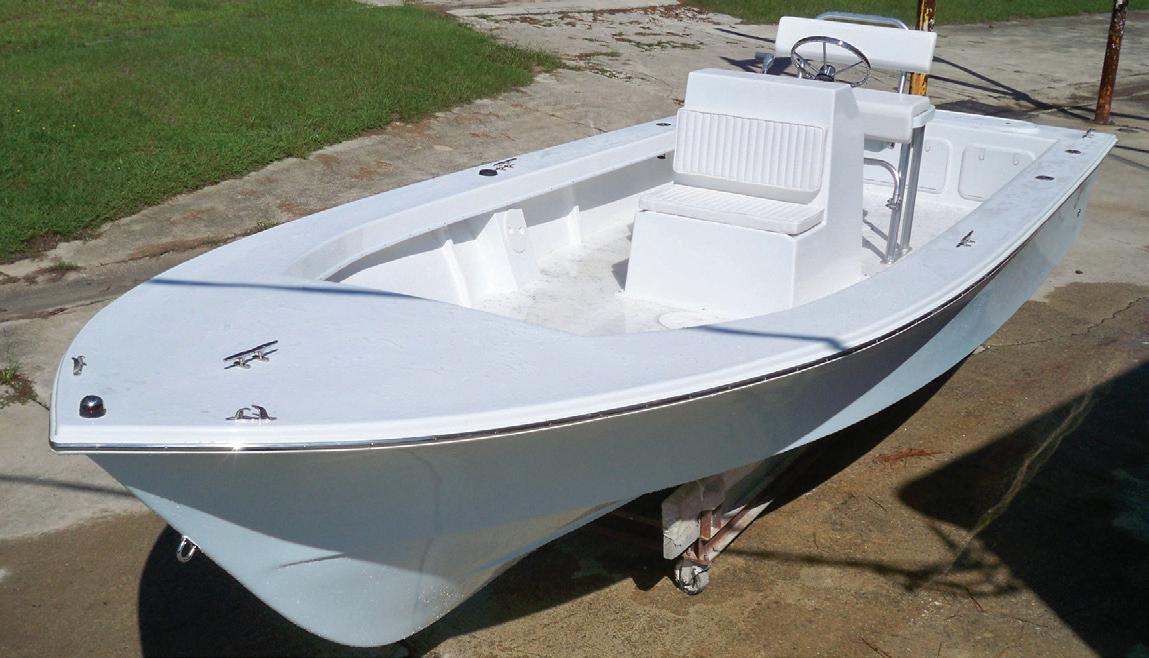
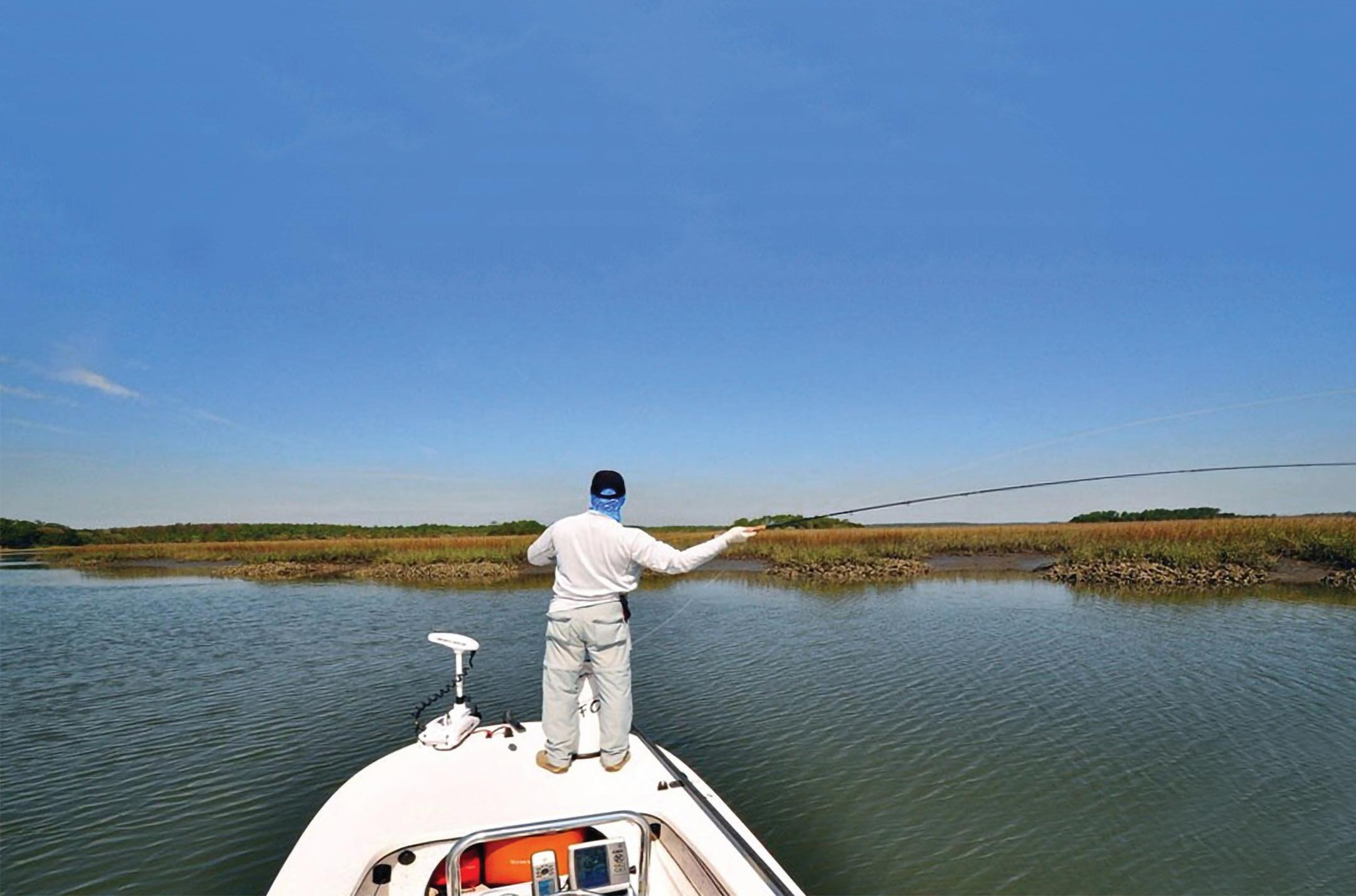
At its core, the C-Hawk 25cc is a hard-core workhorse with a 300 horsepower maximum that will take you anywhere you need to go. Its 9’6” beam allows it to foat in very skinny water with just a 12” draft, and it is also extremely stable, which should appeal for bottomfshing, diving and any other pursuit where a stable platform is preferred. Whatever you plan to do with it, all C-Hawk boats are built battleship tough to commercial-application standards. They are designed to withstand hard use for years of trouble-free boating, and you can customize your C-Hawk from the factory in any way that suits your purpose.



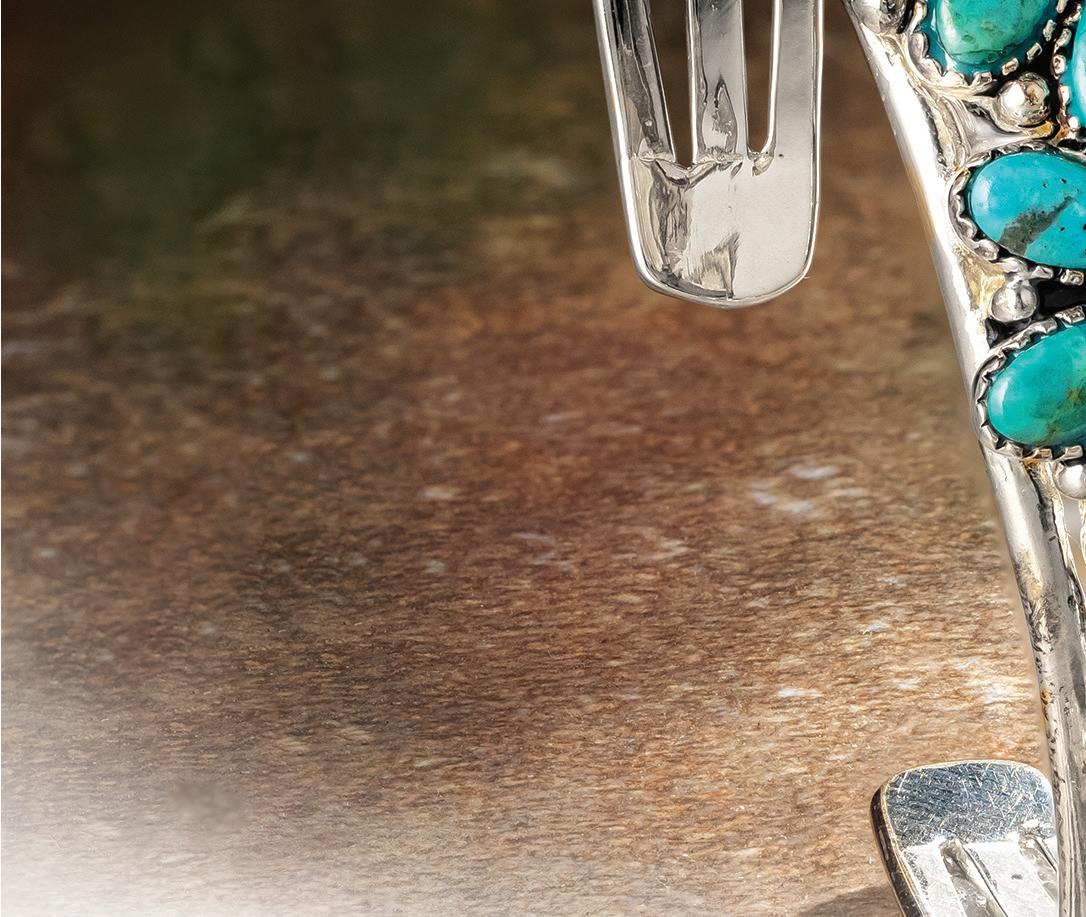
“We can mix and match consoles, fsh boxes, full transoms, cut transoms, bare hulls… you name it,” Grubbs said. “There are some recreational guys adding towers and sight fshing for cobia, and such. Everything we do is built around keep it simple, keep it effcient, keep it easy to maintain, keep it cost effective to own and operate. They are all unique… no cookie cutter trailer queens here. The 25 is a great example of what C-Hawk is.”

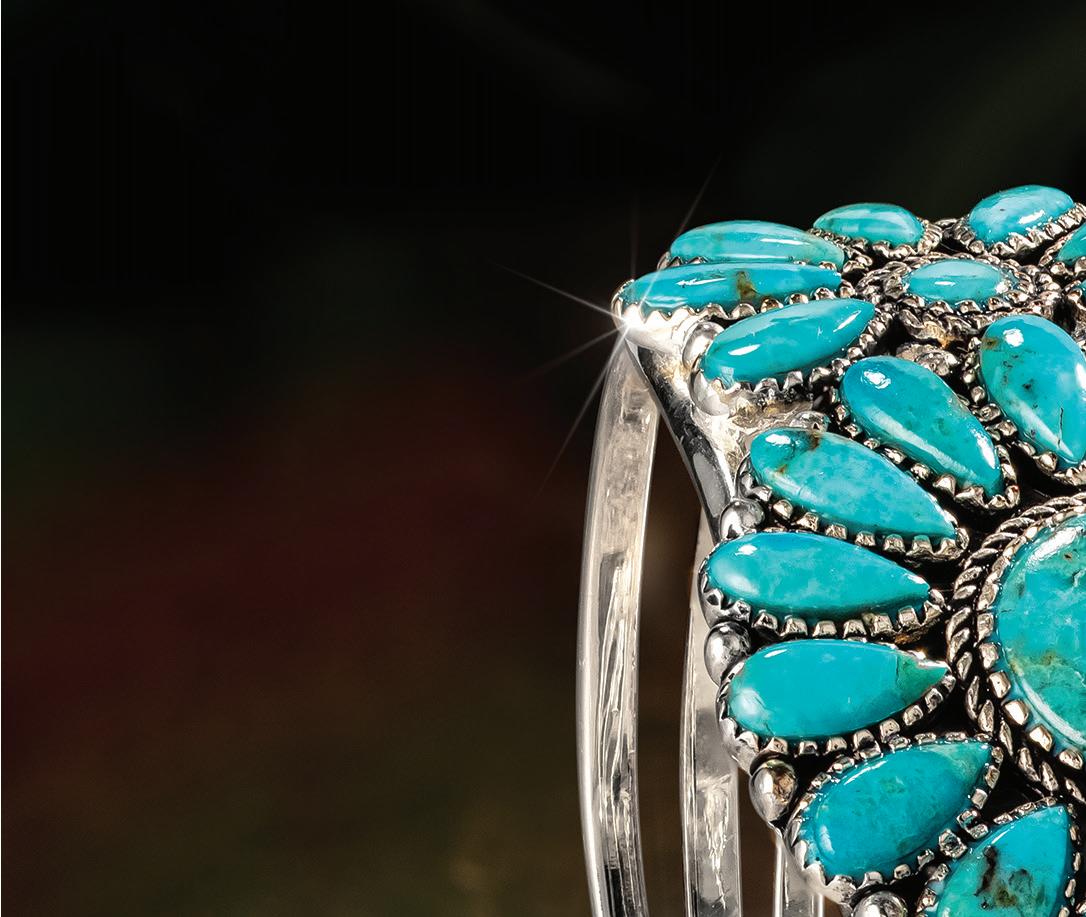
Old Pete was a retired stuntman bursting with stories. There was the time he stared down a grizzly bear. There was the time he won a competition and got to kiss a Hollywood starlet as the prize. And there was the time he got into a fistfight with the Duke. Many stories. Some were probably even true. I know two things for sure: that he had an excellent collection of turquoise and that he owed me for a poker game he lost. The last time I saw him, he opened a drawer and pulled out a collection of beautiful Navajo turquoise jewelry to repay his debt. Pete’s jewelry inspired our Tucson Sun Turquoise Collection. This jewelry set features turquoise that’s been gently enhanced to bring out its finest shades in a Southwestern motif. Finished with oxidized silver, this jewelry set captures the beauty and mystery of the Arizona desert. The rarest and most valuable turquoise is found right here in the American Southwest, but the future of the blue beauty is unclear. I recently spoke with turquoise traders who explained that less than 5% of turquoise mined worldwide can be set into jewelry. Once thriving, many Southwest mines have closed.
But Stauer saw this coming and is now one of the largest owners of gem-grade turquoise in the U.S. Don’t miss your chance to own the diamond of the desert. Act now. This is one of our fastest sellers, and we only have a limited supply of Arizona turquoise available for this ad. See why Stauer remains the best bang for your buck!
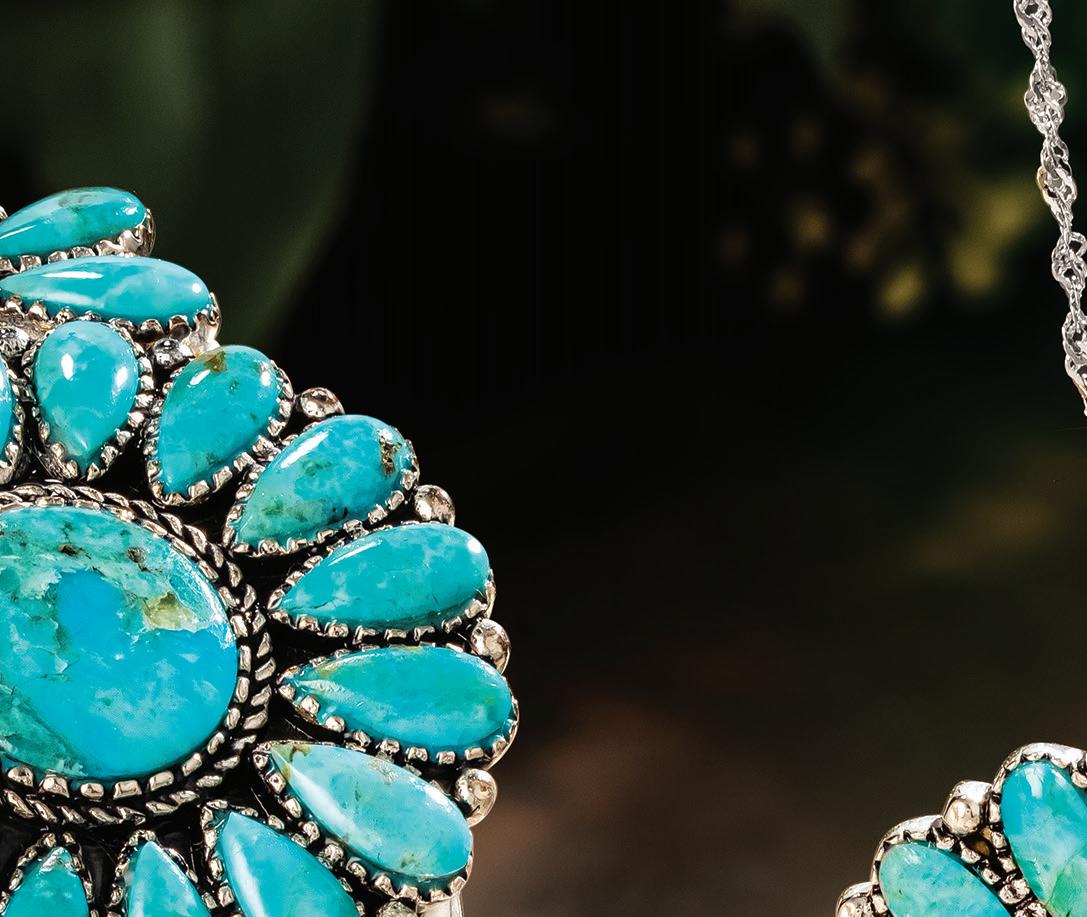
Jewelry Speci cations:


• Arizona turquoise. Oxidized silver finish. Ring: whole sizes 5-10. Pendant: 1 ¾" drop. Cuff: fits wrist to 7 ¼".
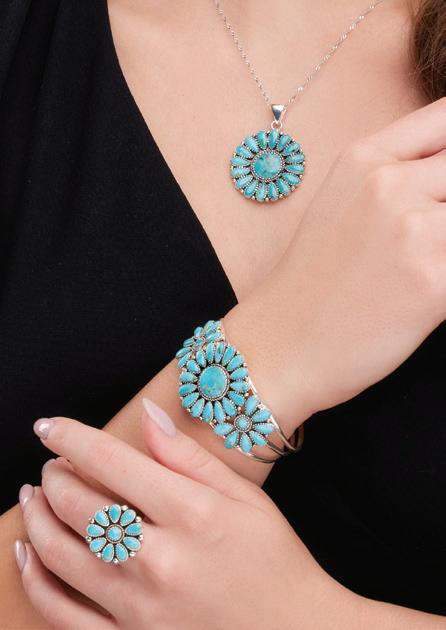

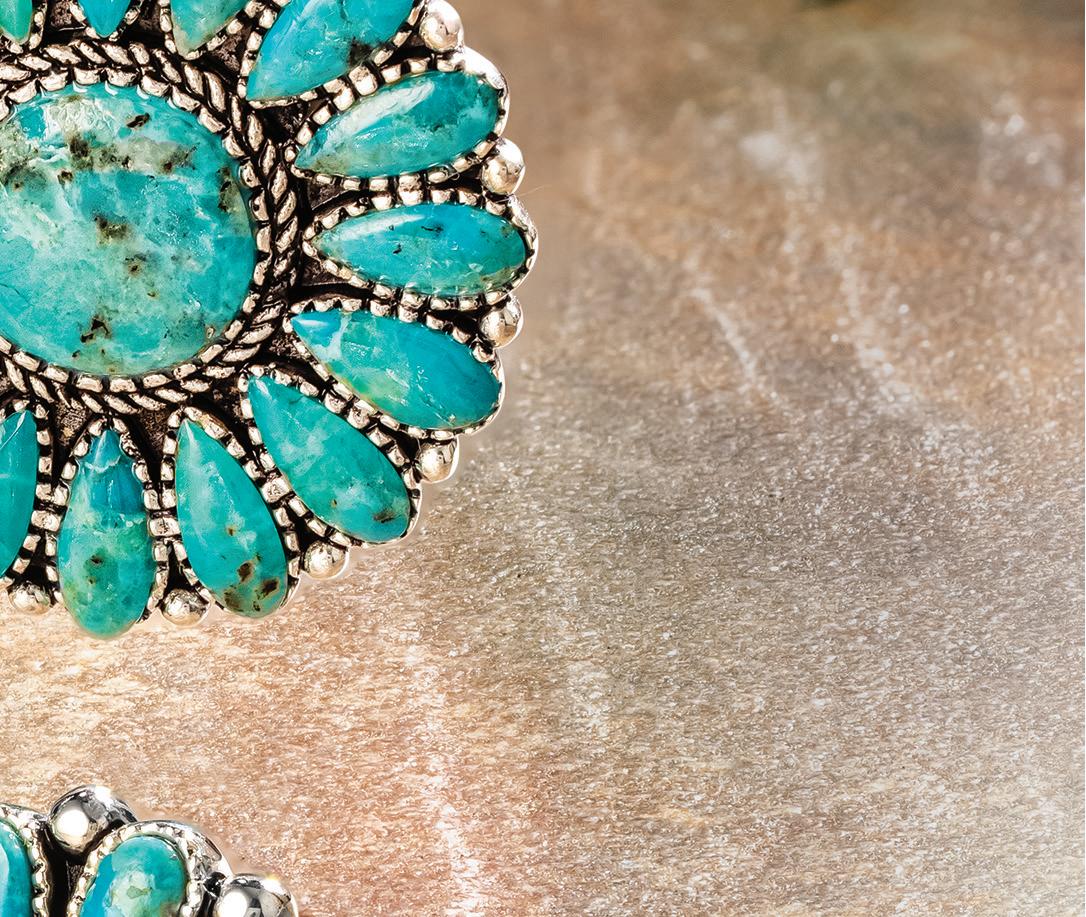
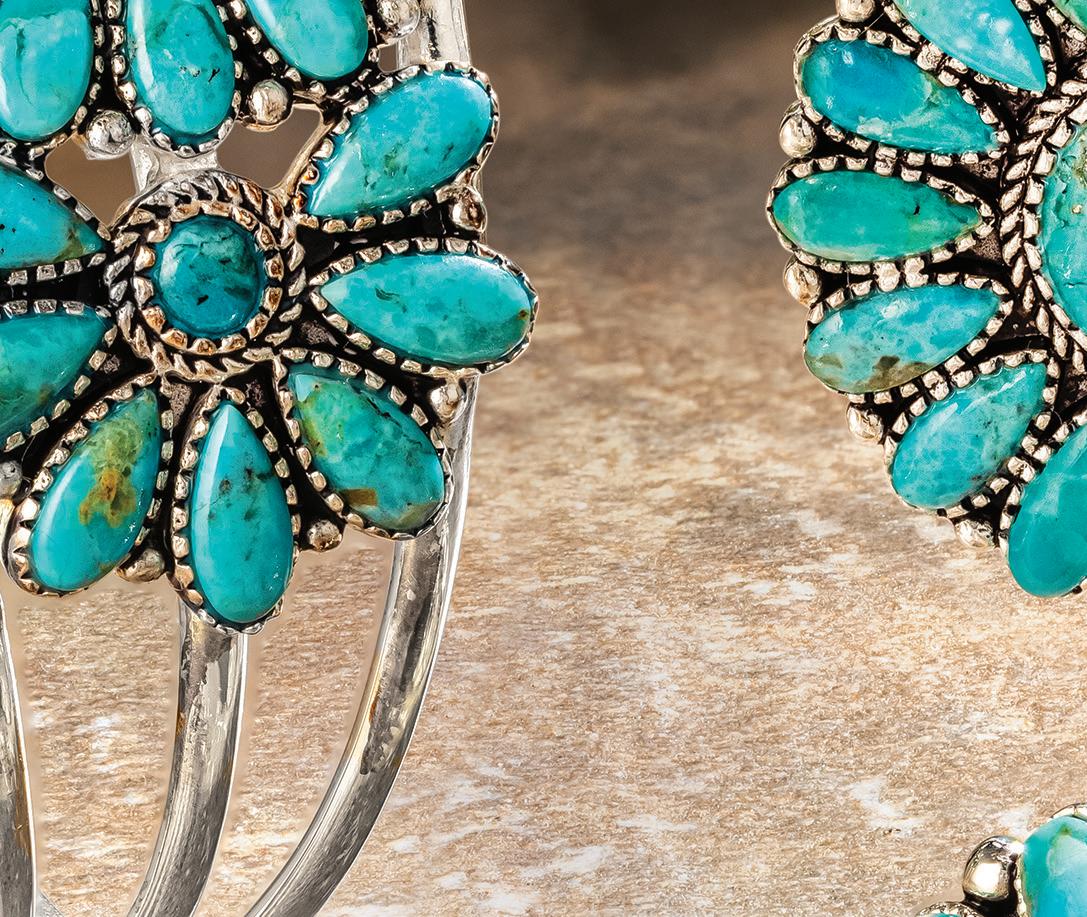

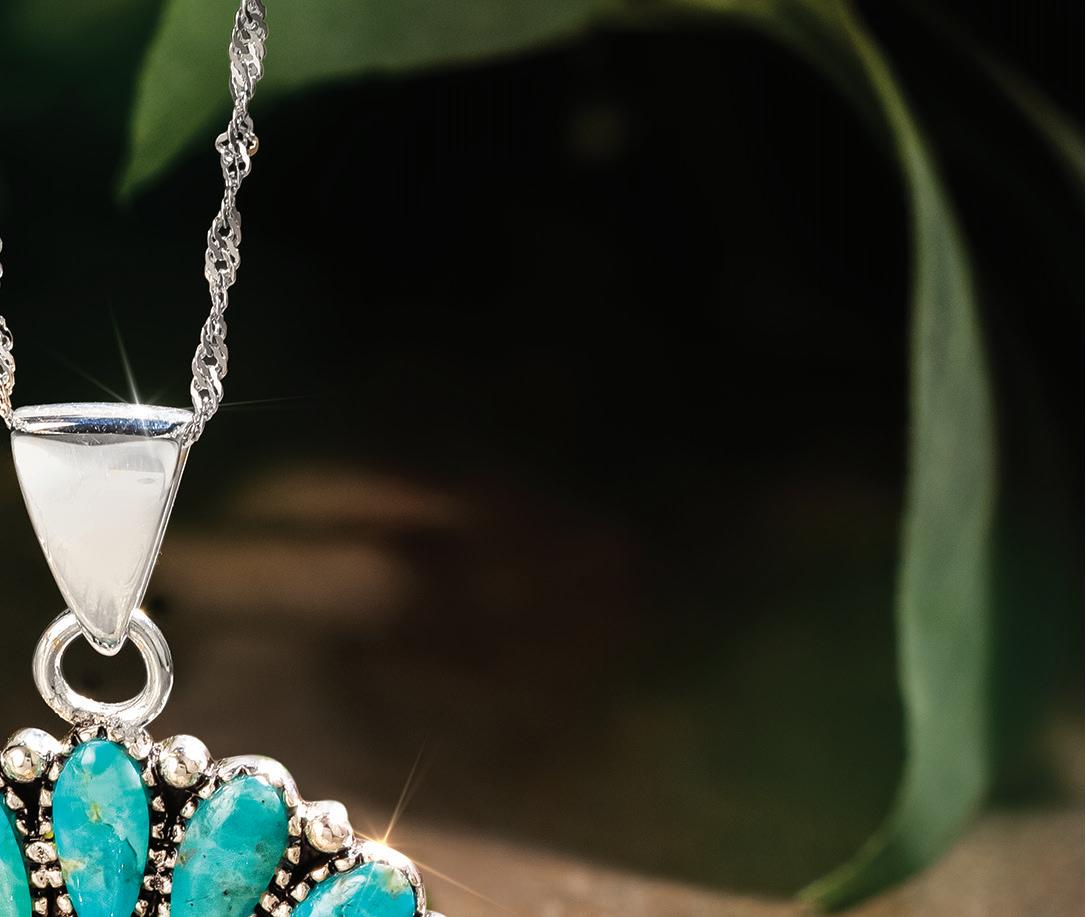
Stauer, 14101 Southcross Drive W., Ste 155, Dept. TSC130-01, Burnsville, MN 55337 www.stauer.com

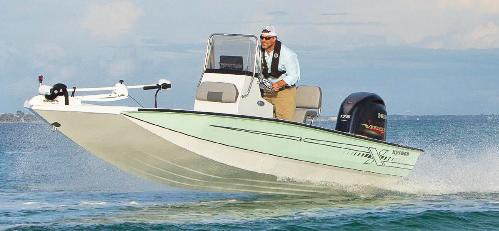
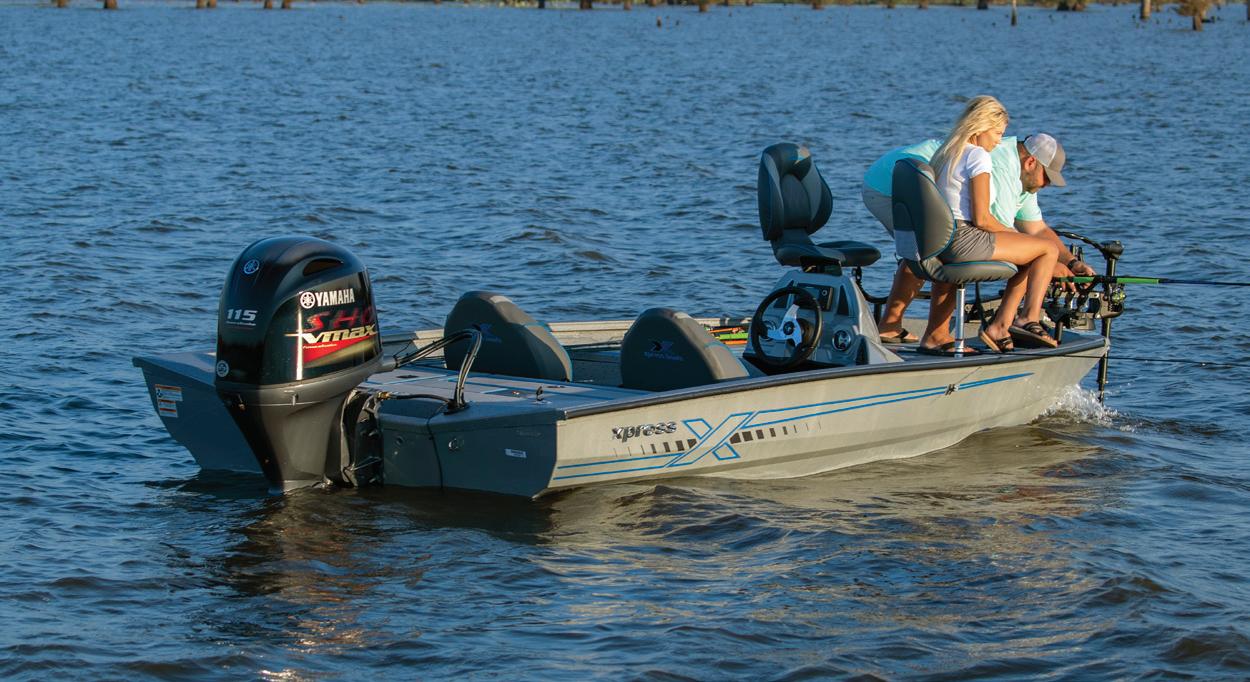




Introduced in the New Product Showcase at ICAST 2022, the all-new MHX HD Rod Rack is the ultimate shing rod storage system with space for up to 20 of your favorite rods.
Constructed from Marine Grade HDPE material, it will never rot, warp or damage your tackle. Assembled with stainless steel hardware, no environment is o limits. Whether used on the dock for a post-trip wash down or just to help organize your garage and tackle room, this rod rack is a solid piece of equipment designed for serious anglers.


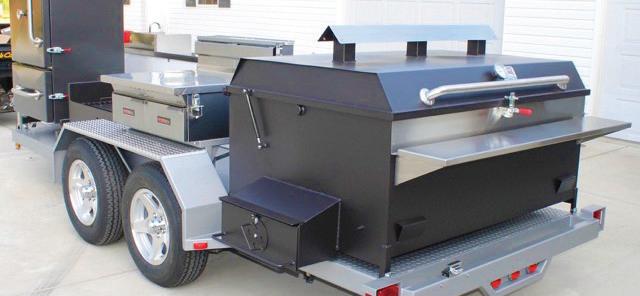
From y and light-tackle rods to heavy o shore rods, each rod’s ghting butt sits in CNC Milled recessed cups to add stability to all handle styles. e MHX HD Rod Rack has the size and the brawn to handle your full arsenal, indoors or outside. It even comes with four supports that lock in heavy duty bent butt o shore rods.

Measuring 26” x 16” x 8”, this heavy-duty, multi-purpose rod rack is easy to assemble and will nd a perfect place on your boat or dock, in the garage, or at the shop.
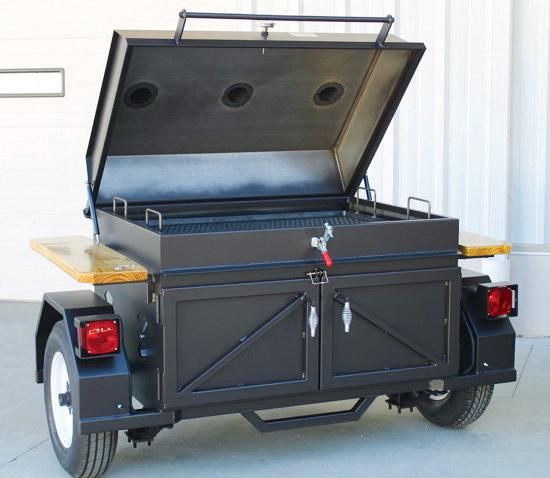
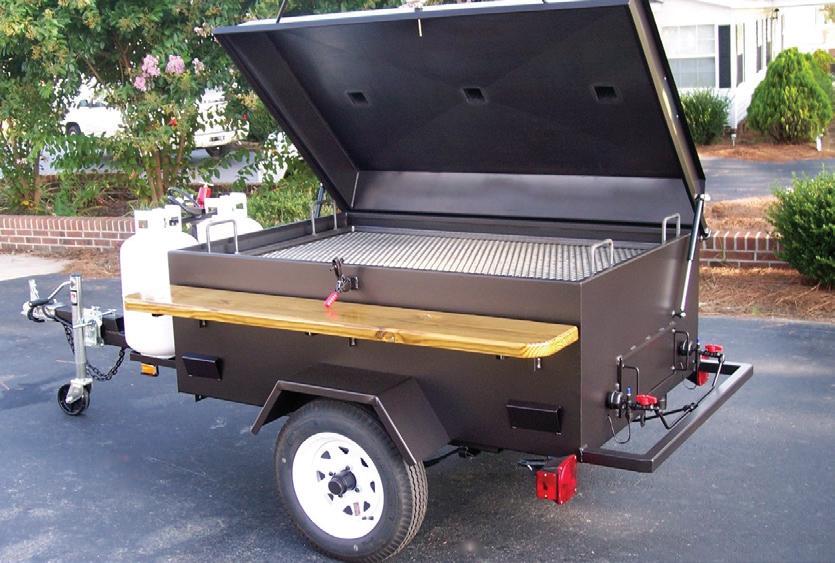
e MHX Rod Rack securely stores your rods, so they are ready at a moment’s notice. With an MSRP of only $229.95, you won’t nd a tougher, more versatile rod rack at such an amazing price. Shop for the MHX HD Rod Rack at mudhole.com today!
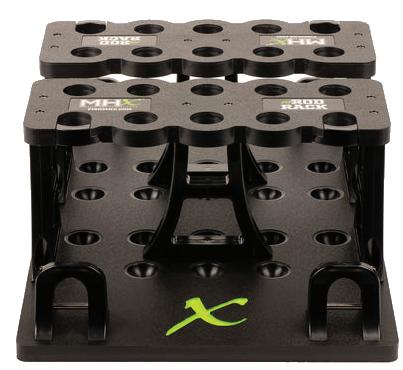

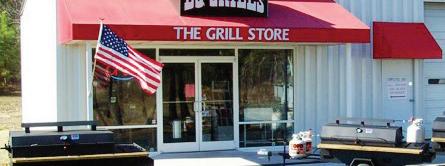

Berkeley County is a wonderland for outdoor enthusiasts, sports bu s, adventure seekers, and water lovers.



From exemplary fishing for striped bass, or a trophy largemouth bass, to our hiking trails and water activities, along with scenic outdoors where you can catch a glimpse of white tail deer and gators, Berkeley County has activities to fit all visitors and families.

Learn more about Berkeley County at: exploreberkeleycounty.com











